Artist Faheem Majeed’s new solo exhibition explores the impact and imperfections of the South Side Community Art Center.
 By KERRY CARDOZA 18
By KERRY CARDOZA 18

Artist Faheem Majeed’s new solo exhibition explores the impact and imperfections of the South Side Community Art Center.
 By KERRY CARDOZA 18
By KERRY CARDOZA 18
‘I don’t want to define space, I want to support it’
don’t see anti-Jewish attitudes all around, your eyes must be closed.
12 Isaacs | Culture The Pritzker Museum exhibits Bill Mauldin’s 50year fight with injustice.
04 Shop Local An unexpected flower movement is taking over neglected landscapes across town.

06 Transportation An epic bicycle ride across Indiana to Chicago’s nearest Waffle House
32 Festival The Chicago Japan Film Collective brings indie Japanese films to the midwest.
hosts an outdoor sound-art exhibit in partnership with the Busan Biennale.

Christopher Santoso, aka DJ and producer Please and Issa Party label founder
TO CONTACT ANY READER EMPLOYEE, E-MAIL: (FIRST INITIAL)(LAST NAME) @CHICAGOREADER.COM
PUBLISHER AND PRESIDENT TRACY BAIM PUBLISHER AND EDITOR IN CHIEF KAREN HAWKINS EDITOR IN CHIEF SUJAY KUMAR
MANAGING EDITOR BRIANNA WELLEN PRODUCTION MANAGER KIRK WILLIAMSON GRAPHIC DESIGNER AMBER HUFF
MUSIC EDITOR PHILIP MONTORO
THEATER AND DANCE EDITOR KERRY REID INTERIM CULTURE EDITOR SALEM COLLO-JULIN ASSOCIATE EDITOR JAMIE LUDWIG SENIOR WRITERS MAYA DUKMASOVA, LEOR GALIL, DEANNA ISAACS, BEN JORAVSKY, MIKE SULA SOCIAL JUSTICE REPORTING FELLOW ADAM M. RHODES EDITORIAL ASSOCIATE TARYN ALLEN
14 Protest Three stories from the front lines of the 2020 protests, when the bridges went up and the statues came down

18 Profile Artist Faheem Majeed’s new solo exhibition explores the impact and imperfections of the South Side Community Art Center.
22 Visual Art Elsa Muñoz undrowns her community with every painting.
34 Movies of Note Milkwater is a spectacular showcase for Molly Bernard, The Perfect Candidate captures a revolutionary moment, and Plan B is a Brown girl buddy comedy for the ages.
36 Galil | Feature How working remotely brought Fuubutsushi together
40 Records of Note This week the Reader reviews current releases by Mdou Moctar, Bachelor, Anthony Braxton, Hide, Nadja, and more.
43 Early Warnings Rescheduled concerts and other updated listings
FOOD & DRINK
08 Sula | Feature Vargo Brother Ferments chases the perfect pickle.

NEWS & POLITICS
10 Joravsky | Politics If you
26 Dance Chicago Dance Month returns for a ninth year.
31 Space Opera Chicago Shakes
offers a sneak peek of It Came from Outer Space
43 Gossip Wolf ÉSSO collect their pandemic output (and more) on one funky LP of Afro-Latin fusion beats, David Singer & the Sweet Science release a timely glamrock opus, and the Logan Center
45 Remembrance Bob Koester leaves a colossal legacy in Chicago jazz and blues.

48 Savage Love Dan Savage tells us why it’s deeply irrational to expect things to stay the same.
52 Jobs
53 Apartments & Spaces
53 Marketplace
DIRECTOR OF DIGITAL JOHN DUNLEVY SOCIAL MEDIA COORDINATOR JANAYA GREENE
STRATEGIC INNOVATION DIRECTOR MARIAH NEUROTH DEVELOPMENT AND MARKETING ASSOCIATE CHINYERE FARR-DOUGLAS MEDIA PARTNERSHIPS COORDINATOR YAZMIN DOMINGUEZ
EXECUTIVE ASSISTANT SANDRA L. KLEIN MEDIA PARTNERSHIPS AND DEVELOPMENT ADVISOR ABHIMANYU CHANDRA
ADVERTISING
312-392-2970, ADS@CHICAGOREADER.COM
CLASSIFIEDS:
CLASSIFIED-ADS@CHICAGOREADER.COM
VICE PRESIDENT OF SALES AMY MATHENY
SALES DIRECTOR AMBER NETTLES SENIOR ACCOUNT REPRESENTATIVES LENI MANAA-HOPPENWORTH, TED PIEKARZ, WILL ROGERS, LISA SOLOMON
NATIONAL ADVERTISING VOICE MEDIA GROUP 1-888-278-9866
VMGADVERTISING.COM
JOE LARKIN AND SUE BELAIR
DISTRIBUTION CONCERNS distributionissues@chicagoreader.com
312-392-2970
CHICAGO READER L3C
BOARD PRESIDENT DOROTHY R. LEAVELL TREASURER EILEEN RHODES
AT-LARGE SLADJANA VUCKOVIC
But that’s not all the Reader has to celebrate. The winners of the Peter Lisagor Awards were announced, and out of a record-breaking (at least in recent history) 13 nominations, sta ers and freelancers took home seven wins.
READER INSTITUTE FOR COMMUNITY JOURNALISM, INC.
CHAIRWOMAN EILEEN RHODES
TREASURER CAROL BELL
DIRECTORS ALISON CUDDY, VANESSA FERNANDEZ, KIM L. HUNT, JACKIE KAPLAN-PERKINS, DOROTHY R. LEAVELL, SLADJANA VUCKOVIC
READER (ISSN 1096-6919) IS PUBLISHED BIWEEKLY BY CHICAGO READER L3C 2930 S. MICHIGAN, SUITE 102 CHICAGO, IL 60616 312-392-2934, CHICAGOREADER.COM
COPYRIGHT © 2021 CHICAGO READER PERIODICAL POSTAGE PAID AT CHICAGO, IL ALL RIGHTS RESERVED. CHICAGO READER, READER, AND REVERSED R: REGISTERED TRADEMARKS ®
“IT HAS NOT been easy to be a mouthy Black lesbian feminist in journalism, and I’m thankful to the folks over the years who have believed in me, who have created space and opportunities for me, and who have kept pulling me back into the industry when I’ve left.”—KAREN HAWKINS ON RECEIVING THE STUDS TERKEL AWARD


















An unexpected movement is taking over neglected landscapes across town.
By ISA GIALLORENZOWhen we think about Chicago, lots of things come to mind—but not always a vibrant floral industry. It wasn’t always so; in the early 20th century this was known as “The First City of Flowers’’—a distinction made possible by a combination of factors, such as being located in the center of the country, having access to a railroad hub, and counting on plenty of labor and coal to fuel greenhouses. Even though things have changed since then, local flower farmers Quilen Blackwell and Cornelia McNamara believe we still have all it takes to reclaim that title. With two di erent ventures, they both share a love for repurposing, regenerating, and beautifying previously neglected lots. They also pivoted their businesses during the pandemic, since events were canceled and florists weren’t on demand. Despite that, thanks to new strategies such as CSA (Community Supported Agriculture) subscriptions, they found greater success now than in the previous years.
For Quilen Blackwell, 36, cofounder of the Chicago Eco House, it all started as a solution to a serious issue he saw in disadvantaged neighborhoods: lack of jobs. Originally from Madison, Wisconsin, Blackwell came to attend ministry school in Forest Park ten years ago. While tutoring at a high school in Englewood as part of his studies, he first interacted with abject poverty in Chicago: “All the kids and their families would talk about was [lack of] jobs. That was the impetus behind Eco

House—how we could basically use a lot of the existing assets already in these communities to create jobs for young people. But we wanted to do more than just create one-o jobs that didn’t really have a career track. We wanted to find something that could really bring in real industry in the community so that there could be careers for our youth. And that’s how we eventually landed on flowers.”
Blackwell established Chicago Eco House as a nonprofit in 2014 with his wife, Hannah Bonham Blackwell, 38, whom he met through church. Their headquarters, located in Englewood, double as the family home, where they live with their three young children. Being part of the community is an integral part of their success: “You gotta put your life where your mouth is,” Blackwell says. Their flower farm—run exclusively on green energy—is just down the block from their building, but additional farms have been opened in Woodlawn, West Garfield Park, and Washington Park. In the next two to three years, Blackwell plans on tripling that to at least 12 to 15 farms around the city.
“Our big goal is to eliminate the ghetto as we know it. What I personally think is missing is a bedrock industry,” he says. On July 1, Chicago Eco House will open Southside Blooms, their first storefront in Englewood. There they will be creating organic job opportunities for the youth trained in their programs. Blackwell mentions they recently got into a partnership with the Circuit Court of Cook County’s Juve-
nile Probation division, whose goal is to create a “prison-to-flower farm” pipeline. “Who would have thought that vacant lots, flowers, bees, and chickens would be drawing a lot of these teens so that we could provide a bit of respite from all the craziness they have to deal with every day in their lives?” he says.
Chicago Eco House has been so successful that they already sold out their CSA membership for this year ($250 for six bouquets, paid in advance). They o er blooms such as tulips, daffodils, Persian lilies, hyacinths, China asters, zinnias, sunflowers, and peonies. By summer they intend to add more products to their online shop, featuring items made in their community—those include recycled greeting cards, ceramics made from broken glass bottles, and honey; Christmas wreaths will be available in the fall. “We can’t offer flowers year-round, but we always have something for sale to keep our youth employed,” says Blackwell. Besides having a high social impact, their flowers are produced without any pesticides or chemicals—an exception in the environmentally degrading flower industry.
Also conscious about green practices is farmer and florist Cornelia McNamara, 49. “We are composting all of our organic waste with Healthy Soil Compost, whom we trade services with. But the biggest thing we do to reduce our carbon footprint is growing our flowers rather than importing them from other continents.” Growing her own blooms gives McNamara more options as well. A sea-

soned florist hailing from New York City, and the daughter of the late Omie Daniels, who once managed the now legendary Green Inc. plant and flower store in Old Town, McNamara has dedicated her life to flowers: “I’m used to working with flowers from the best farms and greenhouses on the planet, so I have the advantage of really knowing what a premium flower is.” Being taken on a farm tour with her is like visiting a garden of delights, immersed in breathtaking views, fragrances, and even tastes. McNamara proudly presents her blooms, which include ranunculus, anemones, and peonies in the spring, lisianthus, poppies, and clematis in the summer, and dahlias, hydrangeas, and grasses in the fall.
During the pandemic she had extra time to dedicate herself to Five Row Farm, a former parking lot that borders Garfield Park and West Town, provided by the S&B Finishing Company. “Finding growing space has been a very difficult and painful process. Farms are not made to be moved, but we have had to move farm sites four times,” she says.
McNamara started farming in 2008, with the help of family friend Michael Thompson, who founded the Chicago Honey Co-op. Her dream is to create a permanent flower farm in Chicago, which will serve the city as “a floral folk school and sanctuary.” In her promotional video, she says, “It’s a vision that I can see in my head and I think we’re going to be able to make it happen. I’m thrilled!” v
dent Daniel DiBenedetto, 16, is on a crusade to change that. He launched the Twitter feed Waffle House in Chicago Movement (@WHinChicago), with over 450 followers, “because I went on vacation to Florida and we tried Wa e House, and it was so good.”

The Onion gag crossed my mind again earlier this spring, and I did a little research and found the closest Wa e House to City Hall is a 196-mile direct bicycle ride away in Avon, Indiana, a western suburb of Indianapolis. “Who’s going to go for the gold and make that trip?” I asked on Twitter.
Of course, I already knew the answer. And when a buddy invited me to his bachelor party this month at another friend’s summer house in the Indiana Dunes, roughly on the way, that sealed the deal.
Wolf Lake. The misty night is lit up by steel mills and casinos, and it’s spooky in a good way.
Using the Northwest Indiana bike map, I navigate southeast on the Erie-Lackawanna Trail, and then east on the Oak Savannah, which is heavily wooded and dark. At one point a deer crosses my path.
By the time I’m pedaling northeast on the Prairie Duneland Trail towards Beverly Shores, it’s 1:30 AM and I’m getting a little delirious. When I arrive just before 3, my friends applaud from the porch, and it’s definitely time for me to hit the hot tub.
The bachelor party weekend is a PG-13 rather than X-rated a air, fi lled with beach hikes, homemade pizza, guitar jam sessions, and soft drug use by my companions. On Monday morning it’s time to leave the lakefront for my 104-mile ride to West Lafayette, the home of Purdue University.
What is it about the Atlanta-based Waffle House chain that makes many Chicagoland residents wish the 24-hour greasy spoons existed here?
It’s not high-quality food. From the yellow homogenized vegetable oil spread used instead of butter, to the half-centimeter-thick rubbery wa es, just about everything served is the cheapest, most heavily processed version available.
Yet I’d argue Wa e House fare is kind of its own thing, and tasty. Menu items are generously customizable, and I like the arcane language used for pimping hash brown orders: “scattered,” “smothered,” “covered,” etc.
I also appreciate the cheerful midcentury logo and decor. And it’s satisfying to watch the grill cooks doing skilled, e cient triage during busy times.
But in a Parts Unknown segment, Anthony Bourdain eloquently nailed what makes Wa e House special. “Its warm, yellow glow a beacon of hope and salvation, inviting the hungry, the lost, the seriously hammered, all across the south to come inside. A place
of safety and nourishment, it never closes. It is always, always faithful, always there, for you.”
Back in 2005, the Onion ran the clever headline, “Mason-Dixon Line Renamed IHOP-Waffle House Line,” a play on the fact that the latter’s 2,100+ locations are concentrated in southeastern states. But in reality, there are a number of Yankee Wa e Houses—the northernmost appears to be in Austinburg, Ohio, near Ashtabula.
So why are there no Wa e Houses in the Chicago area? A spokesperson for the chain didn’t immediately respond, but I’ve got a couple theories. This sophisticated northern metropolis might not be an ideal market for the chain’s down-home cuisine, which includes southern accents like grits, sausage gravy, Texas toast, pecan wa es, and sweet tea. And maybe Chicago’s 24-hour dining niche was already fi lled by the many “Golden” coffee shops, including “Nugget,” “Apple,” and “Angel,” not to mention our many awesome late-night taquerias.
But northwest-suburban high school stu-
I asked Wa e House if they’d sponsor my ride as a fundraiser for a righteous Chicago community development nonprofit. “We are flattered that you considered us as a potential partner,” said spokesperson Njeri Boss. “We do wish you . . . much success in your endeavor, but we are going to decline the opportunity.” Maybe the bachelor party part scared them o ?
Nevertheless, on Friday, May 14, after work, I depart my home in Uptown for the 70-mile trek to the summer house in Beverly Shores. It’s going to be a late night, but about 80 percent of the route is on bike paths.
The Lakefront Trail is packed, and I’ve got a warm headwind out of the south, but the weather is so gorgeous I don’t mind. By the time I reach 63rd Street Beach, my stomach is growling, so I detour south on Jeffrey Boulevard into South Shore towards a dinner destination.
When I stop near 71st to admire a mural of jazz musicians by artist Marcus A, a friendly woman says hello and hands me a business card for the controversial Japanese Buddhist organization Soka Gakkai International. Coincidentally, I know all about the group, having previously written about the monument to SGI president Daisaku Ikeda on public land in Uptown’s Peace Garden.
At dusk in the South Deering community, I stop at Hiene’s Shrimp House, an iconic shack equally famous for its fried chicken, and pick up a delicious yard bird dinner.
I ride 112th across the Indiana border, then roll south on a long causeway path across
Indiana is the less urban, more conservative mirror image of Illinois, and as I zigzag southeast on farm roads, the scenery soon resembles a typical Prairie State landscape. But Trump signs and “Don’t Tread on Me” banners are more prevalent, and in one careworn small town, a house on Main Street has a large Confederate flag in the window.
I stop for lunch by Dunn’s Bridge over the Kankakee River. The curved span was reportedly made with steel beams salvaged from the original Ferris wheel, which debuted at Chicago’s 1893 World’s Fair.
At dinnertime, I visit the Whistle Stop in Monon, a restaurant surrounded by vintage railcars. The special of ham steak with au gratin potatoes would hit the spot, but sadly the place closed hours earlier. Instead I grab a breaded pork tenderloin, an indigenous Indiana sandwich, from a Casey’s convenience store.
I don’t have a bike map for this part of the Hoosier State. At sunset when Google Maps once again steers my relatively skinny-tired touring bike onto a farm road with coarse gravel, I’ve had enough. I backtrack to Route 421, the main highway to West Lafayette, where, infuriatingly, the paved shoulder is occupied by a rumble strip, so I can’t ride in it. Following a couple hours of dodging trucks, at 1 AM I arrive at my cheap motel exhausted, but thankfully in one piece.
After a good night’s sleep, it’s time to fuel up for my 86-mile day ride to Avon and Indy. West Lafayette’s famed, oxymoronically named Triple XXX Family Restaurant, known for homemade root beer, is closed on Tues-
days. Instead I get a toothsome savory crepe and fresh-squeezed OJ at nearby Greyhouse Coffee. As I’m eating outside, I spot some familiar Celtic-inspired flourishes on the tiny brick bank next door and correctly guess the structure, the Purdue State Bank Building, was designed by Chicago’s Louis Sullivan.
I roll across the Wabash River into Lafayette proper, featuring the stately Tippecanoe County Courthouse, and many other beautiful old buildings. The highlight of the rest of the ride is the lovely, lilac-lined Farm Heritage Trail, winding about 15 miles between Colfax and Lebanon.
During the last several miles into Avon on trails and subdivision streets at twilight, I eagerly anticipate the feast that awaits me. Then suddenly the Wa e House appears like a lighthouse in the night, looking exactly like every other branch I’ve visited on southern road trips.
Vaxxed, I belly up to the counter for my first sit-down dinner since COVID-19 hit Chicago. I order hash browns “all the way,” that is, with onions, American cheese, ham,
tomatoes, jalapeños, mushrooms, chili, and sausage gravy; topped with fried eggs; plus a pecan wa e and co ee. I devour almost all of it, a meal worth riding 260 miles for.
College student Dylan Fields, sitting with

friends after bowling, agrees to snap my photo outside the diner. When I reveal I’ve ridden all the way from Chicago just to visit this Wa e House, he cracks a huge smile. He later tells me, “At fi rst, I was like ‘This guy is

joking,’ but when you explained your story I was amazed. The trip required a lot of determination and is such an awesome story.” It’s heartwarming to get a hero’s welcome for completing my rather ridiculous mission.
The last 12 miles to downtown Indy on high-speed roads are nothing to write home about. But it’s transcendent when I roll up around midnight at Monument Circle, a block from my hotel. The next morning I’ll drop o my steed at the nearby Bicycle Garage shop for shipping and catch Greyhound home.
Looming before me is the 1902 Soldiers and Sailors Monument, a 284-foot neoclassical limestone pillar, flanked by statues and fountains. The crowning touch is a 30-foot bronze female fi gure of Victory, holding a sword and a torch, with an eagle perched atop her head.
Some people unfairly dismiss Indianapolis as “Nap Town,” a boring backwater, but there’s no public space in Chicago quite that grandiose. On that inspiring note, my Indiana odyssey comes to a close.
nary school at Le Cordon Bleu and throughout his stints on the line at Grange Hall Burger Bar, Girl & the Goat, and Schwa. But an epiphany occurred when he was working at Dixie, under chef Tony Quartaro.
“We got a batch of white peaches in for a country ham with ricotta dish, and they were underripe so we couldn’t really use them. [Tony] said, ‘Let’s make vinegar.’ He threw them in with some water, a little bit of sugar, and let them sit. After three to four months he showed me the mother was forming. That really sparked my fascination with fermentation, the vitality it brings, the health benefits, and the fact that you could throw a grape into a brine and it would be untouched and pristine in appearance a year later.”
This is about when he mounted his quest for the perfect salt-brined pickle. In salt brining versus vinegar-based pickling, helpful bacteria digest the sugar in the vegetables, releasing lactic acid. The presence of these probiotics and the enzymes they produce make for tangier and more interesting flavors than those of shelf-stable vinegar-and-heat-pickled “dead” varieties—which also have none of the qualities that make them so good for the gut.
Sebastian Vargo doesn’t want to come o like a snake oil salesman, but he is very much an evangelist for the power of pickling.
“I think that fermented foods have changed lives,” he says. “My form of love and expression is just being able to give that to the community.”
Vargo is the brother behind Vargo Brother Ferments, which has been churning out a prodigious variety of lacto-fermented pickles, krauts, kimchi, condiments, and kombuchas

since last summer when the furloughed chef and his fiancée started selling his signature garlic dill pickles on Instagram, @vargobrotherferments. What later became known as the “G-Dilla” is an extraordinarily crunchy, sour pickle suspended in a cloudy salt-brine teeming with probiotics.
“I did work hard for that crunch,” he says, also crediting the tannins in the brew, lent by black tea, bay, and grape leaves. “You gotta build a foundation, like making a stock. I approach my pickles the same way I would any
dish.”
Vargo received an early fermentation indoctrination growing up in suburban Detroit, where his mother led regular forays to the area’s classic Jewish delis. “It was too much meat for me as a kid,” he says. “It was these stacked high sandwiches and these half and full sours. My first time having a salt-brined pickle was so di erent than Vlasic and everything else. And I have nostalgia too: really good memories of us all being together.”
It stuck after he moved to Chicago for culi-
Vargo was the head chef at Logan Square’s Merchant, and his fiancée Taylor Hanna was cooking at the Ace Hotel when they were furloughed last year. They dabbled in the pandemic microeconomy at first, making bagels or T-shirts, but they eventually settled on ferments. Live cultured foods are still relatively rare on store shelves, and “I wanted to give people a product that they can’t really find in stores. A lot of people just don’t recognize the average jarred pickle or kraut is pasteurized, and in essence, dead food. I saw a lack of selection, and the selection that was available was lacking in diversity, so I wanted to also bring my experience to some well-seasoned chef-driven ferments,” he says.
These have included his PowerKraut, with cabbage, Thai basil, jalapeños, pickled mustard seeds, turmeric, ginger, and garlic; a nuclear horseradish mustard; and a silky smooth variant of the Middle Eastern garlic spread called toum. There’s been pickled baby bok choi with Thai basil and galangal; brussels sprout-radish kimchi; ginger-turmeric beer and pineapple-lemongrass kombucha; Bulgarian-style yogurt parfaits
butter and fermented strawberry jam; ramp hot sauce; chipotle beat-kraut, and tomato vinegar. There’s a new and nearly different drop each week, exchanged for “suggested donations” via Instagram—but always the garlic dill pickles.

Like most chefs, Vargo and Hanna are looking forward to what the summer will bring to pickle, but they’re not looking to go back to restaurant kitchens. They say they’ll do what they have to do to pay the bills, but the priority is to go big—or bigger—with ferments. They’re working with the food business incubator the Hatchery to set up a permanent commercial kitchen with a HAACP plan by mid to late summer, and then start stocking local store shelves with Vargo Brother Ferments. For now, there are ongoing collaborations
with the likes of alt-economists @haveagoodsandwich and @funeral.potatoes, and this Saturday at noon they’ll make the scene @welcome.2.thee.jungle’s pop-up market at Haddon and Campbell.
After that, a deli? Well, something. “Possibly a commissary stocking our friends’ products as well as having a space where people can come together. Maybe a little bookstore where we host local artists, writers, producers. A space for everyone, that’s what we want. If you can’t uplift community while you uplift yourself, then I think you have to find a way to do both. It’s all about mutual aid. And I think to have a healthy gut biome is pretty punk. It’s pretty anti-capitalist.”
@MikeSulaOn a drive with Mr. Badii in his tan Land Rover, silence grazes our ears, leaving our mouths half open; our throats letting out small clearings. The roads ahead wind into Möbius strips. Mr. Badii’s hands loosely grabbing the wheel. I look to the Rover’s tinted windows, wondering if we appear like Schrodinger’s cat to other drivers, but I know it is the Ostrich Syndrome holding my silence when he asks me to pour twenty spadefuls of earth on his body in a hole he dug. On a street discreet as our intent, searching for Mr. Badii’s perfect burial, the lakefront’s scent curls around us, retreating me to sore summers. The tension I developed against water after a friend drowned. A pack of boys tightly bound as a tin of sardines. The soda-cans in brown paper-bags we carried to give us the mysticism of winos. Weight of Slaughter and Son Funeral Home sign tugging at our collars: [A Death Has Occurred Or Is Near]. The brown and orange liquid we poured on fish combed by waves to shorelines. Their bodies braised by seagull beaks, eyes sinking into their skulls. We stuffed half-lit loose cigarettes inside them so their musk would not offend our noses. “I don’t want to give you a gun to kill me; I’m giving you a spade,” Mr. Badii says. “Just pretend you’re farming and I am manure to spread at the foot of crops.” We reach a stop-light. My eyes expand to the bus that ran over the neighbor’s daughter. The mother running to scattered limbs, attempting to sew back the severed child. I stared in wonder, thinking it was possible. “This city is a burial— why do you choose to live?”
Cheswayo Mphanza is the author of The Rinehart Frames.
Poem curated by Xandria Phillips: Xandria Phillips is the author of HULL (Nightboat Books, 2019), and the recipient of a Whiting Award. They have received fellowships from Brown University, Oberlin College, and The Wisconsin Institute for Creative Writing, and are the 2021-2023 Poetry Fellow at the Center For African American Poetry and Poetics.
A biweekly series curated by the Chicago Reader and sponsored by the Poetry Foundation.






Gwendolyn Brooks Youth Poetry Awards
Open to young people currently in kindergarten through 12th grade across the state of Illinois
Details at ILHumanities.org
Deadline: May 31, 2021
It was over 30 years ago, but I still remember it well—a gaggle of teenagers had taken to spray-painting gra ti on factories, garages, and houses in my neighborhood.
As a result, several earnest and well-intended neighbors convened a meeting so that residents who heretofore had barely known each other could settle on some collective action to stop the tagging.
One resident opined that a few taggers lived in a nearby apartment. Another person suggested we pressure that building’s landlord into holding his tenants accountable. Then he asked: does anyone know who that landlord is?
To which a third neighbor scornfully replied: “Some old Jew.”
So much for collective action.
As a Jewish American who’s lived among white gentiles my whole life, I must tell you—it’s an old story. You just never know when some anti-Jewish poison will gush out of someone’s mouth.
I take this not-so-pleasant excursion down memory lane to send a larger message to my beloved lefties who instinctively deny that there are those among them who have—oh, how to put this?—complicated attitudes about “the Jews.”
Oh, lefties, lefties, lefties. You know I love you. I even stand with you on many matters of Israel and Palestine. For what it’s worth—and I know it’s not worth much—I think Netanya-
hu stirred up the last few weeks of senseless violence to seal his reelection and hold o an investigation that might otherwise send him to jail. And if it was up to me, there would be one state. With Jews and Muslims and Christians living in harmony. As hopelessly naïve as that sounds.
That said . . .
When it comes to your denials about anti-Semitism in your ranks, you’re starting to sound like Mayor Rahm with the Laquan McDonald video.
I see nothing. I hear nothing. I know nothing.
Only in this case, it’s more like—anti-Semitism on the left? How dare you even suggest such a thing! Our opposition to Israel stems strictly from our support for Palestinians and our opposition to war crimes.
Yeah, yeah, yeah. Who are you kidding— other than yourselves?
Look, most of the folks I know on the left are wonderful people who don’t have a shred of anti-Semitism in them.
But, no anti-Semitism on the left? C’mon, lefties—do you live on Mars? Do you not hear and see all the things that you’ve been hearing and seeing your whole life?
I mean, if I’ve heard this shit, you’ve heard it, too. Probably last November at Thanksgiving.
Let’s go back to that out-of-the-blue comment from my neighbor back in the 80s. It was classic anti-Jewishness—clumping a large and diverse collection of people into one giant so-
cial stereotype. So it’s easier to ridicule, marginalize, ignore, and ultimately, hate them.

If I had to count which racial, ethnic, or religious group in America gets this treatment the most, it would be Black Americans. By far.
As in Donald Trump saying “MAGA loves the Black people.” Like the Black people is a single thing, not a group of di erent people.
In second place comes Jews. Followed by Muslims. Then Mexicans. And then—oh, you make your own count.
Sometimes the bigotry is cloaked in praise. Like—Jews are smart. Or—Jews are good with money. Or—Jews take care of their own. Or—if you want a good lawyer, hire a Jew.
Man, I could write a book about the infatuation many gentiles have regarding Jewish people who are lawyers. It’s like the Jews came out of the womb citing the municipal code.
And that’s the “nice” stu people say about Jews. As opposed to the real nasty stu about Jews being an evil cabal that rules the world.
So, pretending that anti-Jewish bigotry doesn’t filter into the take that some leftists have on the Middle East is positively Trumplike in its delusion.
By the way, I’m not suggesting that anti-Jewishness exists only on the left. I can go on and on about the bizarre attitudes of Congresswoman Mary Miller toward Hitler or Marjorie Taylor Greene likening the Nazi slaughter of Jews to making people wear face masks in a pandemic.
In a twisted way, it’s almost funny to watch the contrasting reactions of the right and the left to acts of violent anti-Semitism.
If it’s violence from the right, right-wingers will start talking about their deep and abiding love for Israel. In other words, they love Jews, so long as Jews are living on the other side of the world.
As for lefties? It’s like they don’t know what to say without looking to their Twitter feed for talking points.
If the violence comes from a Nazi—like the shithead who killed 11 people in the L’Simcha Congregation synagogue in Pittsburgh— lefties may issue a statement denouncing anti-Semitism.
Provided, of course, it’s broad enough to include love for all minorities.
And if the violence comes from a bunch of thugs waving a Palestinian flag—like the thugs who beat up Jews outside a sushi restaurant in Los Angeles just a few days ago—it’s the sounds of silence.
Apparently, lefties aren’t sure if standing with Jews who get beat up by thugs waving a Palestinian flag will make it look like they’re abandoning their allegiance to the people of Gaza.
I asked one leftist friend if he intended to tweet anything about that attack in LA, and he said: it’s complicated
That was a howler, seeing that the trending response to people who had conflicted feelings about bombing Gaza was— it’s not complicated
You’d think that beating up people on the streets of LA would also fall into that same it’s-not-complicated category.
I was heartened to see Congresswoman Alexandria Ocasio-Cortez tweet out an unambiguous denunciation of anti-Semitism. So, there’s hope.
I see other parallels between the right and the left when it comes to the Middle East.
With MAGA’s support for Israel, I have to wonder if they care about Israeli Jews or just hate Muslims. And with the left, I have to wonder—do they love Palestinians or just hate Jews?
Only you know what’s in your hearts, people. v @bennyjshow
If le ies or right-wingers don’t see anti-Jewish attitudes in their ranks, it’s because they have their eyes closed. RYOJI IWATA / UNSPLASH
If you don’t see anti-Jewish attitudes all around, your eyes must be closed.
BEN JORAVSKY
















Editorial cartoonist Bill Mauldin, whose bedraggled “Willie and Joe” characters famously represented the lowly “dogface” foot soldiers of World War II, won two Pulitzer Prizes, the first when he was only 23. He didn’t win for his best-known cartoon, however. That would be the despondent Lincoln, head on hands—a caption-free twist on the D.C. memorial that was published by the Chicago Sun-Times along with the news that President John F. Kennedy had been assassinated. Mauldin was also a master at captions, but in this case, none was necessary.

Did you know all that?
I’m asking because the Pritzker Military Museum and Library, which owns a major Mauldin collection, has opened a retrospective featuring 160 images, most of them original drawings, and 20 artifacts. Titled “Drawn to Combat: Bill Mauldin and the Art of War,” it’s being promoted with the once-unthinkable question, “Who is Bill Mauldin?”

For those who actually don’t know, the show will be a strong introduction. And for those who only remember him for Willie and Joe, it’ll be a reminder that he went on to have a near
50-year, nationally syndicated career that spoke truth to power and championed every kind of “little guy” in the face of injustice. Chicago figures both early and late in that career. Born in New Mexico in 1921 (Native American on his father’s side, ancestors in the American Revolution on his mother’s), Mauldin was a feisty, precocious runt of a kid who was said to be reading Mark Twain at the age of four and drawing before he talked. He finished high school, living on his own after a hardscrabble early childhood, but, thanks to a classroom prank, failed to get a diploma.
In 1939, with $500 borrowed from his grandmother, he arrived at the Chicago Academy of Fine Arts, intending to learn all he needed to know to become a successful cartoonist in the single year it would take for his money to run out. He wound up mostly focused on the portraiture and fine-art techniques that would lend his cartoons their signature impact.
Lacking any job prospects after that year, Mauldin joined the Arizona National Guard which, in the run-up to America’s entry into WWII, was quickly mobilized. He immediately began contributing cartoons that featured
the enlisted man’s perspective to the division newspaper, and by 1941, cartooning was his full-time Army job. In 1943, when he su ered a minor wound that got him a Purple Heart, he was on sta at the Armed Forces flagship publication, Stars and Stripes; a year later, his cartoons were taken on by a major syndicator for distribution to newspapers in the U.S. Mauldin’s depiction of the war as a muddy, bloody slog for enlisted troops under the thumb of fat-cat officers ran afoul of Army brass, including General George Patton, who wanted to toss “the little son of a bitch” in jail. But in 1945 a Mauldin cartoon that showed “victorious” American troops every bit as downtrodden and war-weary as their enemy prisoners won a Pulitzer. That same year, Up Front, his book about the war, became an immediate best seller. He came home a hero. He would subsequently be criticized, and dropped from newspapers, for work that was perceived to be too far left—opposing the McCarthy hearings, for example. During an unsettled decade or so after the war, he acted in a movie (John Huston’s The Red Badge of Courage ) and ran an unsuccessful campaign
for Congress. But by the spring of 1958 he was on sta at the St. Louis Post-Dispatch, and a cartoon he drew that fall, critiquing the Soviet Union for barring novelist Boris Pasternak from accepting his Nobel Prize, won another Pulitzer. In 1962 Mauldin returned to Chicago, signing on with the Sun-Times. He was a regular presence on its editorial pages through 1990, when the paper declined to renew his contract.
Mauldin led a frenetic, often troubled personal life that included three wives, two divorces, and eight children. (This exhibit might send you, as it did me, to his books or to Todd DePastino’s biography, Bill Mauldin: A Life Up Front, which is on sale at the museum.) A year after his “retirement” from the Sun-Times , while attaching a snow plow to his Jeep, Mauldin crushed his drawing hand (the left), making further work di cult. Then, in 2000, suffering from Alzheimer’s, he essentially cooked himself in a bathtub. He lived for three years after the scalding, but never recovered. When Mauldin died, in 2003, longtime Reader columnist Michael Miner wrote that some of his best work had been done not for the Sun-Times , but for the tiny Chicago Journalism Review—a watchdog publication launched by local reporters outraged by their own publications’ censorship of their coverage of the 1968 Democratic convention police riot. Mauldin’s numerous covers for CJR included a response to the 1969 Black Panther raid by Chicago police: a door riddled by bullet holes that form a swastika. Miner reported that CJR ’s founding editor, Ron Dorfman, said this cartoon was “every bit the equal of his weeping-Lincoln image after the Kennedy assassination.”
Judge for yourself: the Lincoln image, along with the two Pulitzer winners and much more are on view in “Drawn to Combat.”
“Drawn to Combat: Bill Mauldin and the Art of War,” through spring 2022, Pritzker Military Museum and Library, 104 S. Michigan, Tue-Sat 10 AM-4 PM, $10; $8 for seniors, students, and teachers; free for kids under 12, first responders, and active military.
@DeannaIsaacs




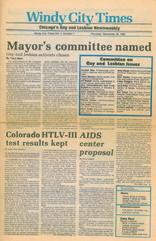


Just after 6 PM on August 15, 2020, the sun was beginning its descent in the gray sky. The air was humid and the pavement, wet from rain, radiated heat. The o cers marched in lockstep south on Michigan, many unmasked, wearing the same black bulletproof vests and light blue riot helmets, banging batons on their thick shields. Their boots pounded the pavement in synchrony. They screamed “Move back!”

The few hundred protesters retreated to the intersection of Randolph and Michigan, three long city blocks south of where they first collided with police. One organizer chanted into a megaphone. “Let’s go!” they said, pointing west on Randolph. “I believe!” they shouted. “That we will win!” the crowd responded.
The line of police officers followed. Why weren’t they stopping? They stalked steadily,
deeper and deeper into the heart of the Loop, insatiable in their pursuit. The maze of tall buildings and narrow alleys were sure to trap anyone who dared to attempt an escape. The protesters reached Randolph and State and were surrounded by bike marshals, those trained to help guide the crowd and keep them safe. The marshals used their bodies and bicycles as a wall between the protesters and the police.
After the crowd journeyed west on Randolph, some turned south on LaSalle. Then it happened. In front of City Hall, the wave of officers solidified, slamming against the protesters, shooting pepper spray on anyone who resisted the tide. The screams bounced o of the tall buildings and echoed through the Loop.
Throngs of protesters fell to the ground, many blinded and crying out in pain, while
those standing struggled to protect them from being crushed. Others ran.
Kettling is a violent and dehumanizing strategy used to divide and conquer a crowd. To be kettled is to feel like an animal being corralled and subdued. You have no agency over your body. You move with the force or get trampled.
I was inside this crowd. I had already put my camera in my bag and pulled my protective glasses onto my forehead as the lenses fogged up. The unusually strong pepper spray had splashed onto my face and hands and seeped through my clothing. I worked alongside strangers to pick up a protester who had fallen to the ground after being drenched in pepper spray. I remember the screams and the faces of those around me, all of us unable to comprehend what was happening.
My hands were numb from the pepper spray for days after. Some protesters would tell me they could feel the burning for the next week.
Since May 2020, I had spent hours reporting on protests across the city. I followed young activists who refused to stay home
in a pandemic because they dreamed of a better Chicago. The dozens of organizers, protesters, and journalists I spoke to about the summer said what was happening didn’t feel real, like we were in some kind of otherworldly, apocalyptic scene. So many times, even I thought, this can’t be happening again.
It’s the Reader ’s policy to blur the faces of protesters in photos and avoid publishing identifying details in stories. China Smith, Jennifer Nava, and Naira, the three organizers featured in this piece, are well known and consented to being in this story. One year after the uprisings began in Chicago, many are still processing the trauma of the summer. Many are still trying to heal.
China Smith’s hair is often in long braids done by their own hands. They wear handcrafted jewelry made by themself or other local artists. The 19-year-old is also a poet who does oracle and tarot card readings. On May 30, they expected the protest in the Loop to be filled with those mourning George Floyd and the countless others who had lost their lives at the hands of police.
They traveled north by bus from their home in South Shore with two friends. It felt good to be with people for the fi rst time in months, to be with friends who cared for them and the movement. “I was dealing with a lot,” they told me. “But I was so passionate about what’s going on that I was just like, ‘Nah, I need to throw myself back into this.’”
Downtown was bustling with masked protesters. The first thing Smith noticed was that although there were people of all ages, most were in their teens and early 20s. They took over streets, squares, and bridges, chanting passionately, making their presence known, and refusing to be overlooked. As they gathered near Federal Plaza, protesters delivered speeches about the fight against police brutality and for liberation. They held a moment of silence for nine minutes and 29 seconds, the amount of time it took former Minneapolis police o cer Derek Chauvin to murder Floyd.
Smith remembered one of the poems that was performed. “It really made me feel alive,” they told me.
A caravan of cars arrived from Little Village, bringing with it hundreds of protesters who joined the marches on foot. Some cars continued to drive through the streets, honking and waving signs from their windows.
Smith looked for more friends in the crowd. It had been years since the high school senior started attending protests. They received guidance and mentorship on organizing from GoodKids MadCity, a Black and Brown youthled organization which focuses on combating gun violence. “It really felt empowering to be around them,” they said. “They really helped me feel grounded in heated moments like this.”
Smith was on the front lines and felt the pressure to keep people together as they began to hear about an increased police presence. “Imagine like, literally being like fresh out of high school,” they said. “Even though there’s other young people, they’re still people who don’t know you. It was just really intense. I felt that really, really deep need to just protect everybody around me.”
While the notion of unity was very much alive in spirit that day, the protests were divided across the Loop. Complicating matters even more, phone signal was spotty. Protesters would occasionally see a post on social media or get a message from a friend, but it was nearly impossible to keep track of where people were and the size and intensity of the police.
Smith said something felt strange. A mob of o cers would stand nearby, observing and following protesters. Then suddenly they’d leave. Then, in another part of the Loop, they would appear and watch and follow other protesters. They hunted like this the entire day.
The protesters eventually convened near the Trump Tower. Police created a perimeter around the skyscraper and the neighboring buildings. (Months later messages surfaced revealing that Eric Trump thanked Mayor Lori Lightfoot for ensuring the protection of the tower.) The o cers closed in on the hundreds of protesters on the bridges leading up to the tower. Once again, the crowd was splintered into smaller groups. Smith was pushed and grabbed. They lost their footing as they wrestled with police o cers to break free. In that moment, Smith came to a painful realization: the o cers looked like them.
“I really saw a lot of Black and Brown officers. It really struck deeply,” they said “Because we’re out here fighting for the movement, we’re trying to defund CPD, and I’m just looking at people who look like me.” They continued. “I always wonder when will certain people come to the right side of the movement, or when will certain people wake up and realize why this movement is so crucial. It was like another fire was already lit under me.”
The police o cers pressed forward, forcing protesters o the bridge and farther away from the tower. In only a matter of minutes, the situation had intensified. The o cers who hours before were only observing were now kettling protesters, hitting them with batons and pepper spraying them. Those whose phones weren’t dead and had signal received a notice that CTA was shutting down. (For months, when discussing that day, you would get the question: How did you get out?) The bridges were up, highway and Lake Shore Drive exits blocked, Divvy bikes full, rideshares scarce and with fares surging to over $100. How was anyone supposed to get out?
It was utter chaos. Smith panicked and scrambled to fi nd their friends. The looting began. Police cars were everywhere.
“We felt like we had just become protagonists on some weird TV show where we don’t understand the dystopia . . . a lot of things just felt like a dystopia,” said Smith. “To this day, it really just was like, yeah, this is what’s going on. This is the life that you’re living. This is how life is, this is reality, and it was just so sad, because we’re fi ghting for some-
“I really saw a lot of Black and Brown officers. It really struck deeply. Because we’re out here fighting for the movement, we’re trying to defund CPD, and I’m just looking at people who look like me.”
—China Smith
continued from 15
thing good. And we were being harassed and tortured.” While escaping proved to be nearly impossible, simply being idle was also dangerous. They would eventually contact a teacher who picked them up, but as Smith waited for a rideshare driver to accept their request, their conscience weighed on them. They had friends who had been arrested and they didn’t know where they were, and they were still in pain.
“This action [was] a super heavy reminder that you’re still Black,” they said. “You’re still a woman, you’re still a young person, and that you’re still going to be treated with the same amount of violence no matter how you approach police.”

Jennifer Nava began organizing in middle school, when she fought to have a playground built in the empty space outside her school and to remove police and school resource o cers from the building. But if you had told the 19-year-old that she would be among the mass of young protesters who were brutalized for attempting to remove a statue of Christopher Columbus, a symbol of America’s racist roots which had sat in Grant Park since 1933, she might have laughed at you.
On the hot evening of July 17, Nava and hundreds of others gathered around Buckingham Fountain in Grant Park for the Black and Indigenous solidarity rally, organized under the hashtag DecolonizeZhigaagong. There were whispers that the Columbus statue would be taken down. A naturally welcoming person, Nava cautioned friends who wanted to join protests because of her deep-seated distrust of the police. “It’s all of these extra steps of precaution and always being on guard now, every time you see a cop, it’s just instant,” she told
me. “If there’s a bowl of Skittles and half of them are poison, you’re not gonna grab a handful and hope for the best. No, you’re just not gonna grab any at all. You’re not going to trust any of them.”
A stage was constructed in the space between Columbus Drive and the fountain. The long list of speakers and performers included rapper and prison abolitionist Ric Wilson and members of GoodKids MadCity, Brave Space Alliance, and Chicago Alliance Against Racist and Political Repression (CAAPR). The march began south on Columbus behind a collection of banners, some nearly six feet tall and spanning six or more bodies, with the messages “Defund CPD,” Black Lives Matter,” and “F12” (which translates to “fuck the police”). Some laughed as they moved their bodies to Megan Thee Stallion’s “Savage.” Others seemed unusually on edge.
The swath of protesters turned left off of Columbus and into Grant Park. They moved as one unit, playing music and chanting, and ascended the hill to the statue, which had been cloaked in a protective tarp since the end of June, for “protection” and to “discourage vandalism.” Police o cers, holding their bikes, surrounded the statue.
Nava knew what was coming next. The police would not allow them anywhere near the statue. “When stu escalates, a lot of times, the organizers that are there, they’re like, ‘OK, the youth are pulling back. We are leaving when things escalate.’ But this was like, ‘No, we’re standing our ground, this is the moment to stand your ground.’”
A group of protesters broke through the large banners and rushed up the hill. Others swarmed a shopping cart filled with cans, and threw the projectiles at the police officers
guarding the statue. In retaliation, the police o cers began hosing down protesters with pepper spray. The fumes were inescapable. Even those who weren’t hit directly choked on the airborne particles, which penetrated face masks.
Nava couldn’t see or breathe. Police had descended upon the crowd and swung their bikes and batons wildly, in search of any human target. Everywhere Nava turned she saw people her age and younger writhing on the ground gasping for air. There were far too many injuries for medics to treat.

When the police relented, protesters seized the moment and climbed up the sides of the statue and wrapped it in ropes. Lines of protesters grabbed onto the ropes and pulled together. But the control over the statue was short-lived. The number of o cers had grown in the minutes since the protesters arrived in the park. Police scanners spread warnings of “mass arrests.” The o cers again used pepper spray to subdue the assault on the statue.
Nava frantically searched for her friends. She had trained other organizers how to respond to police brutality, what to do when pepper sprayed or beaten with a baton, what to do when a friend is arrested. Nava fi nally found some friends and was able to get far enough away from the swarms of police to call an Uber back to her home in McKinley Park.
Nava woke up the next morning and stared at the residue of the numbers written in black ink on her arm, a common precaution in case a protester fi nds themself in police custody and in need of legal assistance and bail money. She rolled over, wincing, pepper spray still clinging to her skin. She remembered how the sunset was perfect, the sky colored in pink and orange hues. In a week Lightfoot, citing safety concerns,

would abruptly remove the Columbus statue from Grant Park and another in Arrigo Park.
Naira usually came prepared for things to take a violent turn, because she’s no stranger to how police treat protesters. The 23-year-old has been protesting since high school. Just last year, she and three others founded the mutual aid group Blk Rising. But on the evening of August 15, she wore sandals and a tank top, her bare skin exposed. She expected the protest to be “chill.” The plan was simple: rally at the Bean, march, then go home.
“We went into it not really expecting anything crazy,” she told me. “In hindsight, we can assume that any time we organize anything downtown, it’s capable of becoming violent, because of the way the police is trained, and the way that they are assigned to protect those buildings and that property.”
When the speeches began in Millennium Park near the Bean, officers approached and told the organizers that they were not allowed to use large portable speakers in the park. Naira and the other organizers (and the park employee who was standing nearby) had not heard of this rule before. “They were going out of their way to nitpick,” Naira said.
Naira had noticed that the officers there were not in uniform. Dressed in all black, they stood away from the crowd and under the trees. The march began north on Michigan and the police kept close, but they always did, especially in the Loop.
Soon, the path forward was blocked. The Michigan bridge was raised and a city truck was parked in front of it. O cers lined Wacker on either side, blocking the protesters from turning left or right. Frustrated, Naira and the other organizers questioned the police. The o cers refused to move or answer.
Bike marshals and white protesters formed
a circle around the crowd, between the protesters of color and police. “Then they started putting on riot gear,” Naira told me. “Which made us afraid, so some of us put on glasses or face protection. Because when [cops] cover their faces, they’re usually getting ready to use some excessive force.”
As rain began to fall, protesters at the front lines opened umbrellas. An officer reached across the line of bikes. “One cop grabbed an umbrella and all of them started just grabbing umbrellas, destroying them,” she said.
“Mind you, these umbrellas are not touching them. These umbrellas are in our own personal space. It’s not illegal to carry an umbrella. We weren’t weaponizing the umbrellas. We were simply using them in case they were going to pepper spray us—which they did.”
With the umbrellas gone, the protesters linked arms. “Then next thing you know, they just started deploying pepper spray and they didn’t spray any specific person or like someone on the front line was being aggressive and they spray them—that’s not what happened,” Naira said. “I literally looked up and I watched pepper spray get in my eyes. They just sprayed it into the air over the whole crowd. I wasn’t standing in the front. I wasn’t standing in the front at all and I still got pepper sprayed.”
She continued. “The police just start swinging [at] people, pushing people, shoving people. So the front line disperses, which exposed us who are standing further back.”
The once fi rmly planted barricade of marshals and protesters was disbanded, many choking and clawing at the pepper spray in their eyes, many nursing wounds from being hit by o cers. One person thought their arm was broken. Milk and liquid neutralizers, which are used to help ease the pain of the pepper spray, were sparse. Naira didn’t have her goggles that day, and the bright red poncho a stranger had given her didn’t help much. (Later that week, she would have to take her platinum braids out to treat the burns on her scalp.)
Practicing a mindfulness technique, she forced open her eyes and tried to convince herself that the pain wasn’t there. She ran around the intersection, helping others do the same. Meanwhile, medics were under pressure to treat the mounting number of injuries. Their e orts were squandered when o cers trampled over those being treated on the ground and destroyed their medical cart at Wacker and Michigan. “It’s probably one of
the scariest things I have ever seen,” she said.
Naira urged the crowd back toward Randolph and Michigan. She ran alongside a few others, weaving through the streets, searching for a corner without police. They turned onto Marble Place, thinking the narrow street was an alley.
An o cer rushed toward Naira, smashing his bike into her. She fell down on top of her megaphone, and the o cer followed, crushing her with the weight of his bike. (She would later learn she sprained her trapezius muscles, which extend over the neck and upper back.) Her megaphone emitted a loud piercing sound that echoed through the street. Two of her friends sprinted over and started to pull her out from under the o cer’s bike.
The officer stood up, stepped back, and moved his bike onto the leg of one of the protesters. Another o cer grabbed the other protester, swinging them to the ground and hitting them repeatedly with their hands and batons before arresting them.
Naira screamed and begged them to stop. Another protester grabbed her and urged her to leave. She wasn’t safe there. No one was.
Naira and her friends went to the Chicago Freedom School, on State just south of Balbo. Then she went to jail support at 51st and Wentworth, where most of those arrested were held. Jail support is exactly what it sounds like: people wait in solidarity outside of a police station, or sometimes on the hard lobby floor. For example, the volunteer-run Chicago Community Jail Support sets up daily outside of Cook County Jail to provide rides and resources for those released. Sometimes volunteers pay for hotel rooms for those who don’t have places to stay. Naira spent the next three days outside of the station. She left once, for her mother’s birthday.
That protest, she told me, “changed the way that we imagined safety.” She explained that recognizing danger and choosing to remove yourself isn’t weak, but an act of preservation. “Before I had this mindset that if I don’t resist to my very last breath, I didn’t do my job. And after the Bean protest, seeing the trauma that, like, could have been avoided—not that it was any part our fault,” she said. “I just learned that it is OK to be like, I’m tired. It’s OK to be like, I’m scared or I don’t want to be here, I have a bad feeling, or I don’t feel like getting my ass beat today. I don’t feel like getting pepper sprayed today. And that’s totally OK. And we can go home and regroup and come back the next day.”
The murder of George Floyd exposed an immediate need for white people and non-Black people of color to educate themselves on race and mobilize towards dismantling white supremacy. But many posted their black square, closed the Angela Davis books, and returned to life under lockdown, absent of Black liberation. What was lost in the fog of a “racial reckoning” that swept across the nation is the reality that this process doesn’t happen overnight.
On April 15, 2021, the Civilian Office of Police Accountability released the video of Chicago police o cer Eric Stillman shooting and killing 13-year-old Adam Toledo in Little Village. The next day, thousands gathered at the Logan Square monument for a protest. The massive crowd, which included teens and adults and families with children in strollers, marched through the mayor’s neighborhood. I headed home as the crowd dispersed by the monument, thinking the night was over. But as I drove away, I saw videos posted to Twitter of a familiar scene. Things had escalated to something of a stando between ocers and protesters. Police had descended on the crowd. Journalists and protesters were injured. Two people were arrested. This can’t be happening again.
But it was. It felt inevitable, and I was reminded of what Naira told me. “Any place where there are protesters and police is liable to become violent,” she said. “No matter how peaceful we are, we always have to be prepared that there’s a possibility that we’ll get pepper sprayed. That there’s a possibility that we’ll get kettled. No matter what it is that we came there to do. [The police] have one agenda that’s consistent.”
But I’m also reminded of jail support, where so many go on so many nights like this. It’s a sobering juxtaposition of two definitions of safety: one from the city and police, the other from the citizens they’re supposed to protect. Police harm protesters, and the community responds by showing up in solidarity and camping out for hours or days until every single person is released. Some come straight from the protest, covered in pepper spray; others come from home having watched the news in horror. Through the su ering, mourning, and collective grief, the movement grows. In one brutal and beautiful summer the bridges went up, the statues came down, and we reimagined a better Chicago.
@delvecchiograce
Artist Faheem Majeed’s new solo exhibition explores the impact and imperfections of the South Side Community Art Center.
By KERRY CARDOZAIf you talk to the artist Faheem Majeed for more than a few minutes, it’s likely that he’ll mention the South Side Community Art Center, the storied cultural institution where he served as executive director from 2005 to 2011. In some ways, he’s never left, as his art practice continues to explore the institution’s legacy and contemporary significance. It has certainly never left him.

The Center, as Majeed calls it, serves as the focal point of his new solo exhibition on view at the Hyde Park Art Center (HPAC), “Planting and Maintaining a Perennial Garden: Shrouds.” The centerpiece is the monumental Planting and Maintaining a Perennial Garden Shroud, a 30-by-25-foot piece of muslin, which features a rubbing taken of the Center’s three-story facade. The shroud hangs by rope from the ceiling, and is draped over a cedar platform meant to mimic the walls of the Center’s New Bauhaus-style main gallery. Because a three-story fabric cannot fit neatly in the two-story HPAC gallery, not all of the rubbing is legible. Much of it pools on the platform.
The longer you look at the shroud, the more you notice the inconsistencies, the deviations from the reality of the building. One window appears to be
melting, its perspective warping to one side. Another has an extra rail running through its center. A column is doubled. Majeed leans into these imperfections, a result of the wind blowing, or the fabric moving. “It’s not a one-to-one, but sometimes it’s more beautiful, the thing that comes out, the thing that’s unexpected,” he says. He thinks of these moments as a poetic gesture of what it means to run a small culturally specific institution like the South Side Community Art Center (SSCAC), which is located in Bronzeville. Founded in 1940, SSCAC is the oldest African American art center in the country and the only center initiated by the Works Progress Administration still operating in its original building.
“All of these are metaphors for my role when I was curator, acting executive director, and eventually executive director of a culturally specific institution,” he says. “There’s a certain sort of nimbleness, especially on the smaller scale. There’s a logical way of doing things, and then there’s the actual way of doing things. I talk about the fact that the thing moves, you’re taking a print of something that’s not flat. So it’s almost like it’s a moving thing, it’s a living thing, it’s a growing thing.”
‘I don’t want to define space, I want to support it’GONZALO GUZMAN
Allison Peters Quinn, the director of exhibitions at HPAC, curated the show, and chose to include smaller examples of earlier rubbings Majeed has done. A series of twelve 13-by13-inch rubbings of Majeed’s cedar planks, mounted in a grid, are full of detail: loose threads become dark lines, a nail is captured in full, a knot in the wood looks like a radiating flower.
“Those were very much about detailing the process of making. It’s there if you look, but if you’re not pointed to looking at it, you get kind of overwhelmed by the whole large picture,” she says. “It’s all about these small moments that make up the whole, which I think connects to his thoughts about institution building and how all the people that make those institutions are essential to the work that that institution accomplishes.”
Majeed, now 44, grew up in North Carolina, where his father was a local politician. In his adolescence, his parents separated, and he moved with his mother to Minneapolis, where she served as director of a substance abuse agency. Through their work, the spirit of community building was instilled in Majeed. His father’s campaign slogan, “Majeed Cares,” which was ubiquitous in his neighborhood growing up, sometimes makes its way into Majeed’s work. In a 2014 sculpture, a massive circle is carved into two oversized planks of Oriented Strand Board, a sort of plywood that Majeed often uses. Inside the circle, at the top of each board, is the word “Vote.” “Majeed Cares” is displayed across the bottom, while his father’s image appears on both boards, which overlap in the middle. The words and images haven’t actually been carved, the space around them has been etched out, as if the artist was making a massive block print. The sculpture is like a tool in that way. If you added ink, you could make duplicates of the image.
In high school, Majeed identified as an athlete. Though he took art classes and excelled in them, he didn’t take them seriously. It wasn’t until an art teacher, Mr. Wald, took one of Majeed’s paintings, without his permission, and sold it at an art fair, that Majeed realized art might be his calling. The painting illustrated a Yoruba creation myth, where a chicken scratches at and scatters the dirt between its claws, creating the Earth. “Something about putting the money in my hand, I realized something that was probably going to end up in the trash was worth something,” Majeed says. “That was the moment I realized work
and passion could be one.”
It was his junior year, so he had to move quickly to get a portfolio together and apply to art schools. He got into Howard University, initially planning to study painting, though he soon realized that it wasn’t for him. “But sculpture, I saw the guys with the blowtorches, I was like, oh yeah I want to blowtorch, ” he says. He worked nonstop, creating loads of work during the school year, and interning long hours for a bronze sculptor during the summers.
“It was the mix of these two experiences, of being in the academic space and being out in the real world space, that I was able to piece together the labor of what it took,” he says. “So when I left undergrad I already knew that I had to invest in myself. I had a studio right away, that was priority, that was before rent.”
He moved home to Minneapolis briefly, before following his then-girlfriend, and nowwife LaShana Jackson, to Chicago, where she had gotten a job. He had no trouble finding early opportunities to show his sculptures in the city.
“I was invited to do all these shows,” he says. “Because there was nothing but painters and photographers. I took up floor space.”
He was often called the next Richard Hunt, a prominent metal sculptor, also based in Chicago, who has more than 100 public works installed across the country. One of Hunt’s steel sculptures, Symbiosis, is on the campus of Howard University.
It was at one of these early group exhibitions, which included Theaster Gates, Cecil McDonald Jr., and Eric Nix, among others, that he first learned about the South Side Community Art Center. He was explaining his situation—new in town, unemployed, without access to a studio—to a group of other artists in the show, and they told him he needed to go to the Center. “I was like, what’s that? They said, ‘Here’s the address, you come to this place when it opens on Wednesday.’ I came down there and that was it.”
The Center opened its doors to Majeed and he immediately felt welcomed. For months he was at the Center almost everyday, making collages upstairs, meeting other local artists and elders connected to the space, listening to stories. It felt like art history come to life. He met people who would perhaps be in the footnotes of his textbooks, like the activist Susan Woodson, or the former SSCAC director Doug Williams. When he was back on his feet financially, he returned to the Center, wanting to give back to the place that had given him so
much. He was soon made curator.
It was there that he met Dr. Margaret Burroughs, one of the Center’s founders who also established the DuSable Museum and was an artist and teacher. By the time Majeed met her, Burroughs was in her 80s (she died at 95 in 2010). Even still, she was active, working as the commissioner of the Chicago Parks District, attending SSCAC board meetings, meeting student groups, teaching by doing.
Early on in their relationship, Majeed began to question the sort of one-dimensional way Burroughs was often talked about, the way her life seemed to be flattened. He began to think critically about her actions, to discern her philosophy by questioning why she did the things she did. One example was her tendency to give away countless Xerox prints of her work. When she met someone, she would learn about their work, ask about their future goals, and in the exchange, she would o er one of her prints. “Then she’d tell me, go run upstairs and run off more Xerox copies of the same poster,” he says. “I’d be like, well that’s not how art works.”
Majeed couldn’t understand it. Then he thought about where she learned printmaking, among activist artists at Mexico City’s Taller de Gráfica Popular who used the accessible medium to advance radical social causes. A Xerox achieved that aim even faster than printmaking could.
“The point is to get the message out there, and leverage it,” he says. “It’s not about a commodified thing. So then the paper ain’t worth anything but the exchange is because she just put it in your hand. It’s about getting rid of all the noise and just leaving the very core of the thing.”
He was impressed with the way she both fostered the activity of others and took action when she needed to, without asking for permission. “When I start breaking down her actions, like, oh she didn’t actually try to found a museum, she wanted to educate her students because the school system wouldn’t teach about diverse curriculum,” he says. She may not have founded AfriCOBRA or the Organization of Black American Culture (OBAC), but he notes that she was always around those groups, supporting them.
“There’s a certain value set just watching her,” he says. “She never taught me, but I just watched her and her actions spoke volumes to me. It’s very blue collar, roll up your sleeves, that I put not only in my actions and stu I do, but also the work. It comes through in a lot of the material choices I use, inexpensive, easy to
find. But then kind of make you look at them a little di erently.
“She was so important. I wanted to be Richard Hunt, you can imagine being a metal sculptor. Monumental monuments, huge. I said, I want to do that. I want to do something that defines space. And that’s still important to me. My relationship with Richard Hunt is very precious. It’s very important to me. But when I started coming to the Center and learning more about Margaret Burroughs, I said, oh, I don’t want to define space, I want to support it . That’s what she did. Her work supported the work. She wasn’t in the center of it. She was in the room, nudging it. She was always there. Just leagues and leagues and leagues of people who were her students, who have a story, who had a precious moment. I decided that’s what I want my work to do.”
While he was acting executive director of SSCAC, he decided to go to grad school. “I thought it could somehow break me into a room or a space that I, nor anyone that I was working with at the Center, was a part of,” he says. Places like the MCA or the Renaissance Society were not on his radar. “I felt like there were conversations happening over there, wherever over there was. On the other side of a wall, and I could not see over it. I couldn’t get through it, I couldn’t engage.”
He credits the support of Dan Peterman, an artist and professor at the University of Illinois at Chicago, for helping him get in. He spent his first year at UIC listening and learning. As the only Black student in the program, Majeed felt like he was starting out on an uneven, or at least a di erent, playing field; Howard’s program had been structured towards teaching about artists in the African American canon. He was also spread thin because of his commitments at the Center.
His progression there was partly out of necessity and partly due to his proactive work. His promotion to acting executive director happened when new institutional funding came in, requiring that the director and the board president positions were filled by different people. After filling the interim role for a while, it was apparent he was already doing the work of a full-fledged director, and after some discussion with the board, he was ocially made SSCAC’s executive director during finals week of his first year at UIC.
At first, he kept his work at SSCAC separate from school. He was on fellowship, and wasn’t supposed to be working outside of school. But
continued from 19
his wife was pregnant with their third child, so not working wasn’t an option. In his second year, he started bringing the Center into his work, realizing that he could combine the two strands into art. “It kind of started to build from there,” he says. “I learned about institutional critique. I learned about all these ways of maybe rethinking what is art. The world opened up to me in a certain sort of way.”
After graduating he put together a project titled “The Demise of the South Side Community Art Center.” He sent out an announcement with images of the building on fire, saying it had run out of money and had to close. And he invited a group of other artists with connections to the Center to set up installations throughout the building, all exploring the role of culturally specific institutions.
As much as Majeed treasures SSCAC, he doesn’t put it on a pedestal, or treat it as untouchable. The Center after all is made up of people, who have varying ideas and priorities. There were certainly members of the community who pushed back against Majeed’s
“The Demise of the South Side Community Art Center” project. Sometimes you need to ru e feathers in order to break something open, get conversations going, work towards change. Dr. Burroughs herself experienced pushback from SSCAC. In 1956, her membership dues to the Center were returned to her, as the board, caught up in the Red Scare of the times, were concerned about Burroughs’s ties to communism. Her second husband, Charles Gordon Burroughs, had spent his formative years in Russia. In a letter of support, patron Adele K. Devera admonished the board for questioning the integrity of Burroughs, writing, “The center needs ‘big’ people to help it to survive.” Eventually, the board relented and Burroughs was allowed back into the community.
Jeremiah Hulsebos-Spofford was in Majeed’s cohort, and remembers this final project made him “totally totally interested in his trajectory.” “It was a really nice sort of pulling the curtain back on his two worlds at that moment,” he says. The two later cofounded the Floating Museum, an art collective that creates site-specific public art interventions;
avery r. young and Andrew Schachman later joined as codirectors.
Part of Majeed’s final project at UIC involved a self-portrait, made in response to a critical e-mail a SSCAC board member had sent about his appearance. Majeed had gone into work on his day o to put back a piano that had been temporarily moved for an exhibition. Due to the nature of the task, he was dressed casually. “You have an older kind of demographic that says a director should look a certain way,” he says. “Even if you’re coming on one of your days o , her assumption was I was working. And that I was expected to look a certain way, not dressed in everyday clothes.”
In response to the e-mail, Majeed began a sort of performance, where he wore a suit to do all his Center-related tasks. “I’m the executive director, you want me to look a certain way but then I got to clean the bathrooms, I got to mop the floors, I got to fix stu ,” he says. “This suit ain’t what I wear. So I started wearing the suit to do all those things. I wear it for anything that was associated with the legacy of that space. The suit becomes a way of kind
of making the artist invisible.”
He wore the suit in a video he made responding to the e-mail, called Piano Push , where he e ortfully moved the piano from one side of the Center’s gallery to the other. The suit also factors into the exhibition at HPAC. Majeed partnered with the dance company The Seldoms to choreograph a performance at SSCAC using the shroud. In the piece, Push Pull, dancer Damon Green wears the suit, moving through the gallery and manipulating the shroud along the way; artworks from SSCAC’s collection are mounted on the walls behind him.
Green says Majeed explained the background of Piano Push and what it meant to him to take on all the work of running an institution. “He wanted to explore what that was and how that job is never finished,” Green says. “I was able to relate to that on a physical level because as a mover the process is always going on. You’re finding nuances, you’re finding new ways of inventing an expression, or getting a thought out. Always working.”
Green will activate the gallery space with a new iteration of the performance, to be held at HPAC on June 10 and June 12. The garage doors that face the street will be open, allowing the public to easily watch the performance and engage with the works.

The idea of making Planting and Maintaining a Perennial Garden Shroud , which was funded by a grant through the Joyce Foundation, came to Majeed several years ago. He envisioned what it would be like to make: he would drape a huge piece of fabric over the facade of the SSCAC building and get to work doing a rubbing of it, etching its details into cloth.
In practice, making the piece was a bit more complicated than that, requiring a hydraulic crane and a team of assistants working for a full week to complete the graphite rubbings. It had to be completed in the August heat, before the school year started, as Majeed also teaches at UIC, where he is now a full-time assistant professor in the School of Art and Art History. The fabric was so heavy and cumbersome, the marks had to be made in sections, which Majeed later sewed together by hand. He gravitates towards projects that are labor-inten-
sive, that show the work. He loves the process of making, of figuring out a challenge.


Pre-COVID, Majeed envisioned the making as a series of public community events, similar to the creation of the Wall of Respect, a collaborative mural created by members of OBAC in 1967 at the corner of 43rd Street and Langley Avenue. That had to be scrapped, but passersby were still interested in the process. “That’s the kind of thing that you want art to do, you want it to create interest, you want people to be able to ask questions and to think di erently and more broadly,” says SSCAC executive director Monique Brinkman-Hill. “When you think about an institution that’s 80 years old, you don’t always think about vibrancy. And I think that’s what projects like Faheem’s do is they create a vibrancy.”
The idea for rubbings was inspired in part by Margaret Burroughs’s habit of buying grave markers for folks who died while incarcerated. The shroud theme functions in a similar way, relating to his interest in institutional critique, in the beginnings and endings of things. Making a rubbing is a spiritual act, it’s repetitive, it’s intimate. It’s a way to honor something and a way to make a print of it, to archive it, almost like a photograph.
Through Majeed’s sustained focus on SSCAC and other cultural institutions, he hopes to spur the communities they serve to more deeply engage in their development. “In order for the spaces to survive and evolve, we have to have more honest conversations about how they function, right?” he asks. “By placating, you’re not actually doing them any service. So if you tell me, oh the South Side Community Art Center needs to be around, it’s so important, you have to be able to explain to me why.”
He implicates himself in these questions. “I’m putting the mirror not just up to the institution, I’m also putting it up to myself, because I am a part of that,” he says. “I was not challenging the institution as much as the community that said they value the institution.”

Majeed brings the lessons he learned at SSCAC, as well as in his subsequent Shacks and Shanties project, to his work with the Floating Museum. The Floating Museum was founded from a desire to forge a model that critiqued institutional spaces while also providing a platform between those institutions and smaller community spaces and artists. “Often museums are really hierarchical spaces, and we were thinking also about, both within our structure and our output, presenting di erent models and potentially challenging status-quo directing moves,” says Floating Museum co-
founder Hulsebos-Spo ord. Their 2017 “River Assembly” project was a mobile museum filled with work by local artists that floated down and stopped at various points along the Chicago River. “If the whole city is a museum, or also a space of production, and people are thought of as valuable as these art materials we mess around with in our studios, how do those people and their stories and value come together with more traditional modes of art production?”
With the Shacks and Shanties project, Majeed built temporary structures that served as functional sculptures in vacant lots on the south side. After their erection, Majeed would largely give up ownership, allowing di erent artists and groups to activate the spaces with performances and other uses. “It was literally moving my curation, my approach to collaboration, to kind of makeshift infrastructure and my philosophy around giving up ownership,” he says of the project. “That was incredibly informative to think about how to take the lessons of being in a building and then moving it out into a community space, where it’s wide open. Who are the stakeholders of the space? So that’s my contribution to the Floating Museum: how to build strong relationships with stakeholders, how to build trust, how to assess value.”
The last time I spoke with Majeed, he had just finished a rehearsal at HPAC of the forthcoming performance of Push Pull. It was a beautiful spring day, and it was the first time the garage doors that line the sidewalk in front of the gallery were opened to the street. HPAC’s curator, Allison Peters Quinn, told me that opening the garage doors is a “crowd-pleaser,” though it doesn’t make sense for most exhibitions. “That was always part of the plan for Faheem’s show because he definitely wanted it to have that public art plaza feel, meaning that access, that anyone can come in and find the work,” she says.

Majeed was awed by the effect the open doors had on the shroud, which must look like it did when the rubbings were being made last summer. “The wind is blowing in and the whole piece is moving,” he says. Exposed to the open air, the shroud becomes less static, and a whole new audience, one that might never walk through HPAC’s front door, could now easily engage with the work, maybe sparking fresh interest in the South Side Community Art Center. As Majeed says, “The piece looks like it’s alive now.” v @booksnotboys

 By NATALIE DALEA
By NATALIE DALEA
Elsa Muñoz’s paintings carry a sense of intimacy. They’re full of dark colors, but they glow—it’s as if light can’t help but seep through the lines. Panels painted with controlled forest burns have flickers of sunlight glinting through the smoke, flames spreading through shadowy leaves. Even an inky black floor-to-ceiling ocean tide at night shines almost silver in its froth. Her paintings are like dreams, even though they’re as realistic as realism can get.
Muñoz is a 38-year-old realist painter, born and raised in Little Village and now living in Rogers Park. Her signature photorealist,
dreamy style enacts desahogamiento, literally translated to English as “undrowning.”
As a child, Muñoz didn’t know where desahogamiento came from. “The way that it was introduced to me was by simply hearing my mom use it so casually throughout childhood,” Muñoz explains. “She was a big fan of singing and a big fan of crying. It was not something to be hidden. If you’re having an emotional day, ‘undrown yourself.’ There’s nothing to be ashamed of. Cry it out, sing it out, but allow it to pass through you.”
It was later in life that Muñoz discovered Elena Avila’s book Woman Who Glows in the
Dark , in which Avila explains how desahogamiento is a way to process grief that arose from curanderismo, Mexican folk medicine. It’s the main tool for consejeras, curanderas whose gift is the ability to deeply listen. Reading Avila’s work confirmed to Muñoz why she makes art.
“It validated this practice that I’ve carried with me since childhood, and my mom has carried with her not knowing it was literal folk medicine,” Muñoz says. “That was a profound moment: knowing you do carry ancestral wisdom without knowing it is ancestral wisdom.”
Muñoz’s use of desahogamiento has left
her art uniquely prepared to process the tragedies of the past year. Grief struck Latinx communities hard in Chicago. If the pandemic wasn’t di cult enough, on April 15, Mayor Lori Lightfoot and the Chicago Police Department released footage of the police shooting and killing 13-year-old Adam Toledo, another Little Village resident. Muñoz says gun violence, though usually gang-related, marked her own childhood.
“We were babies going through those things,” Muñoz says. It hit her when she watched the tape. She thought she was prepared to see Adam’s death, but it made her feel more grief for her younger self than she anticipated. Muñoz picks over her words with care as she explains. “It tears you apart. You’re looking at a child. You know, when you grow up in ‘the hood,’ at 13 you feel grown. You feel grown! And now as an adult, you look back at a 13-year-old’s body, and you’re like, that’s a baby.”
To deal with the tough neighborhood, Muñoz developed a hunger for beauty. Outside, she felt a lot of pressure to be tough herself. But in secret, hidden underneath her family’s dining room table or inside the boiler room, she devoured books of poetry, with a love of reading instilled by her mother. Sometimes, the beautiful text would move her childhood self to tears.
“It’s vital,” Muñoz says of beauty. “It’s not a decorative thing. It’s a life sustaining thing. It gives you—I know it sounds corny for people, but it gives you hope. It gives you a lens to look at things. It gives you a little bit of hope.”
One striking encounter with beauty occurred when Muñoz’s third grade class went on a field trip to the Little Red Schoolhouse Nature Center, in the forest preserves of Cook County. It was Muñoz’s first time seeing something more than a neighborhood park. Her classroom separated into groups, and a park ranger took Muñoz’s group to see a controlled burn.
“Of course when you see an ashen forest ground, it’s startling. You always associate fire with destruction.” The forest guide explained to their class how a controlled burn regenerates the forest. Some seeds can only germinate after exposure to fire, and the flames expose minerals that increase the forest’s vitality.







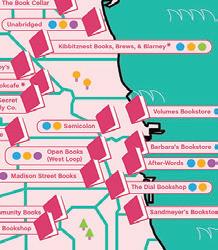




Muñoz’s third-grade mind caught a glimpse of metaphor in this description. “I was like, wow. Fire, the idea of a fire, or something that looks like it’s destroyed is actually kicking o these processes that are essential, that are vital, that will give life to things that we don’t even see on the surface. This is deep time work.” It gave her hope that the struggles she and her classmates were enduring could give way to their own regeneration, something vital for their own lives.
The image lingers, even years later. “I carried it with me as a spiritual token of sorts,” Muñoz says. Most of her recent paintings are controlled burn landscapes, painted throughout the pandemic.
Muñoz battled long-running imposter syndrome while painting landscapes. Her art history classes usually approached them as decoration or examples of conquest. But she kept returning to this metaphor of revitalization. And as a Mexican American artist who rarely had access to nature, who never owned land, she realized her perspective could transform what landscapes mean.

Muñoz says her family lost connections to land “through migration, through the loss of stories even.” When her parents came to the United States, they were in survival mode.
“So you lose the stories of their connection to land, what herbs they know about, all the little losses you don’t even know you’re losing,” she says. Painting landscapes helps her reclaim what was lost through the dutiful, careful practice of witnessing the land. “It has allowed me to forge a connection that I think various processes severed in people,” she says.
Realism speaks to Muñoz because she sees it as one of the most accessible styles. “There is just something about the language of realism that it can’t help but be relatable,” she says. She wants everyone, especially the working class community she was raised in, to know art is for them too, not just for other artists with advanced degrees.
Her realist style also transforms how the art world recognizes Latinx, specifically Chicana, art. Another contributor to Muñoz’s imposter syndrome was pressure to paint Mexican folk art, but using folk art’s bright colors and geometric shapes felt inauthentic. “There was nothing like that at home,” she says.
It was the mentorship of Dolores Mercado, a curator at the National Museum of Mexican Art, that helped Muñoz realize she didn’t need to change her style to fit established forms; she could expand her community’s aesthetic
possibilities.
And Muñoz’s style is itself an authentic portrayal of her life growing up in Little Village.
“My first impressions of beauty were in those dark internal spaces,” she says, speaking of her childhood reading poetry under the dining room table. “I could create a source of my own light.”
To create this light, her paintings require a particular physical process. Instead of canvas, Muñoz paints everything on panels, Masonite boards made of composite wood. “It’s labor intensive from the start,” she says. Her paint-
ings require an extremely smooth surface, so she spends a lot of time grinding boards down with a motorized sander. “You’re just covered in dust. It’s not cute. Not for the Instagram,” she jokes.
The process usually takes her a week, but for Muñoz, it’s a labor of love. “Because of the way that I paint, the application can be very delicate. Very fine brushwork.” Canvas weave can absorb pigment, but on panels, every detail, every small fleck of paint Muñoz puts down will stay there. Plus, “You love what you love,” Muñoz says. “I can’t, not for the sake of
cost, I can’t pick up another material.”
Though the images are so detailed, and almost photographic, she doesn’t use fancy paint brushes either. Muñoz works her brushes hard, so “I figure if I have to destroy a brush in two paintings, then I’m going to use a cheap brush,” she says with a laugh. But it’s also integral to her linework. “Sometimes it’s those funky brushes that give you those particular marks. Especially if you’re painting organic matter like grass, you don’t want a point that is too perfect.”
But the secret step in her process is silence. “People tend to be weirded out that I mostly paint in silence. And that becomes kind of an ingredient, I feel.” Muñoz explains that she’s tried to listen to podcasts or audiobooks to keep her company while painting, but they get in the way of her work. Silence facilitates her connection with the art.
“I have to hear the painting, if that makes sense,” she says. “You have this sense that the painting has to rest. It has to talk back to you. It has needs!” Rushing toward deadlines makes Muñoz feel like a bad creator. “I know you need space, I know you need time to sit and chill, and not me exerting my will,” she says of her paintings. “There comes a moment where that thing you are creating, it takes on its own presence.”
Muñoz thinks allowing her paintings to germinate in quietness is what allows them to enact desahogamiento. She’s had “the good fortune” to have people tell her that her controlled burns or dark seascapes helped them get through difficult moments in life. That’s the most rewarding part of painting. “I can’t sit in front of every viewer and ask them, desahógate,” Muñoz says. “My hope is to make works of art that have enough presence and are quiet enough to perhaps listen to the viewer.”
The tragedies of the past year have only clarified why she paints the way she does. “You know if you can accompany someone in a dark moment, I’m happy with that being my life’s work,” she says. “That sounds so pretentious but it’s so true! Because I know I’ve been extremely hopeless and the thing that has always gotten me out has been art. A beautiful sentence, a poem, a painting. To contribute in the stewarding of that e ort, I want to do that forever, please.”
View Elsa Muñoz’s work at elsamunoz.com and on Instagram @elsa.munoz.art. @nmdalea



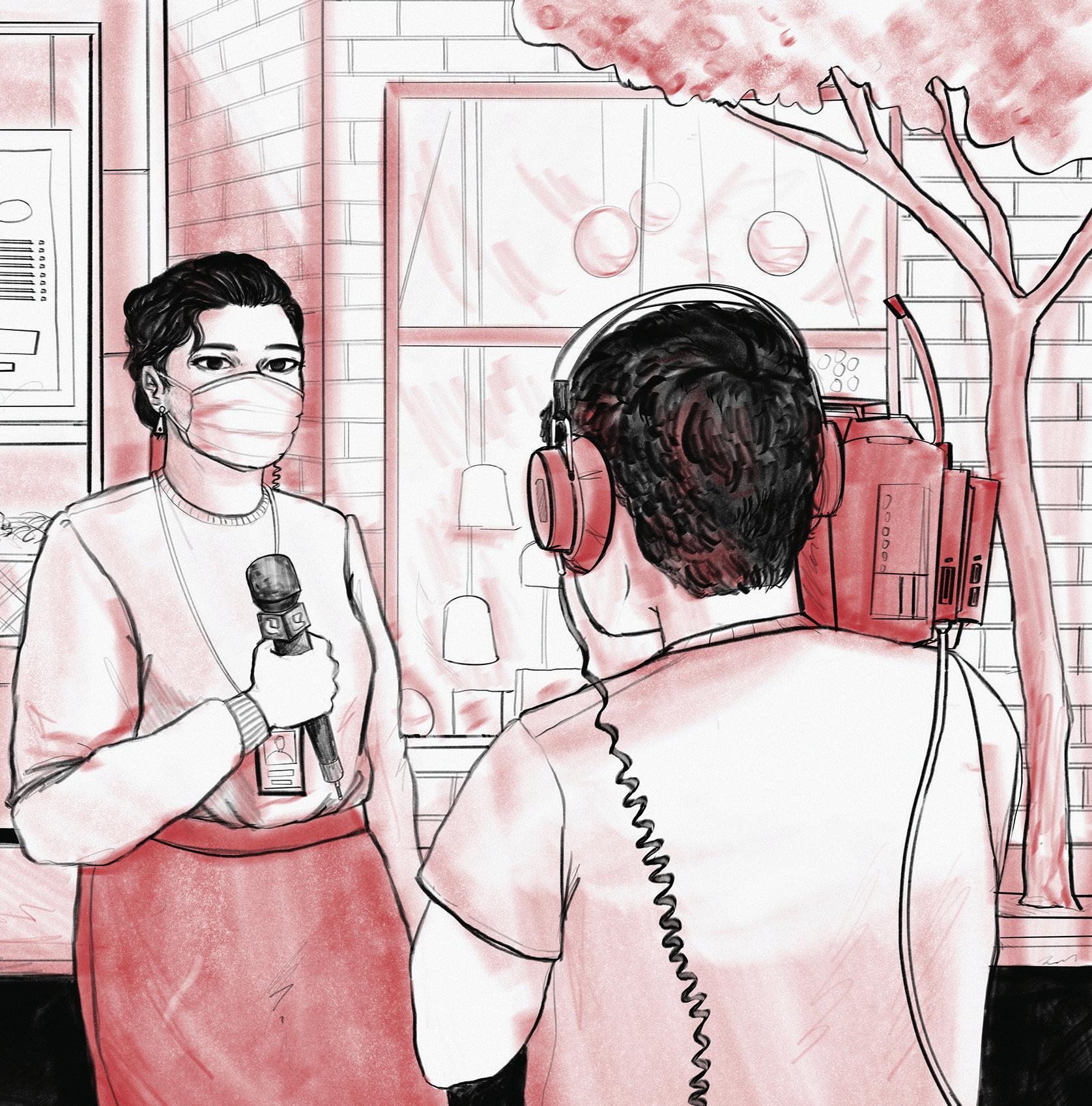
on the spring seasons of many dance companies at once, Chicago Dance Month continues to amplify the existing work of companies and dance artists in the city. “I don’t really consider us a presenting organization, even though we present pop-up events,” she says. “I produce these events in service to what people are doing in the community to bring dance to areas of the city and people of the city who wouldn’t normally see dance. I love those moments of just happening upon dance. Those are the most beautiful interactions.”
some conversations that were open and real. It was what I needed and what others needed at the time.”
The invitation to reach out for dialogue and resources remains open to the community.

Chicago Dance Month returns for a ninth time this June with in-person events featuring Chicago dancers and dance companies outdoors at Navy Pier and McKinley Park. Previously held in April, this year’s celebration launches a whole summer of Saturdays featuring dance at Navy Pier produced by See Chicago Dance. There will also be an online presentation June 24 as part of Chicago Takes 10, a virtual tour of the performing arts in Chicago sponsored by the Walder Foundation.
“I always want to have as many people participate in Chicago Dance Month as I can absolutely fit,” says SCD community engagement manager Surinder Martignetti, who has produced Chicago Dance Month for several years and whose own background in dance includes bhangra, ballet, jazz, tap, contemporary, Russian folk dancing, and Scottish highland dancing. “I want to have representation of different areas of the city and di erent genres of dance—concert dance, street dance, cultural dances—the depth and breadth of the Chicago dance community.” Through a selection process that is as inclusive as possible (“Who’s doing stuff? Who wants to do stuff? Who’s
available for what date?”), SCD strives to present nearly every dance organization that responds to their winter call for proposals, in keeping with their mission as a service organization for the Chicago dance community.
Founded in 2003, “SCD started out as a marketing initiative, where the focus was helping smaller dance companies and individual dance artists reach a wider audience and sell tickets,” explains executive director Julia Mayer.
“Over the last several years, especially with the pandemic, there has been a shifting focus to the well-being of the community with the recognition that our roots of our history are in a particular model of promotion of often Eurocentric dancing and dance presentation. Part of what we are doing is working to diversify who we serve and how we serve to include advocacy and education.”
“The people of Chicago, both audiences and the dance industry, realized there needed to be more than a calendar of events,” says Martignetti. “It grew organically from the calendar to marketing assistance. People started coming to us with questions—and that’s where the service organization part of SCD came together.” Developed to focus visibility
This year, Martignetti speaks with particular enthusiasm about the Scavenger Hunt, a self-guided tour on June 9 and 30 through McKinley Park featuring dance performances along the route. “It’s a beautiful wooded area, and there’s a garden and green space and lots of interesting spaces to dance in,” she says. “We’ve got Indian dancing and belly dancing and Middle Eastern dancing, films I’m projecting on the side of the fieldhouse, and contemporary work.” On safety protocols, she notes that the park district requires masks on its grounds and adds, “We’re keeping the groups small and doing several walk-throughs of the park to make sure there’s room for people to spread out and stay socially distanced.” For audience members who want to learn more about dance, volunteers will be stationed by each performing group to assist and offer information.
RCHICAGO DANCE MONTH
Opens Sat 5/29, 3 PM at Navy Pier, 600 E. Grand, F ; seechicagodance.com for complete schedule.
As the Chicago dance community continues to cope with the global pandemic and a nationwide racial reckoning, Martignetti and Mayer o er perspectives on how SCD functions as a service organization.
“Last year was really hard,” says Martignetti, who served as interim executive director of SCD before Mayer’s appointment in August. “I made a lot of phone calls and health care check-ins to everyone on the SCD member list several times the first few months of the pandemic—even if it was as little as leaving a voicemail saying, ‘Hey, I’m thinking of you, here’s my number—please call.’ I had
“We’re o ering all members the opportunity to say, ‘Hey, I’ve got a question or I want to learn something’—call me and I’ll give you ideas and resources and things to think about. I have conversations about topics like, we need to restructure our board, who can I go to to find grant money, we have a show coming up and we don’t know how to market to social media. I’m here for people to talk to and I’m never more than a phone call away.”
“Being mindful of the e ect the pandemic has had on ability for artists to make a living doing their work, we’re going to do a series of training and mentoring opportunities for dance on film,” says Mayer on SCD’s partnership with Building a Resilient Performing Arts Sector, an initiative sponsored by the Walder Foundation. “That program will launch later in the year. There will be workshops addressing fundamentals of creating dance on film, and, in 2022, there will be a more concentrated mentoring phase where some of the participants from 2021 will have the opportunity to create a full work.”
For the longer term, Mayer says, “We’re developing a dance amplification committee, which will include a couple of our board members but be primarily a group that comes together, some folks we invite, and that people in the group invite. One of the things we’re mindful of is a traditional white supremacist framework of who’s the gatekeeper and who isn’t. We’re in the process of developing a mission and purpose for that committee.”
In the meantime, she mentions, “We have our journalism platform that grew out of an idea that if there was more writing about dance, it would help people know about dance and sell tickets. With the transition away from dance criticism for the papers of note in Chicago, I think our platform has filled a gap to provide exposure to particular artists and dancers and ideas and considerations, failures, and missteps, everything that’s human about what our organization and the community is feeling.”
An exploration of cannabis and hemp topics from multiple perspectives: medical, historical, social equity, ecological and more.
Featuring:
What to Know About THC, CBD, and Your ZZZ’s
Expunging & Sealing Cannabis Records: The first in a 13-part “Everything you need to know” series
Cannabis Beverages: The latest innovation
Contributors:
RISE | Green Thumb | Curaleaf | High minded Events








With Select Squeeze, you can infuse any beverage with THC and flavor enhancements. Featuring Nano technology, Squeeze delivers a fast 1530 minute onset time, while the watersoluble formula disperses instantly into your favorite beverage. With a gentle squeeze, the pocket-sized self-measuring bottle offers a precise serving every time, thanks to its 5 mg easy-dose reservoir (1 squeeze and release = 1ML). Take it anytime, mix it easily, feel it fast. Available at Curaleaf.








Q: Before we get started, can you explain to readers why Green Thumb is presenting this new 13-part series on expungement and record-sealing in Illinois, and why you’ve asked Cabrini Green Legal Aid to help kick it o ?
Dina Rollman: The Green Thumb team is very conscious of the fact that our business is built on a plant that plays a significant role in the racist impact of the war on drugs. A major component of the drug war continues to be that cannabis laws are enforced at much higher rates in minority and marginalized communities, despite the fact that all communities tend to use cannabis at about the same rate.
That said, we have made it a company priority to do our part to reverse the harms caused by the war on drugs. The first step in that process is to eliminate the barriers caused by a criminal record that results in part from living in communities where drug laws are enforced at disproportionate rates. The goal of this series is to educate and build awareness around the expungement and record-sealing mechanisms available in Illinois and to elevate the voices who are really doing great work in this space, like CGLA. We’re not the experts and don’t pretend to be, which is why we are so grateful to Brandon Williams, who is an expert, for being here to help us launch this Q&A series.
Q: Brandon, welcome, can you tell us a little bit about the work you do in this space?

Brandon Williams: Thanks, yes—I’m the supervising attorney for the criminal records program at Cabrini Green Legal Aid. There are over 44,000 collateral consequences to having a criminal record in Illinois. A cannabis record can create barriers to education, housing, employment, banking—you name it. That’s why CGLA provides legal assistance to individuals negatively impacted by the criminal justice system, including help getting records cleared or expunged.
have the order entered, etc. There’s a major backlog in Chicago right now, though.
Q: What is the very first step a person should take to begin the expungement or record-sealing process and how much money will it cost?

BW: First head to NewLeafIllinois.org to get connected to one of the 20 nonprofits that provide free legal representation. The next step will be to pull your RAP sheet—in Chicago, you’ll have to go to the police department headquarters and pay $16 for your Chicago RAP sheet and Illinois State Police report. If you want to go to a private entity, you can get fingerprinted at an agency, such as Livescan, and get your state police report and possibly your FBI report. That can cost around $60.
Q: What are some of the other ways Green Thumb is working to help folks clear their records?


DR: Well, CGLA was kind enough to take the time to train about 30 of our in-house attorneys and outside counsel volunteers to be able to assist individuals going through the process. What really motivated this series, though, is that we regularly support expungement and record-sealing initiatives and events. The challenge is that a lot of people leave these events frustrated because they arrive thinking they can show up to one event and walk away at the end of the day with a clear record. The fact of the matter, unfortunately, is that it’s not a one-and-done process. The more we can expose the entire process and resources available, the more we can maximize the impact we have in all of the other initiatives we take on.
Q: What can we expect in next week’s Q&A?

DR: The Cannabis Regulation and Tax Act “automatically” expunged a number of cannabis non-convictions and convictions. We want to understand, and help readers understand, which records have been cleared and how they are supposed to know whether records have actually been removed.

Q: What is the di erence between expunging and sealing a record, and how long does the entire process take?


BW: There is a distinction. Expungement is for non-convictions, and sealing is for convictions. An expunged record is erased completely, so nobody has access to it, and the law enforcement records are destroyed. Sealing hides your record from public view, essentially. If you get a case sealed, the only people who have access to it are law enforcement, or employers who are authorized by law to run fingerprint-based background checks.
It depends on what county you live in, but you normally can get your records expunged or sealed within 60-90 days. You file a petition, submit your paperwork, get your hearing date, have a hearing,
Coming up: Automatic Expungement: Did the Illinois Cannabis Regulation and Tax Act automatically expunge my cannabis record?


Insomnia and other sleep problems may be improved with cannabis.
The past year has given us more reasons than ever to lose sleep.
If you’re up in the middle of the night staring at the ceiling, worrying or unable to relax, you’re not alone. Of course, there are many products, methods, and drugs that promise to improve sleep, but they often are not the healthiest options. There is, however, a natural remedy that you might consider: cannabis for sleep

Cannabis may help you fall asleep, and it may relieve the pain and anxiety that could be keeping you awake. Silas Wonderling, PharmD, a pharmacist and general manager of the RISE Dispensary in Monroeville, Pennsylvania, sees a medical marijuana patient for the first time, he always asks about the quality of their sleep.
“When a new patient comes in, I usually try to start with the sleep cycle,” he says. “Whatever medical issues people have, helping them out at night can be a real gamechanger.”
At RISE, Wonderling often helps people who are ready to stop taking prescription sleep aids and are interested in trying cannabis. “Our job in the dispensary is to help you find the most ideal product for you,” Wonderling says. “We want to make the trial-and-error process of finding the right product as quick as possible.”


The research on cannabis and sleep is ongoing, but we know one thing for sure: Cannabis has been shown to help people fall asleep. To understand how cannabis a ects sleep, look to cannabinoids, the active compounds in cannabis, including CBD and THC.
CBD facilitates sleep by mimicking a cannabinoid we naturally produce in our bodies: anandamide, sometimes called the “bliss molecule” for its ability to promote calm, Wonderling says.
THC, which is responsible for the psychoactive e ects of marijuana—the high—has been shown to help people fall asleep, even at low doses. The real power of cannabis for sleep might be its ability to ease symptoms of conditions that keep people awake at night, Wonderling says, such as anxiety disorders, post-traumatic stress disorder and chronic pain.


When Wonderling meets a new patient, he first asks if the patient is comfortable using THC and potentially experiencing a high. CBD-only products may help with sleep, but a product with a combination of both THC and CBD is usually most e ective.
For people without a lot of cannabis experience. Wonderling recommends starting with a low dose of a product that’s balanced in its THC and CBD content. You’ll want to find a strain with indica e ects, meaning it’s more likely to promote calm and relaxation, rather than sativa, which can be energizing.
For people looking to get to sleep, Wonderling often recommends tinctures, a concentrated liquid cannabis preparation that the user drops under the tongue. In general, if you choose edibles for sleep, look for a product expressly formulated for sleep. Keep in mind, it can be di cult to predict when edibles will kick in.”
“We can help you figure out if cannabis might be useful for you and how to incorporate it into your lifestyle.”



Stop by one of our dispensaries to explore our cannabis products designed to reduce sleeplessness and enhance well-being.

Through 6/20 : available streaming on demand with purchase anytime, chicagoshakes.com, $25. Free through 5/31 with promo code ALIEN
Chicago Shakes offers a sneak peek of It Came from Outer Space.
By CATEY SULLIVANBow down to It Came from Outer Space , the OG mother of all alien blockbusters. Since invading movie theaters nearly 70 years ago, the film (based on an original story by Ray Bradbury) has helped cement the genre’s place in the zeitgeist. It has left its influence on everything from Alien to Star Wars to Star Trek to your Uncle Bob’s conspiracy theories about the Bermuda Triangle and Area 51.
Now, Chicago Shakespeare Theater is taking the 1953 creature-feature flick where no adaptation has gone before: into the world of musical theater.
Back in the Beforetimes, CST had the world premiere of Joe Kinosian and Kellen Blair’s musicalized take on It Came from Outer Space slotted for 2020. We all know what happened next. It Came from Outer Space will still debut at Chicago Shakes, but the dates are strictly TBD.
But in a twist that seems appropriately cinematic, writer-creators Kinosian and Blair, with editor-creator Daniel Schloss, have released a 45-minute “digital prologue” for the stage musical. We Are Out There is their virtual intro to their play, framed as a mockumentary on the inexplicable events that forever shook the tiny western U.S. town of Sand Rock.
Streaming through June 20, We Are Out There features some of Chicago’s finest—Alex Goodrich, E. Faye Butler, and (the now LAbased) Cher Álvarez among them. There is also one brand-new song written just for the movie prologue and there are puppets, the latter a lifelong source of inspiration for Kinosian.
The movie that inspired the musical that inspired the mockumentary is easy to mock. In movie director Jack Arnold’s 1953 adaptation, the hero is a lantern-jawed hetero-he-man-savior. The women are bullet bras and shellacked hairdos, both immovable as monuments, no matter the screaming. There is more fromage than the Mars Cheese Castle.
Still, It Came from Outer Space remains as iconic today as it was groundbreaking back in the day, and not merely because it was the world’s first 3D feature film and made thousands of bespectacled viewers cower in sheer delight as UFOs came flying straight at their skulls.
ICFOS was also the first Hollywood movie with good aliens, i.e., extraterrestrials uninterested in killing earthlings or otherwise taking over the planet we have claimed. It was the first movie to invoke the spaceshipscrashed-in-the-desert trope. Spielberg has
said it influenced his creation of E.T.
Blair and Kinosian weren’t planning on writing a musical revival—much less a faux-documentary film prologue for it—when they went to a West Village screening of ICFOS in the early summer of 2016. They went in expecting a campy good-time romp. As Blair remembers it, they came out a little shook.
“The whole story is about these people trying to figure out ‘how do we get these creatures, these aliens out of our town?’ They’re all terrified, even though nobody even sees these aliens at first,” Blair says. “There’s just all this fear and hostility even though, as it turns out, the aliens aren’t that interested in killing anybody, they only want to get home themselves. So, summer, 2016, we’re hearing all this stu —‘Build a wall,’ ‘America First’—it made me think this movie was ahead of its time, so progressive for its era.”
“Even though it’s got this buff hero at the core of it,” he adds. “Halfway through our first draft we both realized that we were really going to have to take apart the whole white male saviorship thing.”
Blair and Kinosian were able to work with Universal in getting adaptation rights, but little could have prepared them for the straight-up decimation of their entire indus-
try wrought by COVID-19. Still, after the lockdown they kept in touch with Chicago Shakes’s creative producer Rick Boynton. The three had struck comic gold before: Blair and Kinosian’s infectiously chucklesome Murder for Two premiered at CST a decade ago and went on to plenty of subsequent successful productions regionally.
Eventually, the idea of filming a documentary about the events of the ICFOS musical took root, and Brooklyn-based Schloss came on board to film it. All the actors had their costumes shipped to them, along with a tripod, camera, and lighting equipment, a green screen, and whatever props their scenes called for. Schloss wasn’t sure at first, but quickly became convinced it would work.
“Obviously it’s better if I have everyone together and I can shoot them myself, or with a director of photography. But we couldn’t have the actors be together, or even with the crew. The actors are going to be filming themselves,” he says. Tech crew helped with set-up virtually. The cast wore earpieces that connected them to their scene partners’ dialogue.
“Technologically, it was a very ambitious project, especially with people in different time zones. I was skeptical going in. But I was pleasantly surprised about how effective it was,” Schloss says.
In 1953, It Came from Outer Space was momentously effective, as it brought 3D to the moviegoing masses for the first time. Schloss says he kept thinking about that when working on Out There
“Some of those effects might look so bad to us now, but they were the most futuristic things available at the time. It’s fun to think about how they were breaking ground and how we’re having to break ground,” Schloss says. “We’re using as much of the current technology that we can to make this movie. One of the pros of doing something very di erently than you usually do is that it forces you to invent new methods, new ways.”
Which isn’t to say the show isn’t rooted in good, old-fashioned, old-school star power.
“There’s a scene where E. Faye is operating three puppets and singing an alien song,” says Blair. “Honestly, I just hope people laugh and have a good time.”

RCHICAGO JAPAN FILM COLLECTIVE FESTIVAL
May 25 - 31, streaming online, cjfc.eventive.org, $15 for all-access pass, $10 per screening.
“This is a wish come true,” says Yuki Sakamoto, cofounder of the Chicago Japan Film Collective (CJFC), the first-ever Japanese film festival held in Chicago. The festival runs from May 25 through May 31 on Eventive, a digital streaming platform. “We are hoping to do a hybrid festival next year in theaters and also online, to make it bigger and bigger,” says cofounder Hiroshi Kono. Kono founded New York Japan CineFest in 2012, a film festival with a focus on Japanese indie shorts, while Sakamoto works with the Chicago International Film Festival and produces films of her own. CJFC is a product of their creative collaboration and friendship.
This year’s slate of nine Japanese films is comprised solely of independent films. Sakamoto says, “To me, independent works have a personal story that I very much cherish but the distribution is not easy—sometimes it’s impossible.” She notes that especially at international film premieres and festivals when lined up next to European films, Japanese films with monetary and logistical support from big studios are the only ones with a fighting chance. That’s why she and Kono have chosen to bring smaller indie films to Chicago, many of them enjoying their first midwest if not North American premieres.
Among the programmed films, BOLT and Alone Again In Fukushima focus on the 2011
tsunami and Fukushima nuclear disaster, two world-changing events that marked a tenth anniversary this year. This too was an intentional choice by Sakamoto and Kono. “It’s an ongoing thing—it never became part of history. We were very conscious of pieces that reflected the tragic disaster,” Sakamoto says, with Kono adding, “We need to bring it up and show to the world what’s going on in Japan.”
BOLT, directed by Kaizo Hayashi, is a cinematographic standout with exacting attention to detail, drawing out the excruciating struggle of a cadre of men who work at the Fukushima nuclear plant. Broken into three chapters, BOLT begins its story with an almost menial task—a bolt has come loose in the nuclear facility, leaking radiation-laden water, which the men must go and tighten—which then unfolds in an ever-echoing aftermath.
Alone Again In Fukushima is a documentary solidly rooted in nuclear aftermath, following the story of a man who has stayed behind in a radioactive town to take care of the pets and livestock that were abandoned after the town’s evacuation in 2011. Director Mayu Nakamura employs generous, gentle camerawork, dwelling on almost pastoral scenes, concentrating on balefully mooing cows and cheekily purring cats that skitter across radioactive ground. With themes of perseverance in the face of inordinate di culty, as well as
the stunning incompetence of the state in the face of a natural and man-made disaster, Alone Again is a quietly gorgeous film, brimming with powerful luster.
Taken together, the CJFC film selections o er an overarching realism, creating a prism of diverse stories and perspectives that showcase a collaged and multilayered Japan. This is especially timely, as Japan barrels optimistically toward the Olympic Games despite domestic concern that the games ought not to be the priority while the COVID-19 pandemic rages on. “Yes, Tokyo has the Olympics, and yes we have so much, and we can’t stay in the corona pandemic forever,” says Sakamoto. “The thing is, people’s hope and reality sometimes has a gap.”
Many of the films in the CJFC dwell in this gap between reality and expectation. Consider the lush, blue-toned Yan , about a young Taiwanese-Japanese man named Yan Yan who is tasked by his father to return to Taiwan and find his estranged brother. When Yan Yan arrives in Taiwan, he finds that his resentment toward his late Taiwanese mother and estranged brother are more complicated than they initially appear, especially when confronted with his brother’s new life. Director Keisuke Imamura adds a fluid, meditative quality to what would be an otherwise typical story of coming to terms with one’s past, adding balletic, contemplative scenes that imaginatively explore each character’s inner landscape.

Pushing more formal envelopes is All About Chiaki Mayumura , a film that starts like a straight documentary about the eponymous pop star. But, as the film progresses, it becomes apparent that the cheeky, poppy story has hidden depths with a distinctly science-fiction tinge: Chiaki Mayumura isn’t just an extremely capable pop star but actually several di erent people. No, she doesn’t have stunt doubles—she’s a clone from an underground alternative Tokyo. The light, airy, infinitely watchable film quickly develops into a clear-eyed thought experiment with scientific and ethical implications.
VIDEOPHOBIA is a psychosexual thriller about a disillusioned young woman who returns home to Korea Town in Osaka after the failure of her acting career. There, she engages in what she believes to be a casual one-night stand, only to find that her sexual encounter was filmed and uploaded to the Internet. Shot
entirely in black and white with a roving sense of voyeurism reminiscent of Hitchcock, this is a film that asks what happens when the difference between the life one hopes to live and the life one actually lives becomes too stark, causing a tilting erosion of reality itself.
Dynamite Graffiti and The Manga Master are the two most polished o erings of the bunch, both of them biopics. Dynamite Graffiti intermingles an upbeat, matter-of-fact tone with a sometimes-confounding grim reflection as it follows the life of adult magazine editor Akira Suei and the aftereffect of his mother’s suicide-by-dynamite. Most notable is the enthusiasm with which director Masanori Tominaga recreates Showa-era Japan, from smoke-filled sepia coffee shops to the unchanging drabness of the police o ces where pornographic images were censored by “reluctant” cops. The Manga Master is also about censorship and creative work, though set about 40 years prior with a focus on Rakuten Kitazawa, often thought to be the forefather of manga, a type of Japanese cartoon. Though the pace lags at times, the story’s careful attention to historical timeline effectively weaves together an artist’s ars poetica with a snapshot of Japan before and during World War II.
Though no screener was available for Prison Circle, this documentary is among the first-ever forays into painting an intimate picture of the contemporary Japanese prison system. “The film itself is made as a case study, and so we have four inmates and the director, who tried to dig into their stories and how they ended up in the place they are standing right now,” Sakamoto explains. Kono adds that while he was initially unfamiliar with the Japanese prison system, he hopes that viewers will have their eyes opened as he did, saying, “I want anyone, if they don’t know, to spend two hours or so to watch this film, and even if it’s a little time, they can still learn. That’s what I’m hoping for.”
With stories from all over the Japanese archipelago and a varied o ering of characters, the Chicago Japan Film Collective puts up a pluripotent first o ering. “You get a chance to watch a great side of Japan and sometimes a bad side of Japan, all included. I want the audience to trust us,” says Kono.
Sakamoto adds, “It’s such a pleasurable moment for me to bring these films in front of an audience. That’s the most important part for me as a producer—I hope that people will enjoy it.”

... beautifully captured in this 12”x12.5” poster
by Jason Frederickcelebrating 2020 (and 2020 being over).
This artwork originally appeared on the cover of our March 18, 2021 Best of Chicago issue.










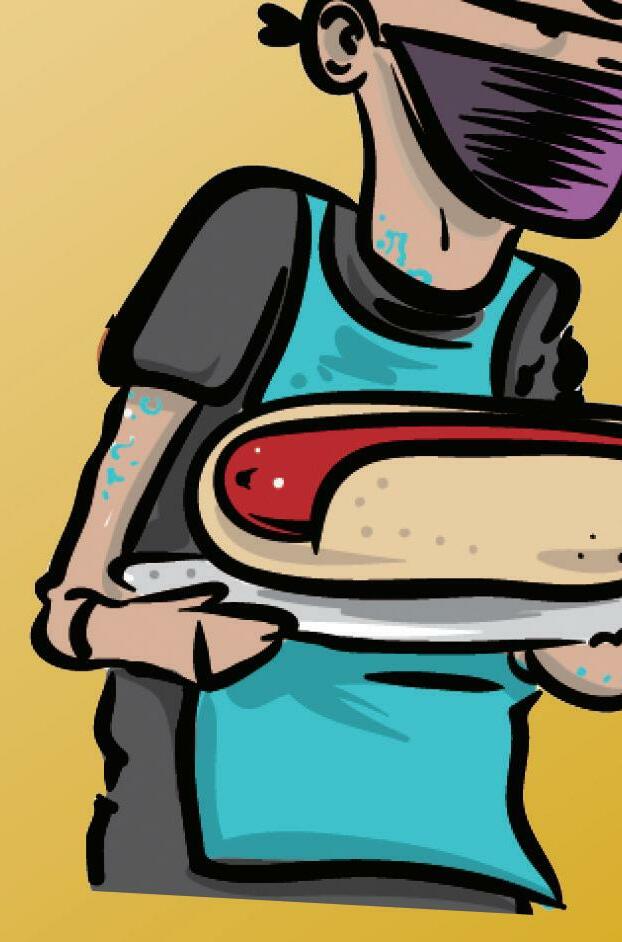
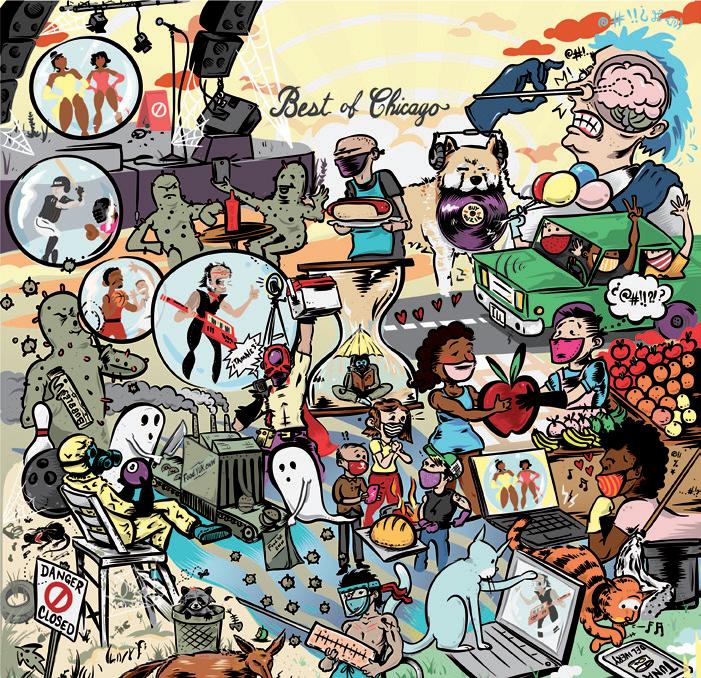













chicagoreader.com/store




Get showtimes and see reviews of everything playing this week at chicagoreader.com/movies

Imagine if Ocean’s 11 had been set amidst a zombie apocalypse and looked like a video game come to life. What you’re envisioning is probably a lot like this franchise-spawning, roughly two-and-a-half-hour undertaking directed by Zack Snyder (300 Zack Snyder’s Justice League). Having gotten his start remaking George Romero’s classic 1978 zombie film Dawn of the Dead, Snyder trods familiar territory in this circumscribed pastiche. The ever-charming Dave Bautista stars as the leader of a mercenary group hired to go into Las Vegas— Sin City having been closed off a er being overrun by fast-moving zombies—to retrieve millions of dollars in cash from a bad guy’s casino vault. He assembles a motley crew of survivors (played by the likes of Omari Hardwick, Ana de la Reguera, and Tig Notaro, who reshot scenes originally featuring Chris D’Elia in light of the latter’s alleged sexual misconduct) and penetrates the soon-to-be-nuked city, only to find that some of the zombies have evolved, effectively creating their own society in the quarantine zone. There are some cloying relationship-oriented subplots and a predictable twist that accounts for one of several lazy ways in which Snyder (who came up with the story and cowrote the script) attempts to invoke politics and current events. All told, however, the film is actually fairly enjoyable, taken for what it is. Snyder shot the film himself; the intentional blurring of background action is needlessly distracting.
—KATHLEEN SACHS 148 min. Netflix
Cruella is a lot of things that struggle to coalesce. A prequel that sets out to illuminate the early years of “one of cinema’s most notorious—and notoriously fashionable—villains,” Cruella de Vil, it’s ostensibly a
movie made for kids. But it’s more likely to hit with those adults who protested Disney World’s closure during the pandemic. Set in 1970s London, with about 500 music cues to match the period (if not the on-screen action), the film follows Estella (Emma Stone), a clever creative determined to stamp her signature on the fashion world. A gri er living with two equally mischievous friends, the vibe is very Oliver Twist at first. Later, the movie morphs into a girl-boss story by way of The Devil Wears Prada territory when Estella catches the attention of Baroness von Hellman (Emma Thompson), earning her a job as a fashion designer. This includes a Jenny Humphrey-style faux punk fashion show and sets into motion a course of events that cause Estella to embrace her evil side and become the villainous, voguish, and vengeful Cruella de Vil. —BECCA JAMES 134 min. In wide release in theaters, Disney+
Mainstream offers an alluring cast, but the same cannot be said of its characters. Maya Hawke leads, playing Frankie, a young woman who finds a path to Internet stardom when she starts making videos of Link (Andrew Garfield). Billed as a “charismatic stranger,” Link is more your local loser, who Frankie finds doing Jackass-lite pranks in LA. Later, Johnny Knoxville shows up as a stunt cast, which is delightful, but again the talent isn’t the issue; it’s the stale writing, which makes for a shallow satire. Nat Wolff and Jason Schwartzman round things out as Frankie’s writing partner and Link’s agent, respectively. Together they’re supposed to share a cautionary tale about people trying to preserve their identities within the fast-moving Internet age. The problem is, those identities are never explored beyond nice girl, bad man, good guy, and slightly older bad man, and the film can’t keep up with what it’s trying to comment on. —BECCA JAMES 94 min. In wide release on VOD
Milkwater is a spectacular showcase of Molly Bernard’s superb talents. As Milo, a straight and aimless 20-something who rashly decides to become a surrogate for Roger (Patrick Breen), an older gay man she meets at the bar, Bernard displays a character as messy as she is mesmerizing. A slightly grittier version of the beautiful Together Together which came out earlier this month, Milkwater takes its time examining its characters’ rougher edges. So, when Milo’s relationships begin to unravel because of her own shortcomings, viewers will still root for her. A er all, her friends’ lives aren’t the picture of perfection either, with each facing their own relationship discord. Though, as Milo comes to realize, the strife is more than surmountable. Growing pains abound as she grapples with boundaries, emotional entanglement, and the he y weight of the decision she has made in a way that feels authentic enough to earn viewers’ affections. —BECCA JAMES 101 min. In wide release on VOD
Writer-director Haifaa Al-Mansour is widely recognized as being the first female filmmaker from Saudi Arabia; she’s also the first filmmaker to shoot a film (her 2012 directorial debut, Wadjda) entirely in the Kingdom. A er directing two other features (Mary Shelley, Nappily Ever A er) and several television episodes abroad, Al-Mansour returns to her home country with this 2019 feature about one woman’s journey to relative independence. Maryam (Mila Al Zahrani) is a doctor in a small Saudi Arabian city; the road to her clinic is unpaved and susceptible to flooding. She faces other obstacles as well, the most obvious being that she’s a woman in a supremely oppressive country. Made one year a er women were granted the right to drive in Saudi Arabia, and amidst an expanding cultural landscape—that, among other things, brought with it the reopening of movie theaters a er a 35-year ban—the film positions the initially conservative Maryam as a symbol of hope and change. Through unusual circumstances, Maryam registers to run as a candidate in the municipal county elections. Committed to getting the clinic’s road paved, Maryam challenges both herself and community members to respect her as a legitimate candidate, with the help of her two sisters and a potential suitor. There’s also a subplot about Maryam’s musician father (underground Saudi folk star Khalid Abdulrahman), who’s finally able to tour with his band a er many years of being prohibited from performing in public. This isn’t revolutionary filmmaking, but Al-Mansour is consistently adept at expressing the revolutions that start within.
—KATHLEEN SACHS104
min. Music Box TheatreFrom Superbad to Good Boys, the buddy comedy genre is chock-full of films where two best friends— the dorkier the pair, the better—go on an adventure, full of mishaps and hijinks, usually taking place over one long, chaotic day with one specific goal in mind. Recent additions like Booksmart have paved the way for more women, but Natalie Morales’s Plan B surpasses its predecessors as one of the most progressive, star-making teen films in years. A er goody-two-shoes Sunny (Kuhoo Verma) impulsively loses her virginity, she and her slacker best friend, Lupe (Victoria Moroles), go hunting for a morning-a er pill before Sunny’s 24-hour window closes. Just as in 2020’s Never Rarely Sometimes Always, the girls live in a community that is not so fond of reproductive rights, forcing them to travel from their small South Dakota town to Rapid City in the hopes of finding a Planned Parenthood. Our two leads of color more than pull their own weight: Verma is immediately lovable and Moroles bursts through the screen with the energy of a balloon that was untied and let fly. It’s hilarious, it’s heartwarming—keeping things light but not shying away from the dangerous lengths some girls in these situations must go to, all while delivering a Brown girl buddy comedy for the ages. —NOËLLE D. LILLEY 108 min. Hulu
A follow-up to the 2018 horror hit, A Quiet Place Part II sets us down in the post-apocalyptic northeastern United States in which alien creatures have decimated society as we know it, leaving the survivors to shelter in silent fear. Beset by the creatures, the Abbot family is forced to leave their home, and venture out into the world to seek safety and find a way to defeat their stalkers. In this go-around, John Krasinski’s script is a fitting continuation to his previous effort, more heavily emphasizing the story of Regan (Millicent Simmonds) and newcomer Emmet (Cillian Murphy) with a B-story that focuses on a holed-up Evelyn (Emily Blunt) and Marcus Abbot (Noah Jupe) trying to protect the newborn baby Abbot. A Quiet Place Part II is an overall entertaining film, despite losing some of the charm of the original. As is o en the case, the character development of this sequel is less interesting than the establishment of the overall concept is in its predecessor, and there’s a bit too much of a dependency on the creatures chasing our heroes around. Jump scares remain the thrill of the day here, and fittingly, so does strong use of audio cues that at times overwhelm our attention —ADAM MULLINS-KHATIB 97 min. In wide release in theaters v

Senior writer Deanna Isaacs began contributing to the Reader in the 1980s, climbing a creaky staircase to a cluttered warren of o ces in a then-unfashionable area of River North to deliver her typewritten freelance stories to managing editor Patrick Clinton. Many of those articles were brief, event-related pieces for the paper’s double-spread Calendar Page. (As best she can remember, her first Calendar byline was for a piece about the arrival of an exotic fish at the Shedd Aquarium, and its equally exotic donor.) But there were also longer features on subjects such as forensic hypnosis and the battle over abortion rights. Deanna had cut her teeth in journalism as a reporter at the St. Petersburg Times and Chicago’s City News Bureau; prior to that, she earned a PhD in English at Northwestern University. Over the years, she’s worked on various Reader special projects, including its venture into the suburbs, The Reader’s Guide to Arts & Entertainment. She’s been the Reader’s culture columnist since 2001. Smitten in middle school by the work of war correspondent Ernie Pyle and, much later, by New Journalism and the Village Voice, she says she still feels lucky to have landed at the Chicago paper that gives writers the freedom to find the city’s real stories and the editorial support to tell them well.
Amber
Amber Hu joined the Reader as a graphic designer in January 2020, roughly six weeks before the COVID-19 pandemic sent the city spinning into lockdown. If the way she helped steer the visual side of the paper through such a turbulent period is any indication of her drive and talent, we can only imagine what she’ll be able to accomplish during her second year on sta and beyond. Amber earned her Master’s degree in visual communication design at the School of the Art Institute, and in addition to being an ace graphic designer, she’s an accomplished illustrator and cartoonist. In fact, she’s responsible for our lovely sta images— including the self-portrait that accompanies this bio. “I’m inspired by my coworkers’ work,” she says. “Even through the struggles of current times, the Reader has helped me find new music, online events, and general ways to enjoy the days.” Not that she’s at a loss for ideas. Her favorite places in the city include Quimby’s Bookstore, Rotofugi, the Judy Istock Butterfly Haven at the Peggy Notebaert Nature Museum, and her corner store. When she’s at home she enjoys listening to Turkish rock group Mor ve Ötesi and English R&B singer Nao, and reading literature and comics (Jesmyn Ward’s novel Salvage the Bones and Tillie Walden’s graphic novel On a Sunbeam are among her favorite titles). “As a Chicago local obsessed with print media, design, and most things art, my role at the Reader is a perfect fit, isn’t it?” she asks. That question may be rhetorical, but it’s impossible to imagine any of her coworkers responding with anything less than a resounding, “OMG. YES!!!”
@berhuff

 John Dunlevy Director of Digital
John Dunlevy Director of Digital

The Reader’s 50th anniversary isn’t the only major milestone we’re ready to celebrate—2021 also marks a full quarter of a century since director of digital and all-around-good-guy John Dunlevy joined our crew. Born in Maine, John lived in Iowa and Alabama before his family settled in Oxford, Ohio when he was in the second grade. He moved to the city to study at the University of Chicago, where he earned his Bachelor’s degree in history before being hired by the Reader as a computer expert in 1996. As the Reader’s digital needs mounted, he stepped up to the plate to launch the paper’s first internet-native email server, and build its first online systems for placing classified ads and searching local restaurants. By the time society fully shifted from dial-up to WiFi, he was working in digital full time. The Capricorn, who lives with his wife Martha and cat Tino, has a calming demeanor, especially when he’s talking his less computer-savvy coworkers (read: this writer) through a hardware crisis. But while John might be the Reader’s in-house tech whisperer, his interests are so numerous that if they were electronic files, they’d overload our server. An experienced photographer, John is professionally proficient in German and dabbles in several other languages. He’s also a skilled recording engineer and radio talent who had an on-air stint at WCEV and hosted a live rock ‘n’ roll program on Hyde Park’s WHPK. These days he keeps an “ever-changing list of perfect songs,” which currently includes tracks by Thin Lizzy, Simon Joyner, the Jesus & Mary Chain, and Neko Case. Reflecting on his time at the Reader, John says, “Over the years I have worked with an incredible number of incredibly talented and awesome people, and I’m always amazed that I still do.” We’re glad you stuck around, John—here’s to 25 years together and counting!
 @jdunlevy
@jdunlevy
As we look forward to our 50th Anniversary on October 1st we celebrate the staff of the Reader who make the paper possible.
The pandemic immediately cut off Patrick Shiroishi from public performance, and even in private it was nearly impossible for the Los Angeles avant-garde musician to perform with other people. This wore him down so much that by summer 2020 he was barely playing his saxophone. “I was really
bummed out,” he says. “I didn’t touch my horn for two to three months.”
That changed in August, when he received an unexpected message from Chicago experimental artist Matthew Sage. He’d gotten to know Sage a couple years before, when Sage’s old label, Patient Sounds, held one of its occasional open calls. Shiroishi had submitted
a live recording by his nonet Danketsu 9—a layered, long-form drone piece occasionally tinged with acid jazz—and in March 2019, Patient Sounds released it on CD as Towards a Walk in the Sun. Sage’s note didn’t come out of nowhere, but it turned out to be even better news than Shiroishi imagined.
Sage was putting a new o er on the table,
An online collaboration by four musicians in four states has parlayed pandemic necessity into new forms of creativity—and some tight longdistance friendships.
By LEOR GALILand Shiroishi had liked working with him enough to take him up on it. The idea was that Sage and Shiroishi would remotely record a collaborative album with two other musicians, violinist Chris Jusell and multiinstrumentalist Chaz Prymek. All four live in different states—Prymek is in Missouri, Jusell in Pennsylvania (where he moved from

Colorado last June). Everyone in the quartet would record their own parts and upload them to a shared Dropbox. All four were accustomed to traditional modes of collaboration, where players share a space and feed o the group’s collective energy, but Sage’s new ensemble couldn’t even draw on the memory of such symbiosis—the members had never assembled in one place before.
“None of us have ever been in the same room as Patrick, ever,” Sage says. “Chaz and Chris had met each other in passing—they sort of knew each other, and they have a lot of mutual friends, but they weren’t ever friends-friends. They were all aware of each other. I picked three of my favorite musicians that I knew, and was like, ‘Hey, we should all be friends, and work on something together.’”
The quartet completed an album, titled Fuubutsushi (風物詩), with impressive speed: the recording was done within two weeks, and Sage released it in late September. On that first release, Prymek plays guitar, Jusell plays violin, Sage plays keyboard and percussion, and Shiroishi plays alto and tenor saxophones, clarinet, flute, glockenspiel, and samples; Prymek and Sage are both credited with field recordings, and everyone but Jusell adds “voice” (though there’s almost no singing— just wordless intoning here and there and a few words in Japanese on the final track).
The gently rustling music explores the space between jazz-influenced instrumentals and ambient improvisations, and feels much like the performers are playing o one another on a stage.
Sage released Fuubutsushi on his new label, Cached Media, which he’d established about six months before. He pressed 100 CDs, and they all sold out within a week. Because Cached is a one-person operation whose PR apparatus consists entirely of its e-mail newsletter (Sage has a day job as an instructor in the Communication, Media, and Theatre Department at Northeastern Illinois University), those sales surely came mostly via word of mouth. Two months later, in early December, Pitchfork ran a glowing review of the album. By that point, the quartet was already working on a follow-up. “I think for all four of us, it just felt really good—the process of working on it felt really good, and it was good to be in each other’s company in a text chain and meet on Zoom calls and stu ,” Sage says. “I had a lot of friends during quarantine who got into Dungeons & Dragons—they’re playing D&D online together, and I sort of feel like that was what happened for us. We started this game, and then we didn’t want to stop playing. So we just expanded the campaign.”
They devised a plan to record an album
every season. The winter full-length, Setsubun (節分), came out in February, and the spring release, Yamawarau (山笑う) , arrived May 7. All three albums are credited to “Jusell, Prymek, Sage, Shiroishi,” but in a Cached newsletter announcing Yamawarau , Sage proposed an alternative: fans could refer to the group as Fuubutsushi, a Japanese word that more or less means “evoking nostalgia for a season,” like cherry blossoms in spring. It’s a fitting term for a group whose music echoes the subtle shifts of natural processes. On the Yamawarau track “Kodama,” Shiroishi’s soft, seraphic singing seems to summon a gradually intensifying instrumental interplay—gently arpeggiating guitars, pitter-pattering percussion, duvet-plush horns and violins—that’s suggestive of a field of lilies coming into bloom.
Fuubutsushi are working on their summer album, with plans to wrap it up in June. Sage and his wife, Lynette, are also expecting their first child at the end of June, and he plans to pause all Cached activities when the baby arrives. I suspect that doesn’t include communicating with the rest of Fuubutsushi, though. “We talk every day in a group chat,” Sage says. “We’ve become best friends through this, which is so weird and cool.”
In 2009, Sage launched Patient Sounds, his first label, while living in Fort Collins, Colorado. He met Jusell shortly thereafter, when they both worked at a co ee shop called the Bean Cycle. “I played with a folk band in Colorado, but nothing more experimental, like what Matt was doing,” Jusell says. “I guess near the end of when he was living there, I started recording on some of his stuff just now and then—a couple of tracks on some of his albums.” He’s since played on all but one of Sage’s solo albums (released under the name M. Sage), and once Sage moved to Chicago in 2014, Jusell often traveled here to record.
In September 2013, Jusell backed Sage at Denver’s experimental Goldrush Music Festival. The fest is also how Prymek met Sage— that year it had booked Lake Mary & the Ranch Family Band, an expanded version of Prymek’s long-running fingerstyle guitar project, Lake Mary. “He came up to me after my band played, threatening to put me out on vinyl,” Prymek says. “Shortly after that, we kept talking and somehow convinced each other that we should play music together. We started a friendship like that. I would take the bus or hitchhike out to his house—it was a couple hours from me— and we’d record all day.”
By the time Sage moved here, his reputation in the experimental-music scene preceded him. Colin Blanton, who records as Brin, was
working at the Reckless location in the Loop when Sage dropped by on label business in 2014. “He came in to put some tapes on consignment for his previous label, Patient Sounds,” Blanton says. “I was like, ‘Oh, are you Matt Sage?’ And we just talked.” Blanton soon moved to Portland, but in 2019 Patient Sounds released the Brin EP Hug Sway Patient Sounds amassed more than 130 releases in its ten years, mostly on cassette. Aside from his own solo material and music by Shiroishi, Prymek, and Blanton, Sage put out recordings by the likes of local drone auteur Cinchel, Hausu Mountain cofounder Mukqs, Cleveland IDM artist Tiger Village, and out-of-this-world Yokohama footwork experimentalist Foodman. In Patient Sounds’ final years, he noticed that much of the music he received when he made open calls came from solo artists.
“I think sometimes the amount of gravity that people imbue into those kinds of projects is a thing that’s a lot for me to deal with as a single person running a label,” Sage says. “It was like, ‘This is a thing I’ve been working on for two and a half years, and it’s the best thing I’ve ever made, and I’m gonna give it to you to put out on your cassette label, and you’re gonna make 100 and everyone’s gonna know my tape by the end of the summer.’ And that was a lot of pressure.”
Sage bid farewell to Patient Sounds with an August 2019 show at the Hideout. Prymek opened with Lake Mary, and Sage put together a backing band for his headlining set with Jusell; after the show, Prymek gave Jusell a ride to the airport. Sage chose to end the label to give himself a break and a new start. He wasn’t finished running labels, but he wanted to experiment and take more chances, to break from what he’d been doing with Patient Sounds. “When I noticed this pattern of ‘every thing is just solo,’ I was like, ‘Huh, I wonder if there’s a way I can try something di erent,’” he says.
At the end of 2019, Sage invited two Chicago experimental synth artists, Gianni Andreatta and Zander Raymond, to his house for a recording session. Several months later, it would result in an understated album of ambient textures called Seymour . “I was like, ‘I think I might want to do this collaborative thing in the future—you guys should come over and record.’ And we recorded all that and sort of sat on it forever,” Sage says. “I always had a feeling that that’s what Cached was gonna do, was this collaborative thing, so that when the label launched I was like, ‘We have this release that’s the three of us. Maybe we should just start there and see where it goes.’” Cached released Seymour, credited to Andreatta, Ray-
mond, Sage, in April 2020.
By the time Seymour came out, live music had been under COVID lockdown for more than a month. For Shiroishi, Prymek, Jusell, and Sage, that meant being isolated from their local and regional scenes. Jusell’s income had also taken a big hit; he’s part of the live band backing Denver singer-songwriter Nathaniel Rateli , who’d kicked o a tour roughly a week before the pandemic hit the fan.
Sage had a feeling Shiroishi, Prymek, and Jusell might be up for working together, and he figured he could gel with them too—in fall 2019, he’d recruited all three to contribute to the latest M. Sage album, The Wind of Things (released in April 2021 by Geographic North).
Shiroishi and Prymek had already worked together when Sage reached out—and Prymek had been into Shiroishi’s music for even longer. “I fanboy Patrick real hard,” he says. “My tape deck that holds all my tapes in my car, there’s four rows and three of them are Patrick Shiroishi tapes.”
Prymek had e-mailed Shiroishi cold a few years ago, and they’d struck up a correspondence. In June 2020 he sent Shiroishi a track he’d been working on.
“I thought it was an invitation to play on it,” Shiroishi says. “It was a 20-minute song, so I ended up adding all sorts of things on top of that track. I sent it back, and then I realized that I misinterpreted the message. I was super embarrassed, like, ‘Oh my God, how would I feel if someone just played over my track that I thought was finished?’ But he really liked it.” In September 2020, Prymek released that collaborative track, “Slow Grass,” to raise funds for a friend’s recently incarcerated brother.
Jusell wasn’t convinced at first that he belonged in the company of the other players, though he’s one of Sage’s longest-running collaborators. But once he came aboard, he validated Sage’s hunch. “I think Matt was feeling sorry for me, maybe, and already had this plan to record with Chaz—Lake Mary—and Patrick Shiroishi, and just asked really casually if I’d like to participate,” Jusell says. “I was intimidated, but said yes, and then it just ended up feeling incredibly easy and fun.”
Of course, the question of how the Fuubutsushi crew came together is entirely separate from the question of how they manage to make their elegant, richly layered music via Dropbox. “It’s one of those things where it’s absolutely mysterious to us too,” Sage says. “We don’t know how it works. We don’t know how we get the energy that we get on the songs. I think that’s part of the magic, and that’s the part that we try not to poke at too much. We just know how it works
silences are, and then I just pick my favorite parts.”
for us.”
The musicians do have a basic guiding process. Each album begins with one member uploading several recordings of a single musical element—a few melodic piano sketches, for instance, or a series of bass tracks—to a shared folder. Those recordings tend to become the nuclei of songs, and the members can all upload new parts for each one in its respective subfolder whenever they like. “Matt will upload six foundation tracks in a day, and then suddenly Chaz has added to them on the same exact day,” Jusell says. “Chaz and Patrick and Matt all have jobs and significant others and houses. They have things going on—it’s not like they’re just waiting in a void to do stu .”
Sometimes a member will send a message to the Fuubutsushi group chat to update everyone on his progress. And they all tend to use this text chain for much more than their collaboration. “Everyone really roots for each other,” Shiroishi says. “In the group chat, Matt was showing us [The Wind of Things] before everything was posted about his record. Chaz was telling us about his label that he was starting and his collaboration and his plans. Chris was on a Tiny Desk concert [with Nathaniel Rateliff], and he linked us in. Everyone was just being really stoked for each other.”
Fuubutsushi began with keyboard recordings Sage had been tinkering with for months. “I got really into Harold Budd albums and Bill Evans albums, and I’ve been trying for a long time to learn jazz piano,” he says. He uploaded enough piano recordings to give the other members foundations for a handful of tunes. “Then they started layering on those piano songs, and they sent them back to me,” Sage says. “That’s when I started adding the drums. Then all of a sudden we had the first one done. It was super fast.”
The freedom for the musicians to contribute at their own pace has a lot of benefits. “It’s the sort of thing where you leave a fight, or you leave a conversation with somebody, and you’re like, ‘Oh, that would’ve been the perfect thing to say’—you have those few extra seconds to really refine your wording or something. It feels really similar with the Dropbox music,” Jusell says. “Often what I do with these tracks is record myself going through it five or six or seven times, and then I go through and chop it up based on where the
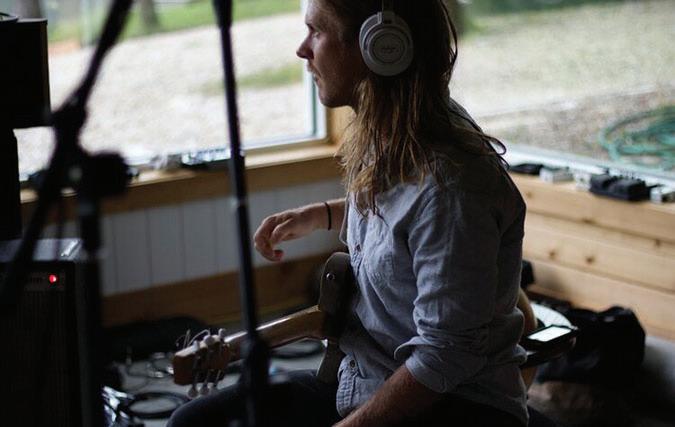
Once everyone finishes adding to the Dropbox, Sage assembles a rough version they can sit with for a spell before hopping on a Zoom call together for a mixing session. “We all spend some time—usually a week—listening to them and coming up with notes and stu ,” Prymek says. “Our Zooms are epically long. They’re four or more hours of us, and half of it is ridiculous goofery—watching each other cook or eat food. Then we all have our notes, and Matt sets it up so that we can listen to it all together. We all go through, and he very patiently tries to fit in all our notes.”
The way their first album turned out took Prymek by surprise. “I thought it was gonna be more ambient,” he says. “I didn’t expect us to get so jazzy and so ECM directed. I thought it was going to be more like this whimsical fluttering of acoustic stu .” That airy, jazzy sound also established a foundation for the group’s future efforts. “The first album was kind of getting to know each other and how we play,” Prymek says. “With the second one, we had a good basis, like, ‘I can now imagine more that this will happen—I can imagine more that this will happen.’ I think we all gave each other a little bit of extra space and went for it a little bit harder.”
Jusell thinks he was the first person to suggest creating seasonal albums—he was making a reference to Vivaldi’s The Four Seasons. “I do think it was my group-chat text that was, ‘Let’s do the Four Seasons of jazz,’” he says. He also hid an Easter egg on the winter album, Setsubun , by playing an upside-down twist on Debussy’s “Footprints in the Snow”—a reference to his ongoing conversation with Shiroishi about the relative merits of Debussy and Ravel.
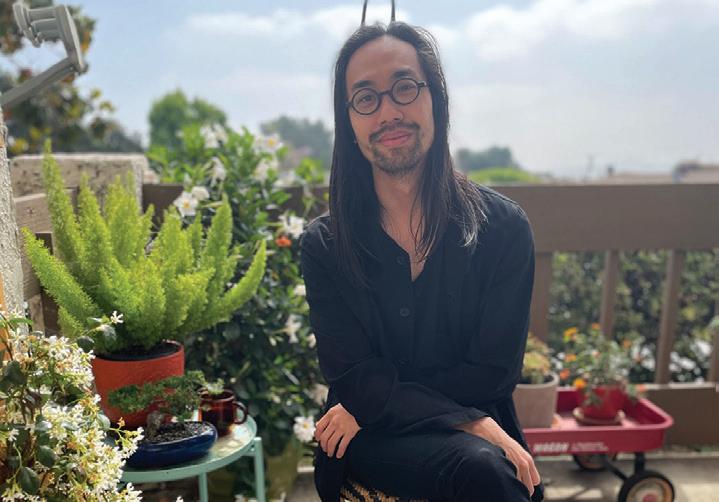
The seasonal schedule provided Jusell with an unexpected benefit too, during a period when many people lost track of the passage of days. “It’s also a strange thing to have recorded these seasonal albums, and to have such strong markers of time during COVID,” he says. “And to feel like I have strong memories of each time.”
Participating in Fuubutsushi has helped these four musicians weather an unpredictable and difficult year. “It brought me a ton of joy and gave me an excuse to sit down and play music, and gave me three new very, very good friends,” Prymek says. “Especially at this time where I’ve been losing friends left and right, and isolated, it’s a little like a warm fire to come to.”
As the musicians began to get more comfortable with one another and with the Dropbox approach, they gave themselves more room

to experiment. “I’ve really gotten to explore with different instruments that I wouldn’t have in any other setting,” Shiroishi says. “I play a lot of glockenspiel.” On Yamawarau , he plays tenor and alto sax, of course, but also trombone and guitar. He sings too, and more than the brief, unobtrusive textures on the first two Fuubutsushi albums—his vocals on Yamawarau are still lullaby-soft, but they’re foregrounded crisp and clear.
“It makes me feel comfortable, you know, that I could try something like that,” he says. “Some collaborations you can kind of tell from the person that you’re making music with, like, ‘All right, it’s gonna go this way.’ Or, ‘These are the parameters that I’m gonna be working with.’ But I think even going from the fall to the winter record, everyone kind of took chances, and that made me feel comfortable, like, ‘Oh, I could try to sing.’”
Much of Shiroishi’s work—including his contributions to Fuubutsushi—explores his Japanese American heritage. He sings in Japanese, and he’s made space on each Fuubutsushi album to include recordings of Japanese Americans in documentaries talking about their experience in U.S. concentration camps during World War II. His paternal grandparents were confined at the camp near Tule Lake, which he first visited in 2016. “It’s something that as a musician I’ve been trying to express—the feelings that I have and that my family went through,” he says. He addresses these themes even on solo releases that don’t involve any voices at all. “Some of it is hard, just because a lot of that I don’t really use vocals or have words. It’s primarily all saxophone music. So the titles are the best that someone could interpret. I hope that that message gets through to people.”
His Fuubutsushi bandmates have been receptive and encouraging. Fuubutsushi accompanied the release of Yamawarau with a run of merch—a couple T-shirts and a sweatshirt— whose proceeds benefit AAPI civil-rights organization Asian Americans Advancing Justice.
The Bandcamp page for Fuubutsushi describes it as the second Cached release in a series of albums made via socially distant or remote collaboration. Sage performed on the first, July’s Birthmark, a duo with Tennessee experimentalist Frank Baugh. As Fuubutsushi attracted new listeners, Sage began to reach out to more friends to contribute to the remote collaborative series. “I just want people to have fun doing this stu ,” he says. “Music is so serious—especially experimental music—so I want to goof o a little bit more and just have some fun.”
In December, he pitched the idea to Colin
“Brin” Blanton, which would result this spring in the third and most recent entry in the series (not counting the other two Fuubutsushi records). “That whole project definitely kept me occupied throughout the winter,” Blanton says. “It helped a lot—it was very therapeutic.”
Blanton reached out first to Texas experimental musician Mauri Rubio, whose More Eaze project he’d heard through Chicago label Lillerne Tapes. “I instantly thought of her when the idea was presented,” Blanton says. They put together a list of potential collaborators, and Rubio suggested Los Angeles experimental pop producer Jimmy Tamborello, better known as Dntel—his experience with remote collaboration dates back to his early2000s stint as part of cult indie-pop band the Postal Service.
The collaboration began with Blanton, Rubio, and Tamborello on a Zoom call, and quickly took o from there. “For most of these songs, either Jimmy or myself provided the foundational sample, semifinished composition, or something with a lot of room in it, and then we would pass that around,” Blanton says. “Usually it was just, like, ‘All right, this is done.’ But there are a few tracks that we sat on for a while—or would do a few passes, and kind of tweak the mixing a little bit. It was surprisingly easy; everyone seemed really laidback with the whole thing. It flowed naturally.”
Cached released the Brin, Dntel, More Eaze album Futurangelics in early April, and the trio is still working together. “We’re all buttoning up some other projects at the moment, but we have an LP2 folder going,” Blanton says. “It means a lot, ’cause now it’s sparked this cool band and these friendships that I’ll cherish.”
The same month Sage put out Futurangelics, Prymek and Jusell traveled to Chicago for a weekend to record live-band renditions of Sage’s The Wind of Things material. “They’re the first people that we’ve had in our house since COVID started, and it was like having family over—it was really, really special,” Sage says. “And so it really is the biggest silver lining on what’s been a real turd of a year—doing this stu with these guys.”
They made sure to FaceTime with Shiroishi during the weekend. The four members of Fuubutsushi say they can’t wait to all be in the same room—to spend time together and play music. “I’ve thought my closest friends and collaborators would be here, in LA, with me,” Shiroishi says. “To have that in the middle of COVID, when the world was falling apart, to have this come out of that, and the camaraderie . . . I think that’s really nice.”
Recommended and notable releases and critics’ insights for the week of May 27
Bands hyped as “supergroups” usually sound cool in theory but often wind up less memorable than the better-known projects of their members. By contrast, the pop rock on Bachelor’s debut, Doomin’ Sun , will stick to your brain like bubblegum on the bottom of your sneaker. Bachelor is the duo of Melina Duterte, a Los Angeles-based songwriter and producer who makes bedroom pop as Jay Som, and Ellen Kempner, who fronts Brooklyn indie-pop trio Palehound. Recorded during two weeks in January 2020, Doomin’ Sun balances 90s-style alt-rock and dreamy, down-tempo indie rock. On “Stay in the Car,” a distorted bass line and overdriven guitars burst over the chorus while Kempner sings a deadpan melody so catchy you’ll need surgery to dislodge it from your skull. Opening track “Back of my Hand” mines similar loud-quiet-loud territory, though its refrain is filled instead with layers of synths, percussive shakers, and shiny guitars. Bachelor change things up on the album’s slower tracks, such as “Moon” and “Sand Angel,” where Kempner and Duterte pair their hushed vocals atop snare drums that sound like they’re covered in loose-leaf paper. The album’s mood bounces from quiet drama to noisy angst, but from top to bottom Doomin’ Sun sounds like it was a blast to record. At the tail end of “Spin Out,” just before the bass groove of “Anything at All” starts, you can hear Duterte on a hot mike joking, “Today is vocal day, not horny day.” A stuffier group wouldn’t include such a candid moment in the final mix, but a lack of pretense is part of what makes Bachelor great. —MATT
SIGURJaimie Branch’s Fly or Die, Fly or Die Live International Anthem intlanthem.bandcamp.com/album/fly-or-die-live
Matador
mdoumoctar.bandcamp.com/album/afrique-victime
“IF WE STAY SILENT, it will be the end of us,” Mdou Moctar sings in French on the title track of his new album, Afrique Victime (Matador). If there’s one thing you can say for sure about Moctar, it’s that he’s not silent. The Nigerien guitarist keeps one hand on the tradition of Saharan Tuareg blues that Tinariwen made internationally famous and runs the other frantically over the fretboard of psychedelic rock. On Afrique Victime, he travels further into the land of Jimi Hendrix and Eddie Hazel as he thunderously addresses the injustices inflicted on his homeland. The title track is a seven-minute tour de force that laments the history of French colonial brutality with a pyrotechnic blast of resistance, including a guitar solo that touches on Van Halen’s manic runs before squalling into Sonic Youth-style feedback, rage, and transcendence. “Chismiten” stays more grounded in Tuareg music; it sounds like a Tinariwen track sped up enough to break land-speed records, and its video, which features footage of Niger’s markets and mosques, comes o as a defiant celebration. To provide breathers between the electric-guitar freak-outs, Moctar performs breathtaking acoustic numbers; the rhythmic, driving blues of “Layla” could make a juke-joint jump and Son House moan. Like his musical heroes—whether they’re from the Mississippi Delta or the Sahara Desert—Moctar uses his guitar to twist pain into defiance and joy. Afrique Victime is the sound of the colonized rising up to take over the world, and doing it loudly.
 —NOAH BERLATSKY
—NOAH BERLATSKY
If the world can agree on one thing, it’s that 2020 was not our best year on record. For former Chicagoan Jaimie Branch, it should’ve been a time of triumph for her current quartet, Fly or Die. The group were riding the wave of a splendid sophomore LP, where Branch added vocals with tragically topical antifascist themes to her adroit trumpet playing, and from its release in October 2019 right up to the week that lockdowns began, they’d toured tirelessly to support it. This double live album, recorded in January 2020 in Zurich, Switzerland, proves that the band had reached a point where they couldn’t go wrong; even if one musician flubbed a note, another would turn it into a great new idea. Drummer Chad Taylor sustains an endlessly variable stream of life-giving grooves, even as he engages in inspirational interplay with whoever is soloing. Cellist Lester St. Louis and double bassist Jason Ajemian both play thrilling solos, but they also come together to form what sounds like a four-handed organism capable of juggling bluesy strumming, arcing lines, and intricate rhythms. Branch’s banter is charged enough to break the Swiss audience out of their alleged neutrality, and they cheer her as she castigates fascism, racism, apathy, and closed borders around the world during “Prayer for Amerikkka.” Her trumpeting sounds equally capable of starting fires, jumping like lightning among intricate rhyth-
mic figures, electronically magnified growls, and stark, dramatic statements. Fly or Die were already blowing space junk out of their path before COVID19 grounded them; who knows how much higher the combo will soar as the world opens back up? —BILL MEYER
Anthony Braxton, 12 Comp (ZIM) 2017 Firehouse 12

firehouse12records.com/album/12-comp-zim-2017
My mother always told me, “When you get older, you’ll begin to see the world in shades of gray.” Generally speaking, she was right (as usual), but I often find that idiom falling short of my personal experience. Listening to the prismatic 12 Comp (ZIM) 2017, I finally understood why: I’d much rather see the world in spectral wheels, the way Anthony Braxton does. Throughout the 11 hours of 12 Comp, the experimental composer and reedist—an icon of the hugely influential Association for the Advancement of Creative Musicians—investigates the ceaseless shi ing of hues. Braxton’s ZIM music project, of which the works on 12 Comp are a part, expands upon his “language music” paradigm, which uses 12 broadly interpretable performance directions to guide musicians through his scores. These works all foreground processes derived from the same single directive among those 12, in a system that Braxton calls gradient logic: rather than describe the quality of a sound, as do many of his 12 language types (e.g., long tones, trills, multiphonics), gradient logic describes how sounds relate to one another and how they change. Braxton’s transformations are rarely as simple as unidirectional shi s (e.g., faster, quieter, shorter, sharper); given enough time, a single starting point can pirouette into wholly unexpected shades. Recorded in 2017 and 2018, the works on 12 Comp (ZIM) 2017 feature a core ensemble with Braxton on reeds, Jacqueline Kerrod on harp, Dan Peck on tuba, and Taylor Ho Bynum on various brass instruments. At minimum, they appear as part of a sextet—on Composition 402 they’re augmented by harpist Shelley Burgon and Chicago
cellist Tomeka Reid—but for the album’s most undulating works, Braxton’s ensemble swells to a nonet that includes Reid, accordionist Adam Matlock, saxophonist Ingrid Laubrock, trumpeter Stephanie Richards, and harpist Brandee Younger. Each track clocks in at about an hour, giving Braxton’s gradient logic plenty of space to play out on macro- as well as microstructural scales. The four works for nonet (Compositions 413 to 416) stretch Braxton’s gradients to the extreme, occasionally sheathing the ensemble’s angular interpolations in a dreamy haze. The three most recent tracks for septet, recorded at a 2018 London gig with harpist Miriam Overlach, volley fast-developing fragments—but lyric lulls still emerge stealthily, suffusing the texture with glitteringly impressionistic figurations. Don’t conflate the aerobatics of these tracks with equivocation— this is music on the move, and the journey is glorious.
—HANNAH EDGARAs DJ C, Chicago producer Jake Trussell has developed a gi for extracting the DNA from an eclectic variety of pop subgenres, then scrambling their nucleotides and recombining them—and his manipulations not only illuminate the hard-to-see strands connecting parallel musical histories but also encourage anyone with at least two brain cells to dance. Throughout the new Do Radly (Mashit), Trussell experiments with artful, ambitious hybrids: on one track he might blend smoky blues guitar and sparse, electrifying hip-hop drums spiced with dub effects (“Super Flyover”), while on another he’ll combine pinprick garage synths, mellow upright bass, solemn contemporary-classical strings, and a loopy keyboard that sounds like futuristic reggae (“Wellsweep”). Trussell’s open-minded approach to dance music gives him a lot of room to mess around, and he’s clearly taken great care in shaping even the tiniest details—despite the huge diversity in sound here, the whole album hangs together
as a cohesive whole. Trussell’s choices make every song on Do Radly pop, and their unpredictably makes his music surprising even on repeated listens. Because we’ve all spent more than 15 months sweating public-health regulations to keep one another safe, it’s liberating to hear someone break a bunch of rules—in this case, rules about musical genres— and end up with an album so joyful and life-giving.
—LEOR GALILDais
hide3.bandcamp.com/album/interior-terror
The term “minimalism” often conjures up white walls and bright lights—a defiant barrenness in a world steeped in chaos—but Chicago-based industrial duo Hide take their stark sounds to a far darker and more malevolent space. On the new Interior Terror, multi-instrumentalist Seth Sher (Coughs, Ga’an) and singer and visual artist Heather Gabel don’t attempt anything particularly complex or detailed, but they more than compensate with punishing volume and powerful messages—they use Gabel’s voice, field recordings, and a smokestack of electronic hardware (including a skipping Depeche Mode CD) to cra brutal social commentaries. The aim of Interior Terror is to draw and quarter (and then reconstruct) the physical and spiritual notions of the body. Using a palette of industrial sonics, Sher and Gabel remake Cartesian dualism—the system of thought that divides body and mind—in their own sinister image. The duo operate in their own orbits, even more clearly here than on previous releases: Sher lays down beds of screeching power electronics while Gabel issues barbarous proclamations. The album opens with its title track, which begins with stomach-churning atmospheres and a ten-ton hammer that drops at every turn, yielding only to Gabel’s refrain of “I am not my body.” The lyrics of the next track, “Nightmare,” come from a dream Gabel’s mother confided to them over the phone (“Last night I had a vision of you / I’m scared / The pain is never-ending”). On
“Daddy Issues,” the duo bow to their forerunners in musique concrète, melding opera samples and Gabel’s ghastly wails with knuckle-dragging dialogue sourced from a letter by the father of Brock Turner—the Stanford student who earned national infamy a er being convicted of sexually assaulting an unconscious woman in 2015—where he asked the court to give his son nothing but probation, arguing that prison time (Turner was eventually sentenced to a paltry six months behind bars) would be a “steep price to pay for 20 minutes of action.” Confronting existential dilemmas and societal ills hardly makes for a pleasant listening experience, and that’s exactly the point of Interior Terror. Hide have never based their music on conventional melody or structure—they’re activists with an electronic armory and a PA. With Interior Terror, they demand that we look beyond artifice and virtue signaling to shed light on every horror, fully aware that we won’t like what we see.
 —SHANNON NICO SHREIBAK
—SHANNON NICO SHREIBAK
Nadja, Luminous Rot Southern Lord nadja.bandcamp.com/album/luminous-rot
Experimental drone and postmetal outfit Nadja got their start in 2003 as the solo studio project of ambient musician Aidan Baker, but by 2005 he’d enlisted the help of bassist and vocalist Leah Buckareff to bring his music to the stage. They’re a married couple as well as bandmates, and they’ve since relocated from their native Canada to Berlin. Over the years they’ve amassed more than 50 releases, issuing many on their Broken Spine imprint. There’s no telling what blend of shoegaze, dark ambient, metal, and other textures each record might contain—2018’s Sonnborner is infused with noise and death metal alongside its strings and sun-kissed atmospheres—but each is a reliably welcome emotional journey through a sonic fog that’s lush and rich enough to cut with a knife. The title of Nadja’s latest album, Luminous Rot, might sound like they’re describing the spectrum of beauty and brutality in their own music, but its themes of first contact and
continued from 41
communication with extraterrestrial life show that their gaze is focused outward and upward, not on the mirror. Recorded by the band at their home studio-slash-rehearsal space and mixed by postpunk luminary David Pajo, Luminous Rot is partially inspired by the work of science fiction writers and theorists such as Stanislaw Lem, Liu Cixin, and Margaret Wertheim. That heady subject matter lends a sense of exploration and awe to the record’s most meteoric sounds, no matter how light or dark they get. A brilliantly hued instrumental introduction launches the title track, which drops a fuzzy riff that bears a resemblance to Nirvana’s “Negative Creep”—that is, before industrial funk washes over the tune and creeping vocals rear their heads. The heart-wrenching centerpiece of the album, “Cuts on Your Hands,” builds a slow, deliberate groove, and then its radar screen picks up noisy flourishes and hazy feedback, swirling distantly overhead. Nadja aren’t a band to stay in any one mood for long, though, and on “Dark Inclusions” they dive into a haunting metallic throb topped with layers of Baker’s so , hallucinogenic vocals and undergirded by a diabolical, bass-heavy stomp, then explode into a droning, cacophonous finale. Now that we’re slowly finding our ways into a “new normal,” once-familiar routines can feel alien, and reuniting with family and friends a er more than a year of involuntary separation can feel like a first encounter—so despite its intergalactic ambitions, Luminous Rot feels fit for this moment here on Earth.
—JAMIE LUDWIGNature’s Neighbor, Other Side Tai Duo Music
naturesneighbor.bandcamp.com/album/o-t-h-er-s-i-d-e
Chicagoan Mike Walker has led Nature’s Neighbor for more than a decade, working with a revolvingdoor cast of musicians who’ve helped him realize his liquid indie-pop sound. But as much as the project is his brainchild, its new album, Otherside (Tai Duo
Music), wouldn’t exist without longtime collaborator Terrill Mast. Early last April, Mast texted Walker from his home in Virginia about writing a song together, and despite Walker’s initial hesitance, the endeavor snowballed into a full-length record that demonstrates how far the two musicians’ intimate trust has taken them. Otherside delicately threads together an acoustic-guitar ballad (“Monday Morning Drive”), a near-ambient soundscape anchored by a voice memo from Nature’s Neighbor multi-instrumentalist Brandon Studer, who’s also an expectant father (“First Mother’s Day”), and a proggy indie-pop song built from what could be a sample of a marimba-style cell-phone ringtone (“Dreadnought”). Throughout the album, the group maintains a firm grip on its most experimental impulses, wrestling them into shapes that carefully draw listeners through every stylistic dip, switcheroo, and loop-the-loop. The way “Bold Move” expands its shrunken funk synth into a maximalist intergalactic melody suggests that Walker and Nature’s Neighbor have only begun to explore their creativity.
—LEOR GALILblood-music.com/store-us/41-perturbator
French multi-instrumentalist James Kent, who makes music as Perturbator, has a lifelong history with synthesizers—his parents were in a band that used them—and he negotiates the possibilities of his instruments as fluently as a native tongue. Though Kent has a background as a black-metal guitarist, he prefers to work alone, and as he told Tunecore in 2016, he found electronic music to be the best genre for that. Kent burst onto the scene in 2012, dropping two Perturbator full-lengths and three EPs in one year. He also helms a dark-ambient project called L’Enfant de la Forêt and has had his music featured in several video games and television series. Since that spectacular debut, Perturbator hasn’t stayed quite as prolific, but the
intricacies of the project’s retro-inspired, metalinflected darkwave sound have remained intact on the albums and EPs he’s put out since then. Perturbator’s new fi h full-length, Lustful Sacraments, continues Kent’s explorations of electronic film soundtracks, Krautrock, shoegaze, goth, and industrial to create something that’s by turns romantic, harrowing, unsettling, and fierce (if not all at once). Based around a theme of dissolution and self-destruction, the music gets its hooks in you and drags you deep into its darkest waters. The album features a few choice guest spots: members of French doom band Hangman’s Chair add a dreamy undertow to the elegiac “God Says,” while Virginia postpunks True Body bring an 80s-style dark synthpop groove to “Secret Devotion.” Perturbator really cuts loose on the title track, which is sweeping and somberly grand but still danceable, and on the single “Death of the Soul,” whose dramatic industrial punch recalls Nine Inch Nails and Ministry. “Messalina, Messalina” brings Kent’s metal leanings to the forefront with a pounding pulse and sinister chiming that evoke desperation (more so if you know the story of the doomed Roman empress parodied in the 1977 film of the same name). If time is a circle rather than a line, Perturbator is at a great advantage; on Lustful Sacraments, Kent takes inspiration from the past five decades of electronica to weave a tapestry that would look great on the wall of a plague house.
 —MONICA KENDRICK
—MONICA KENDRICK
Group sagethe64thwonder.co/album/hierophant
When I interviewed Chicago rapper and SlumpGang member Receo Gibson a few years ago about changing his stage name from Sage, the 64th Wonder to Lunxch, he said he did it to help get out of a creative tight spot. “When I was under the moniker Sage, I felt, like, clustered,” he said. “I didn’t know what to do musically. I didn’t have no direction. It drove me into a panic, a mental panic.” Per-
haps the break from that name provided Gibson with the new focus he desired: a er a quiet 2020, he returned as Sage in February with the simmering EP The Gods Here Are Stupid, where he sounds re-energized. On his follow-up, May’s Hierophant (O-Go Sound Group), Gibson’s growling verses ride so low on the unvarnished boom-bap beats that the grit in his voice practically scuffs up their dusty samples and wrought-iron percussion. On “Talking Shoes,” he accompanies a looped sample that sounds like muffled strings with lyrics about the creative pressure cooker that musicians face when they’re trying to provide for a family—and the tension he creates by crowding his rapping up against the instrumentals ratchets up his ferocity and drive. By the end of Hierophant, it’s clear that Gibson has enough gas in the tank to power him to the next fillup.
—LEOR GALILChicago-via-Michigan rapper Smba plies pop-punk aesthetics to make hip-hop tracks soaked in melancholy. These songs could tentatively be described as Soundcloud rap, since that term (which took hold of hip-hop four years ago) has already been stretched far enough to include any MC with a Fall Out Boy T-shirt, but they have enough dimensions that not even the loosest label can contain them. Smba takes a gentle, inviting approach on their latest EP, Claustrophobic (2DB Company), usually maintaining a level-headed restraint on their halfsung verses even when their syllables cluster in rapid-fire knots—and that sense of self-control and self-awareness lends hopefulness to their most somber lyrics. On early single “Slow Down,” Smba navigates a sour acoustic-guitar riff by veering between a swooning hook and blocks of tough lines that nearly leave them out of breath—a strategy that helps each new verse arrive with an irresistible sense of upli . —LEOR
 GALIL v
GALIL v
EVER SINCEÉSSO dropped a selftitled album of dance-floor fillers in 2015, the groove-tastic local band’s fusion of Latin music, Afrobeat, and psychedelic rock has set Gossip Wolf’s toes to tapping. As if in response to the despair of the pandemic, ÉSSO decided to release their next album one song per month, to spread out the fun—last spring and summer, they put out five singles and videos, including “Animal,” “Izquierda,” and “Chico Chango” (which features Latin soul crooner Lester Rey ). Producer and front man Armando Pérez also released a solo cumbia EP called Raza in September. On Friday, June 4, Pérez’s Sonic Octopus label will release the LP Xicago , which combines the singles, the EP, and three previously unissued tracks; it’s available for preorder via Bandcamp.
Local singer-songwriter David Singer fronted Kid Million in the 1990s, and since then he’s become a founding board member of Intonation Music , directed the 2016 jewel-heist film Imperfections , and released soundtracks, solo albums, and records with his band the Sweet Science Singer says their new glam-rock opus Vicious Kicks is “about our inexorable search for something/anything that can break through the boredom, the desensitization, the target advertorials, [and] the doomscrolling.” The album arrives Friday, June 4, and that night Singer and the band play a low-capacity show at SPACE
On Saturday, May 22, the Logan Center for the Arts debuted an outdoor sound-art exhibit as part of a yearlong series of projects extending the 2020 edition of South Korea’s Busan Biennale in Chicago. The exhibit, “11 Musicians for 11 Writers Outside,” includes work by Nagoya footwork auteur Foodman , Taipei experimental artist Meuko! Meuko!, Seoul electronic musician Odæri , and the inimitable Kim Gordon . The installations will stay up till Monday, June 14.
—J.R. NELSON AND LEOR GALIL
Got a tip? Tweet @Gossip_Wolf or e-mail gossipwolf@chicagoreader.com.

Esmé Patterson 6/12, 7 and 10 PM, SPACE, Evanston b
Pitchfork Music Festival day one featuring Phoebe Bridgers, Big Thief, Animal Collective, Fiery Furnaces, Yaeji, Black Midi, Hop Along, Kelly Lee Owens, Ela Minus, Dehd, So Pink Truth, DJ Nate, Dogleg, Armand Hammer 9/10, noon, Union Park b
Pitchfork Music Festival day two featuring St. Vincent, Angel Olsen, Kim Gordon, Ty Segall & Freedom Band, Waxahatchee, Jay Electronica, Jamila Woods, Georgia Anne Muldrow, Faye Webster, Amaarae, Maxo Kream, Divino Niño, Bartees Strange, Horsegirl 9/11, noon, Union Park b
Never miss a show again. Sign up for the newsletter at chicagoreader. com/early
Spafford 11/6, 8 PM, Park West, 18+
AC Slater, Taiki Nulight 6/12, 7 PM, Lakeshore Drive-In ARC Music Festival featuring Camelphat, DJ Heather, Derrick Carter, Luttrell, Zhu, Gene Farris, Hiroko Yamamura, Adam Beyer, and more 9/4-9/5, 2 PM, Union Park, 18+
Arclight, Aathee 6/10, 8 PM, Bananna’s Comedy Shack at Reggies
Asleep at the Wheel 9/19, 7 PM, Maurer Hall, Old Town School of Folk Music b
Tarriona “Tank” Ball book tour for Vulnerable AF 7/23, 8 PM, Thalia Hall b
Bleacher Bum Band 6/19, 5 PM, GMan Tavern
Cafe Racer 7/22-7/24, 9 PM, Empty Bottle
Carriers 6/16, 6 PM, Tack Room F b
Josh Caterer, 6’10 6/17, 8 PM, Bananna’s Comedy Shack at Reggies
Cold Waves IX kickoff party featuring Pirate Twins (DJ Scary Lady Sarah and William Faith), Choke Chain, Morgue Vvitch 9/23, 8 PM, Smart Bar
Cold Waves IX night one featuring Clipping., Consolidated, Dalek, Odonis Odonis, Pixel Grip 9/24, 7 PM, Metro, 18+
Cold Waves IX night one featuring Paul Barker (live PA), Acucrack 9/24, 11 PM, Smart Bar
Cold Waves IX night two featuring Front 242, Youth Code, Barker & Connelly: Luxapan, Provoker, Fee Lion 9/25, 7 PM, Metro, 18+
Cold Waves IX night two featuring Void Vision, Blixaboy, Bud Sweet 9/25, 11 PM, Smart Bar
Cold Waves IX night three featuring Stabbing Westward, Actors, Bootblacks, Korine, Wingtips 9/26, 7 PM, Metro, 18+
Cold Waves IX festival closing party featuring DJ Philly Peroxide 9/26, 10 PM, GMan
Tavern
Crumb 11/3, 9 PM, Metro, 18+ Des Rocs 10/1, 8 PM, Beat Kitchen, 17+ Dodie, Lizzy McAlpine
2/7/2022, 7:30 PM, Riviera Theatre b
Dry Cleaning 11/17, 9:30 PM, Empty Bottle Anderson East, Savannah Conley 12/3, 8 PM, the Vic, 18+ Everclear, Hoobastank, Wheatus, Aeir 7/14, 8 PM, Concord Music Hall, 17+ Friko 6/6 and 6/13, 4 PM, Golden Dagger
Fu Manchu, Speedealer 3/30/2022, 9 PM, Bottom Lounge, 17+ Funkadesi 6/6, 5 and 8 PM, SPACE, Evanston b Future Islands, Hinds 9/18, 8 PM, Chicago Theatre b
Joaquin Garcia’s Nasty Tempo
6/3, 7 PM, FitzGerald’s, Berwyn F b
Hail the Sun, Kurt Travis, Kaonashi, Body Thief 10/8, 6 PM, Bottom Lounge b Happy Fits, M.A.G.S., Snarls 11/11, 6:30 PM, Subterranean b Hot Mulligan, Prince Daddy & the Hyena, Sincere Engineer, Super American 12/17, 7 PM, Bottom Lounge b
Jason Isbell & the 400 Unit, Brittney Spencer 8/22, 7 PM, Wintrust Field, Schaumburg b
Julian’s House Party at the Drive-In presents Legends in the Mix 6/5, 4 PM, SeatGeek Stadium, Bridgeview b
Local H 6/16-6/18, 7 PM; 6/20, 7 PM, GMan Tavern
Lollapalooza featuring Foo Fighters, Post Malone, Miley Cyrus, Dababy, Marshmello, Illenium, Journey, Megan Thee Stallion, Roddy Ricch, Kaytranada, Brockhampton, Playboi Carti, Young Thug, Limp Bizkit, Modest Mouse, Polo G, Trippie Redd, and more 7/29-8/1, 11 AM, Grant Park b
Makaya McCraven 7/9-7/10, 7 PM, Thalia Hall b
Mo Lowda & the Humble, Desert Noises 10/8, 8 PM, Subterranean, 17+
John Moreland 8/12, 8 PM, Thalia Hall, 17+
Motel Breakfast, Alayne May 6/4, 8 PM, Bananna’s Comedy Shack at Reggies
Motel Breakfast, Reno Cruz
6/6, 7 PM, Bananna’s Comedy Shack at Reggies
Mr. Blotto 6/8, 8 PM; 6/15, 8 PM, Reggies Music Joint Nasty Snacks 6/4, 7 PM, FitzGerald’s, Berwyn F b
North Coast Music Festival day one featuring Kaskade, Louis the Child, Claude VonStroke, Liquid Stranger, San Holo, Whethan, LSDream, Manic Focus, Wax Motif, and more 9/3, 2 PM, SeatGeek Stadium, Bridgeview, 17+
North Coast Music Festival day two featuring Griz, Ganja White Night, Green Velvet, Diesel, Lane 8, Nghtmre, Charlethefirst, Dom Dolla, and more 9/4, 2 PM, SeatGeek Stadium, Bridgeview, 17+
North Coast Music Festival day three featuring Zeds Dead, Rezz, Bonobo, and more 9/5, 2 PM, SeatGeek Stadium, Bridgeview, 17+ Nunslaughter, Cardiac Arrest, Angelust, Hatemonger 7/31, 8 PM, Beat Kitchen
Pitchfork Music Festival day three featuring Erykah Badu, Flying Lotus, Thundercat, Danny Brown, Cat Power, Andy Shauf, Caroline Polachek, Yves Tumor, Weather Station, Mariah the Scientist, Oso Oso, KeiyaA, Special Interest, Cassandra Jenkins 9/12, noon, Union Park b
Queensrÿche 7/31, 8 PM, Arcada Theatre, St. Charles b Railheart 6/10, 8 PM, SPACE, Evanston b
Cathy Richardson 6/11, 8 PM, SPACE, Evanston b
Riot Fest day one featuring Smashing Pumpkins, Coheed and Cambria, Lupe Fiasco, NOFX, Dirty Heads, Sublime with Rome, Circle Jerks, Dinosaur Jr., Motion City Soundtrack, Thrice, Circa
Survive, Meg Myers, Lawrence Arms, Beach Bunny, and more 9/17, 11 AM, Douglass Park b
Riot Fest day two featuring Run the Jewels, Faith No More, Dropkick Murphys, Rancid, Taking Back Sunday, Vic Mensa, Gogol Bordello, Mayday Parade, Bayside, Mighty Mighty Bosstones, Andrew W.K., Best Coast, Big Freedia, Gwar, Ganser, and more 9/18, 11 AM, Douglass Park b
Riot Fest day three featuring Nine Inch Nails, Pixies, Machine Gun Kelly, Devo, Mr. Bungle, New Found Glory, Simple Plan, Ghost Inside, K. Flay, and more 9/19, 11 AM, Douglass Park b
JP Saxe, Cat Burns 10/30, 7:45 PM, Metro b
Noel Schajris 11/8, 8 PM, Bottom Lounge, 17+
Ricky Skaggs & Kentucky Thunder 9/12, 7 PM, Maurer Hall, Old Town School of Folk Music b
Todd Snider, Jamie Lin Wilson 11/5, 7 PM, Park West, 18+ Sonic Currency, 6/11, 8:30 PM, Bananna’s Comedy Shack at Reggies
Dave Specter 6/19, 8 PM, SPACE, Evanston b Spring Awakening Autumn Equinox featuring AC Slater, Adventure Club b2b Wooli, ATLiens, Baynk, Bear Grillz, Chris Lorenzo, Dillon Francis, Dion Timmer, Diplo, Doctor P b2b Funtcase, Don Diablo, Excision, Galantis, Gettoblaster, DJ Godfather, and more 10/2-10/3, 1 PM, Addams/Medill Park, 18+ Sylvan Esso, Lido Pimienta 10/31, 7 PM, Aragon Ballroom b
Tinariwen 10/16, 9 PM, Metro, 18+ Trick the Riddle 6/3, 6 PM, livestream at veeps.com b Unknown New 6/3, 8 PM, SPACE, Evanston b
NOTE: Contact point of purchase for exchange or refund information.
Blackberry Smoke, Allman Betts Band 7/17, 6 PM, Aragon Ballroom, rescheduled, 17+ Def Leppard, Mötley Crüe, Poison, Joan Jett & the Blackhearts 7/8/2022, 4 PM, Wrigley Field, rescheduled b Alicia Keys 8/23/2022, 8 PM, Huntington Bank Pavilion, rescheduled b
Adrianne Lenker, Lutalo 11/18, 8:30 PM, Thalia Hall, opener added, 17+

Jason Narducy 6/5, 4 and 8 PM, GMan Tavern, 8 PM sold out Over the Rhine 6/26, 8 PM, SPACE, Evanston, postponed b
She Past Away, Twin Tribes 12/1, 8:30 PM, Thalia Hall, opener added, 17+ George Strait, Chris Stapleton, Brothers Osborne 8/7, 5 PM, Notre Dame Stadium, Notre Dame, canceled Tech N9ne, Rittz, King Iso, Maez 301, Jehry Robinson 10/30, 7:30 PM, the Forge, Joliet, rescheduled; lineup changed b
Molly Tuttle 8/22, 3 and 7 PM, Maurer Hall, Old Town School of Folk Music, 3 PM show added b Waco Brothers 11/20, 8 PM, Bananna’s Comedy Shack at Reggies, rescheduled v
CHICAGOANS
As told to LEOR GALIL
Christopher Santoso, 32, is a graduate of the Minneapolis College of Art and Design who moved to Chicago in 2014 to get closer to its footwork scene. He produces dance tracks under the name Please, runs the label Issa Party, and cofounded the Smart Bar series Relate.

My parents really encouraged music making and the act of playing an instrument. I started pretty early with piano, viola, and guitar. That got me into production—around 14 I had my first DAW, which was Cool Edit Pro.
My mom wanted me to start out on piano, and I gradually got into string instruments. The viola was a random pick—I just thought
COURTESY CHRISTOPHER SANTOSOthe name was cool. It’s got a bit of that midrange tone that most string instruments don’t have, so that’s something that really stood out to me. I gradually got into guitar because of punk-rock music.
There’s this venue called the Warehouse in La Crosse, Wisconsin. The owner of the place, he used to be in a new-wave, postpunk band, and he started this all-ages venue in the middle of nowhere, Wisconsin, which I happened to be in, and that’s what really fueled my interest in the music scene and music in general. It was quite fascinating having that outlet there to have a way to connect with bands, and later get me into electronic music.
There weren’t really people to show me the ropes as far as music goes, so I had to look for and search and dig through the Internet using Kazaa or Limewire. Those were my means of finding new music, and those helped guide me.
At first I got into the emo scene, and then I gradually got into more postrock. I was listening to bands like Isis, Converge—you name it. I was interested in making noise, ’cause I was in a band at the time. I couldn’t play the guitar as well as I thought I could. I couldn’t shred, so I would improvise by making loops. The band members weren’t really impressed by it. They were like, “Oh, he’s just making noise.” It really made sense later on—and currently, in terms of me being an electronic music producer.
[In high school] I was a bit of a loner. I spent most of my time in the computer lab just making music by myself—putting together songs and trying to figure out how to mix and master. That gradually changed in college. Some college mates were really big into techno and house, and were showing me the ropes. After college I started getting into production. It was around the time that the recession was happening—it was a hard time to find a job. But I was able to freelance and save up some money for Ableton. I started listening to DJ Rashad at the time, and that played a big role in making me want to pursue production full-time.
The final semester of my time at MCAD, my friends and I were screen printing our final projects. So we went out to smoke weed, and [my friend] was just like, “Man, I’ve gotta show you this music.” And he showed
me DJ Rashad, and I was like, “What is this music?” I’d heard the term “footwork” before from the band Salem. I’d looked at Rashad’s music here and there, but it wasn’t until he released volume one of Welcome to the Chi that really got my attention. I was like, “Man, if I could meet him and pick his brain—if he’s cool with that—to understand this music.” I wasn’t able to achieve that dream because he passed away. I was in Detroit at the time, because my brother was living there, and I was going back and forth between Chicago and Michigan to find work.
I run a record label called Issa Party. I have this mix series called the Next Wave, and it’s meant to highlight artists in Chicago and around the world. I also produce under the name Please. Most of my music is footwork, but I do produce club, house, and other types of stu . My label is the platform where I try to serve the community as best as possible.
Boylan was nagging me, like, “Put out an EP, put out an EP.” And I was just like, “What do I do? I guess I’ll start a label to put out Boylan’s EP.” And then that kind of became something even bigger. That led to me releasing for Heavee, Traxman, my friend Steamroom— who’s based out of North Carolina. Myself with Chicago rapper Ziptopher—he’s based in LA now. I keep busy.
It really is a platform that serves particularly Black and POC artists. Chicago, from what I know, has a history of labels screwing over the artists and not being equitable or transparent with costs. I try and make it the best possible platform for those types of people.
Life happens. Sometimes I’m not able to go to events, but I’m still staying in contact with the community, recognizing who has established precedent for the music. Actively going to dance events is something I’m hoping to do after this pandemic, because it would be nice to see the dancers. I try and make the music for the dancers—like Teklife, Beatdown House, everybody in the footwork community. It’s all for them.
I want to leave a legacy that serves the artists, and I don’t want to discredit myself at all, or the music that I make. I think I’ve contributed a lot to the scene, in regards to giving people platforms, in regards to trying to make timeless tracks—things that people can listen to, reflect on, and connect with. If a track helps you with a depressive moment, I see that as a success. Also leading me to connect with other people too, I think that’s pretty important. v
OF NOTE
“I try and make the music for the dancers—like Teklife, Beatdown House, everybody in the footwork community. It’s all for them.”
For nearly 70 years, he owned the Jazz Record Mart and Delmark Records—and though his businesses could be “crazy town,” they helped nurture thriving communities.
By HOWARD MANDELBob Koester, who died May 12 at age 88, knew what he liked—and what you should like too. For nearly 70 years, he owned Chicago’s Jazz Record Mart (and the Delmark label), and it was completely in character for him to snatch an album from the hands of an earnest young shopper.

In 1968, that shopper was me—I’d picked up a copy of Muhal Richard Abrams’s debut LP, Levels and Degrees of Light, whose surreal cover painting and saturated colors promised something exotic and strange made right here. I was more than eager to hear it, but Koester— still black-haired, wearing glasses, not graceful, not yet 40—had other ideas. “You can’t understand that,” he insisted from behind the cash register, flapping the Abrams LP in my face, “if you haven’t heard this.” He thrust out The Legend of Sleepy John Estes, adorned with a photo of an old Black man with a guitar that looked like something from Picasso’s Blue Period.
He slid the Estes LP onto the turntable that was the throbbing heart of his warrenlike storefront, then located on Grand at State, upstairs from an el station and between a steam-table diner and a currency exchange. Out came the ancient voice of Sleepy John,
Bob Koester in the stacks at the Jazz Record Mart in 2009
MICHAEL JACKSONBob Koester’s 80th birthday in 2012: Susan Koester is to his right, Bob Jr. behind him, and Bob Stroger and Deitra Farr to his le . Quintus McCormick is crouched in front, Zora Young is at far right, and all the other famous people’s names won’t fit here.
 MICHAEL JACKSON
MICHAEL JACKSON
groaning about mean rats in his kitchen, while he picked limply at his instrument with backing that sounded like a jug band—exactly the type of folksy stuff I wanted to ignore. I capitulated to Koester and bought it to get the Abrams album, and I listened dutifully to both. Eventually I caught on. The breadth of the Jazz Record Mart’s inventory and of the Delmark Records roster (the label had released both the Estes and the Abrams) spoke to Koester’s capacious but not indiscriminate taste.
Though the JRM’s turntable was presumably there to allow potential buyers to sample sounds before laying down as much as $6 for a new stereo release, Koester frequently disregarded his patrons’ requests to play what he was interested in. He loved the guitar-wielding elders of the Delta blues who’d interested him growing up in Wichita, Kansas, when they provided relief from the white country crooners dominating the area’s radio broadcasts, and he was open to the exploratory and sometimes abstract ideas of the newly formed Association for the Advancement of Creative Musicians, to whom he’d been introduced by onetime JRM manager Chuck Nessa. But he really favored trad jazz, and he often treated JRM shoppers—representing Chicagoans of every stripe—to music that at the time seemed corny to me. Banjoist Clancy Hayes and his band the Salty Dogs were not universally appreciated.
Koester didn’t care. His approach to retail was idiosyncratic, to say the least—the opposite of Marshall Field’s dictum that the customer is always right. And as it went at the Jazz Record Mart, so did it too at the label financed by the store’s sales. He hired people who contributed their own energies to both, but it was Bob’s empire, and he ran it his way.
Considering the vast amount of good his operations have done for Chicago’s blues and jazz scenes since he moved here from Saint Louis in 1958—good that is now continuing past his death—Koester’s point of view clearly had advantages.
It also had disadvantages, and Reader critic Peter Margasak detailed some of them in 2016, when Koester sold the JRM name and inventory to online collectors’ mecca Wolfgang’s Vault. (Having left expensive downtown real estate behind, two months later Koester opened a shop called Bob’s Blues & Jazz Mart on Irving Park at Kimball.) Bob had arcane protocols for stock control, for Scotch-taping bags, for seemingly everything. Cornetist Josh Berman, who worked in various capacities at the JRM from 1992 to 2009, remembers, “It was crazy town—I don’t think Bob would deny it. He could be very funny about that stu .”
Kent Richmond, the final JRM manager
(he’d come from shuttered rival Rose Records), was shocked and frustrated that Bob’s store tracked merchandise with notations on index cards rather than a computer program, and that despite significant mail-order business Koester was disinterested in building a functional JRM website. Bob rarely took out ads, except in Living Blues , which he’d supported from its launch in 1970. His method of promotion consisted primarily of mailing out a printed newsletter and an obsessively annotated catalog. Still, store and label survived, even thrived.
Koester wasn’t always in the shop, and his more consumer-sensitive employees frequently played major roles in creating the ambience that made the JRM an information center and cultural crossroads as well as a moneymaker. Back in the Grand Avenue days, long before the Jazz Record Mart occupied the most upscale of its several locations (at 444 N. Wabash, across from where Trump Tower now stands), gospel-singing blind guitarist Arvella Gray stood outside the front door busking, and Big Joe Williams or Washboard Hank perched just inside on a stool, kibitzing with anybody who came in. Manager Jim DeJong stuck music obituaries and reviews clipped from newspapers to the walls over the record bins, and he also became a trusted source of information on who was performing when and where, including at venues far from the Rush Street entertainment district—editorial assistants would call him for their music listings.
DeJong, who later ran the jazz department at the Clark Street location of Tower Records, sold music di erently than Koester, developing insights into what people wanted and might enjoy exploring further. Koester had slight interest in commercial trends and seldom stocked white or Black pop, rock, and R&B, but when it seemed like everyone coming up the subway steps or getting o the bus in front of the Jazz Record Mart needed Curtis Mayfield’s Super Fly, DeJong kept a box of the LPs under the counter, next to a stack of Miles Davis’s Kind of Blue to offer the uninitiated. Koester was fine with that, and with DeJong’s to-the-penny accounting, though he’d sometimes mess up his manager’s buying plans by appearing before a late-Friday bank deposit to raid the store’s weekly income so he could cover a Delmark recording session or some personal expense.
“When we made a record, the Record Mart had to stop buying or not pay the rent,” Koester said with a chuckle during a 2018 video interview for the archives of the Jazz Institute of Chicago, which he’d helped found a half century before. That chuckle suggests he knew he was playing fast and loose, but such self-awareness didn’t turn him into a good
businessman or boss. Tales persist of Koester dressing down employees in public or firing them capriciously (as he did DeJong), and he could be rude or crude around bystanders. But people devoted to jazz and blues as a lifestyle stuck with Koester (or were stuck with him), drawn into his orbit by his mix of entrepreneurship and blunt, irrepressible energies.
One of those people was Chuck Nessa, hired to manage the Record Mart in 1965 for $50 per week. He wanted to learn how to make jazz records. Koester believed that the independent labels of the 30s and 40s had “missed bebop” due to their moldy-fig attitudes, and in Nessa he saw a way to help Delmark avoid that mistake. He urged his manager to scout for new music and agreed to sign to Delmark three of the Black south-side players who, inspired by the experimental Western classical music introduced to them by Wilson Junior College professor Richard Wang and the iconoclastic jazz coming out of New York City, had just organized themselves as the AACM to focus on original compositions, expanded improvisation, and artistic self-su ciency.
One year after Koester’s label released Junior Wells’s debut album, the 1965 Buddy Guy collaboration Hoodoo Man Blues—which spurred Chicago’s second wave of electric blues and is still the imprint’s best seller—Delmark issued Roscoe Mitchell’s Sound, followed by Joseph Jarman’s Song For and Abrams’s Levels and Degrees of Light . The production credits read “Robert G. Koester,” but Nessa clarifies: “Though invited, Bob never attended my recording sessions. He said he didn’t really understand the music but felt it was important, that he ‘didn’t speak the language’ and that he might be a distraction.”
Those albums were widely critically acclaimed and have since been recognized as historically important, but they didn’t sell well, and Nessa quit a year into his JRM job after becoming the butt of a Koester tantrum. He continued producing records, and Roscoe Mitchell and Lester Bowie wanted to arrange a studio session together. But when Nessa came to the store to broach the idea to Koester, he was thrown out. By the time the recording was completed in summer 1967, Nessa still intended it for Delmark, but after su ering another of Bob’s rants he decided to do it himself. With the release of Numbers 1&2, top-billed by Lester Bowie and featuring a lineup that would develop into the Art Ensemble of Chicago, Nessa Records was born.
Blues label Alligator Records has a comparable origin story: erstwhile Koester acolyte Bruce Iglauer founded it in order to record Hound Dog Taylor, after Bob repeatedly turned the project down. The Jazz Record Mart sold Alligator’s releases, of course, as it
sold Nessa’s—and whatever else it could procure, often on extended credit. Koester might be temperamental or erratic, but he knew his store needed product the same way his label needed new releases. He bought cutouts to sell at a discount, used collections of vinyl or 78s, and eventually the assets of long-gone imprints such as United, Pearl, Aristocrat, and Sackville, which had catalogs of artists only a deep diver like Koester would recognize as valuable.
Delmark and the Record Mart always seemed to run on a frayed shoestring. Bruce Kaplan of Flying Fish Records used to say he’d studied Koester’s business plan carefully, so he could do the opposite. But Delmark has outlasted Flying Fish, which after Kaplan’s death in 1992 was acquired by Rounder Records (and Rounder in turn was swallowed by Concord in 2010). Once-proud Chicago jazz labels Argo, Bee Hive, Black Patti, Bluebird, Cadet, Ebony, El Saturn, and Mercury are gone. Premonition seems to be on hiatus; Okka Disk and 482 Music have left town.
Southport, Aerophonic, Blujazz, Corbett vs. Dempsey, and International Anthem arguably embrace the Delmark model of low production costs and heavy reliance on self-su cient ensembles led by locals. Respectfully and amicably bought in 2018 by musicians Julia A. Miller and Elbio Barilari, Delmark continues to operate from o ces on Rockwell, following the open-minded, tradition-grounded aesthetic Koester established—though it has embraced technology and platform diversity (including licensing deals with streaming services) as a means to sustain its recording endeavors.
Chicago blues labels Blind Pig, Red Beans, Earwig, and the Sirens all formed well aware of Koester’s successes with west-side bluesmen Magic Sam, Luther Allison, Jimmy Dawkins, Jimmy Johnson, Otis Rush, Lonnie Brooks, and J.B. Hutto. They recognized his commitment to harmonica player Carey Bell and his guitar-slinging son, Lurrie, among other up-and-comers Delmark recorded more than once. Fans everywhere acknowledge Koester’s significant documentation of postwar blues and boogie pianists, whose deep Chicago roots had been overlooked by Chess and Vee-Jay, Delmark’s immediate local predecessors.
Indeed, Delmark’s very first LP release was the 1961 album The Dirty Dozens by pianist Speckled Red, recorded in Saint Louis by Erwin Helfer, who’s since become Chicago’s dean of blues, boogie, and roots piano. (He’s also a former Koester friend, and has nothing good to say today about a man he claims denigrated his talent, strung him along about recording, and once shook his hand while Koester’s own hand dripped with barbecue sauce—which Helfer promptly smeared on
Koester’s shirt.) Albums of piano blues from Roosevelt Sykes, Sunnyland Slim, Otis Spann (with Junior Wells), Little Brother Montgomery (on a late-career recording by classic 1920s blues singer Edith Wilson), and others followed.
Bob once confided to me that he and his bride had spent their honeymoon night parsing Red’s famously salacious lyrics. No doubt he lied, though he had in fact met the future Susan Koester because she was a customer at the Jazz Record Mart—one who took Bob up on his o er, freely made to many, to tour south-side blues clubs with him at a time when few white people did so. As Bob liked to put it: “I always say my wife fell in love with Junior Wells and settled for me.” It seems most likely that this woman, who lived with him for 54 years, with whom he had two children, and who is believed throughout her circle of acquaintances to possess a saintly calm, patience, and sagacity, fell for his directness, spontaneity, and enthusiasm for all sorts of musical languages, even if he wasn’t fluent in them. He always found ways to express
himself.
“We went to some parties of the AACM musicians,” she remembers, “and I got the feeling the guys like Joseph Jarman and Anthony Braxton really liked Bob. They saw him as a complete nonracist. Bob was just Bob, and expected everybody to be that way.”
The thing is: Bob Koester really loved hearing blues and jazz, and he had strong opinions about players famous and obscure, most of whom he’d seen onstage. He loved going out to hear music regardless of where the clubs were or who they catered to, though he could be sarcastic about “whitey” fashionably “discovering” Black music. He complained in the Internet age about the Napster generation’s assertion that “Music should be free!” He was always expected at jazz events—he showed up in Hyde Park for the AACM’s 50th-anniversary extravaganza in 2015, when he was already well into his 80s—and of course for many years he had a Jazz Record Mart tent at the Chicago Jazz Festival.
Bob Koester became a model, positive or otherwise, and provided opportunities for
musicians as well as for nascent producers, critics, and visual artists. Perhaps in spite of himself, he created a space where communities, cadres, and coteries coalesced.
During Josh Berman’s tenure, other clerks included reedist Keefe Jackson, vibraphonist Jason Adasiewicz, drummer Frank Rosaly, guitarist Joel Patterson, drummer Nathan Greer, and guitarist Steve Dawson; among Koester’s employees in earlier eras were Jazz Showcase founder Joe Segal, harmonica player Charlie Musselwhite, keyboardist and producer Pete Wingfield, guitarist Mike Bloomfield, and pianist Miguel de la Cerna, whose parents had run a newstand at Grand and State. Besides Nessa and Iglauer, future producers Pete Crawford, Steve Dolins, Dick Sherman, and Steve Wagner worked with, for, or around Delmark, where many of them learned their way around a recording studio. John Litweiler, J.B. Figi, and Terry Martin wrote important liner notes for Delmark, introducing the AACM to the world.
George Hansen drew hilarious cartoon album art, and D. Shigley and Marc PoKempner took cover photos for the label.
Cliques formed at the Jazz Record Mart, and love a airs no doubt started there. But it was mostly a place to go to listen, browse, and have a chat about music, art, Chicago, life, the weather, the mayor, or anything at all with virtually anybody. Multiple-horn-playing phenomenon Rahsaan Roland Kirk would spend a day there, schmoozing easily with shoppers he couldn’t see. Singer Betty Carter came in to personally sell her Bet-Car albums, as did Alton Abraham, manager for Sun Ra, with a new batch of platters from the boss. Delmark artists showed up for payments. DJs and presenters bumped into each other.
“I met so many people I would never have met,” Berman says. “The Mart was downtownish, between the north side and south side, so there was a lot of intermingling. White folks, Black folks, young guys, old guys, women, students, tourists, postmen, cops, annoying people, fantastic people . . . How would you get that today? I have no idea. We were lucky.”
Such luck is still possible. When Koester had a stroke in early December 2020 that landed him in the hospital for a month (and from which he never really recovered), his son, Bob Jr., took over Bob’s Blues & Jazz Mart. He plans to keep it open. “I didn’t realize he was that interested,” says Susan Koester, Bob Jr.’s mother. “But he says he is. I guess retail’s in our blood.”
I had first met Bob Koester Sr. in 1966, on my 16th birthday, lured by a small ad promising post-Christmas discounts across Jazz Record Mart’s whole inventory. I’d hung around there throughout my teens, sweeping the floor, going out for co ee or pizza when sent, filing, or selling—and sopping up as much about music, musicians, and music lovers as I could. I worked there formally for a year or so after college in the early 70s, and throughout the decades I’d return to say hi, buy a couple records, check out the scene. Bob would always tell me I’d gotten fat—definitely so, compared to when he first knew me.
In the past five years, as Koester coped with his increasingly undependable memory, he didn’t always recognize me. I’d identify myself, and then he’d tell me again that I’d gotten fat. But the last time I stopped in at Bob’s Blues & Jazz Mart, before the pandemic, I pushed through the door and he looked up and said, “Welcome home.” He might have said the same to anyone attracted to or immersed in Chicago’s jazz and blues worlds. It was perfectly true.

It’s deeply irrational for us to expect things to stay the same as the decades grind on.
By DAN SAVAGEQ : I need your advice. My partner of 27 years has been sleeping with my best friend. This has been going on for a year and a half. As far as I knew, we had a monogamous relationship, even if things had gotten stale between us in recent years. And my best friend is everything to me. I confide in him for a lot, including advice on my relationship. We spoke recently about how my partner wasn’t interested in sex. He looked me straight in the eye and said how his partner wasn’t interested in sex either. Little did I know that he was doing my partner. What is weird is that my friend isn’t even close to my partner’s “type.”
My friend, however, has turned into an absolute whore in recent years. His partner knows nothing about it. I feel so betrayed by them both. I am gutted. I also fear being alone. I am 56 years old. The four of us did a lot together—Thanksgiving, Christmas, dinners, brunch, everything. I don’t see how we can continue now. What should I do? —GOING UNDER THANKS TO EXTREME DECEIT
A : I don’t know what to tell you.
If you find what your part-
ner and best friend did—over and over again—intolerable and unforgivable, GUTTED, then don’t tolerate or forgive. Burn it all down. Dump your partner of nearly 30 years and cut your best friend out of your life. Then you get to decide if you’re gonna go quietly or if you’re gonna let people know why you ended both these relationships.
And if you make your reasons public, GUTTED, which you have every right to do, the details will instantly get back to your best friend’s partner—assuming you don’t tell him yourself—and your ex-best friend’s relationship will most likely end. Which means when the dust settles . . . and new leases are signed . . . you and your best friend’s ex will be alone and your then-former partner and your then-former best friend will be free to go public with their relationship.
But you can’t stay with your partner just to prevent that outcome. You can’t stay in this relationship out of spite. Which is not to say you can’t stay in this relationship. You could stay . . . if you wanted to . . . and your partner wants to . . . but it’s going to be a very different relationship going forward.
You don’t say much about
sane. (Where do people get that idea?) Ideally this going and doing—contingencies, allowances, carve outs—are discussed in advance and agreed to by both parties. But just as often as not, GUTTED, difficult conversations are avoided and affairs begin and then much more difficult conversations can’t be avoided once affairs are discovered.
exclusively, GUTTED, doesn’t mean your partner isn’t interested in being your partner anymore. He may still love you and other things—perhaps more important things than sex—cement your bond now.

your relationship other than how long it’s gone on, GUTTED, that things went stale some years back, and how upset you were to discover this affair. But if there’s still good in this relationship and you have reasons to stay other than (or in addition to) not wanting to be alone, GUTTED, then get into couples counseling with your partner.
Things will never be the same, GUTTED, but you know what? It’s deeply irrational for us to expect things to stay the same as the decades grind on. And having to pretend things are the same puts an avoidable—but not easily avoidable—strain on our long-term relationships. Because even as both partners know things have changed, acknowledging that fact feels risky because it often involves renegotiating the terms of the relationship. (Like a monogamous commitment made decades ago.) And the longer you’re together, the higher the stakes can seem. So two people don’t talk about what has changed . . . even if both parties know things have changed . . . and some people decide to do what they need to in order to stay married (or partnered) and stay
Finding out you’ve been cheated on can be deeply traumatic. I say “can,” GUTTED, because it’s not true in all cases; some people don’t give a shit who their partners are sleeping with after three decades together so long as they come home. It’s not that sex and faithfulness (which is not to be confused with monogamy) aren’t important. They are. They were obviously important to you. It’s just that other things—like a long history together or a deep-if-not-passionate intimacy or both—can become more important over time and monogamy, flawlessly executed over decades and decades, is not the only way a person can demonstrate faithfulness to a partner.
Once you’re in couples counseling—assuming your partner is willing to go—I would encourage you to squarely face questions like how important sex is to you as an individual now and how important sex and sexual exclusivity are to you as a couple now. Sexual passion and sexual exclusivity may have defined your relationship at the start and may have helped you cement your bond. But other things—valuable things like familiarity, intimacy, and security—may have overtaken them in importance. Just because your partner may not be interested in sex with you anymore or sex with you
Or not. Your partner could want out and the affair was his way of blowing it all up. But if he wants to stay in this relationship too, GUTTED, it would, again, be a different kind of partnership going forward. Perhaps a companionate one, perhaps one with a revived sexual connection. There’s definitely a path forward if you both want to be together. It’s a steep and a rocky path, GUTTED, but it’s one countless other couples have walked together. But navigating it would require a huge effort from both of you, sincere contrition from him, and heroic powers of forgiveness from you.
As for your best friend, GUTTED, you should tell that guy to go fuck himself for all eternity.
P.S. You toss the word “whore” around like it’s a bad thing. It’s not. Deceit and betrayal are bad things. What your best friend did was bad; what your partner did was bad. But whoring around— safely, ethically, consensually—is a good thing, GUTTED, and a lot of my readers and listeners are looking forward to getting out there and doing some safe, ethical, consensual whoring around once they’re vaccinated. You may find that a little whoring around yourself—whether you’re single soon or not— may be just what you need. And, yes, even recently single gay men in their mid-50s can get their whore on. (Put “daddy” in your Instagram bio, GUTTED, and watch the DMs pour in.)
Q : I would like you to be the referee in a disagreement. I am going out with a lady who insists that tinglehole is two words, as in tingle hole. I, on the other hand, believe it is one word. Like an adjective describing a condition: tinglehole. Since this is your word, Dan, what do you say? Thank you in advance.
—WORDS WITH FRIENDS WITH BENEFITS
P.S. There is some seriously freaky GGG shit riding on your answer.
A : A few years back you couldn’t watch 30 minutes of basic cable without seeing three ads marketing “tingling” lubes to straight couples. These lubes were touted like they were a revolutionary new way, as one KY ad put it, “to turn up the heat” on your sex life. Yeah, no. First of all, I remember seeing bottles of “hot lube” in sex shops and on the nightstands of my first boyfriends back when I came out in the 1980s. And the effect was, well, let’s just say that most bottles of hot lube were disposed nearly full. Because while hot lubes do make you hole tingle, it’s true, it’s not like they do the work. A lousy lay with hot lube on his dick is still a lousy lay. And getting hot lube all over your hole doesn’t “enhance the experience,” per KY, it only makes more it difficult to move on from it; it’s impossible to fall asleep a er sex—be it good or bad— when you’ve got a bad case of tinglehole
P.S. It’s my word, I invented it, and I say it’s one word. Enjoy your freaky shit! v
Send letters to mail@ savagelove.net. Download the Savage Lovecast at savagelovecast.com. @fakedansavage








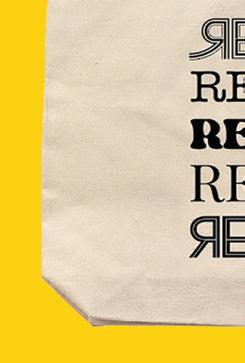









HOME IN


Rent, ownership, and neighborhood struggle since the collapse of public housing

The new book from Chicago Reader’s own Maya Dukmasova

Available in paperback and PDF download
Book Club members receive an additional 10% off at the following stores:
The Book Cellar | 4736 N. Lincoln 60625 773-293-2665 | bookcellarinc.com
Bookie’s | 10324 S. Western 60643 312-890-3860 | bookiesbookstores.com
Bucket O’Blood Books and Records | 3182 N. Elston 60618 312-890-3860 | bucketoblood.com
chicagoreader.com/mayabook

The Dial Bookshop | 410 S. Michigan, 2nd Floor 60605 dialbookshop.com
Madison Street Books | 1127 W. Madison 60607 312-929-4140 | madstreetbooks.com
Pilsen Community Books | 1102 W. 18th St. 60608 312-478-9434 | pilsencommunitybooks.com
Roscoe Books | 2142 W. Roscoe 60618 773-857-2676 | roscoebooks.com
Semicolon | 515 N. Halsted 60642 312-877-5170 | semicolonchi.com
Seminary Co-Op Bookstore | 5751 S. Woodlawn 60637 773-752-4381 | semcoop.com
Volumes Bookcafe | 1474 N. Milwaukee 60622 773-697-8066 | volumesbooks.com
Women & Children First | 5233 N. Clark 60640 773-769-9299 | womenandchildrenfirst.com

This yearlong partnership with independent bookstores is supported by the Poetry Foundation.



Mikki Kendall
Hood Feminism: Notes From the Women That a Movement Forgot
Author Talk: Oct. 22, 2020
Sonali Dev Recipe for Persuasion
Author Talk: Nov. 19, 2020
Riva Lehrer Golem Girl
Author Talk: Dec. 17, 2020
Emil Ferris My Favorite Thing Is Monsters
Author Talk: Jan. 28, 2021
Eve Ewing

1919
Author Talk: Feb. 25, 2021
Nnedi Okorafor Remote Control
Author Talk: Mar. 25, 2021
Natalie Moore
The South Side
Author Talk: Apr. 22, 2021
Rebecca Makkai
The Great Believers
Author Talk: May 26, 2021
Fatimah Asghar
If They Come for Us
Author Talk: June 24, 2021
Presented by:
Kayla Ancrum Darling
Author Talk: July 22, 2021
Jessica Hopper (TBD)
Author Talk: Aug. 26, 2021
Precious Brady-Davis I Have Always Been Me: A Memoir
Author Talk: Sep. 23, 2021
Book Club membership includes: Exclusive access to conversations between Authors and the Reader Discounts to your favorite independent bookstores




A curated monthly newsletter A members-only discussion forum Special offers from Reader partners





Fatimah Asghar is a poet, filmmaker, educator, and performer. Her work has appeared in many journals, including POETRY Magazine, Gulf Coast, BuzzFeed Reader, The Margins, The Offing, Academy of American Poets, and many others. Her work has been featured in outlets like Al Jazeera, Elle, W Magazine, The Atlantic, PBS, NPR, Time, Teen Vogue, Huffington Post, and others. She is the writer and co-creator of Brown Girls, an Emmy-nominated web series that highlights friendships between women of color. In 2017, she was awarded the Ruth Lily and Dorothy Sargent Rosenberg Fellowship from the Poetry Foundation and was featured on the 2018 Forbes 30 Under 30 list. Asghar’s debut book of poems, If They Come For Us, was released by One World/Random House in August 2018 to much acclaim. Along with Safia Elhillo, she is the editor of Halal If You Hear Me, an anthology that celebrates Muslim writers who are also women, queer, gender nonconforming, and/or trans. She is a frequent collaborator with singer/ songwriter Jamila Woods, directing music videos for “Eartha” and “SULA (Paperback).” Asghar directed Jidenna’s “Sufi Woman” as well as wrote and directed her first narrative piece, a short film titled Got Game? that was released in May 2020.

Sujay Kumar is co-editor in chief of the Chicago Reader. He also fact checks for Columbia Global Reports. He previously edited at The Daily Beast, Newsweek, and Fusion.
Presented by:
JOBS
Ann & Robert H. Lurie Children’s Hospital of Chicago seeks Sr. Accountants for Chicago, IL to be responsible for any tech functions of the financial reporting team across multiple entities.
Bachelor’s in accounting +3yrs exp req’d.

Req’d skills: 3yrs w/GL accounting; financial statements reporting; AP; operational & capital budgeting; planning monthly closing process.
1yr exp in each: Excel: Pivot Table, Queries, Trend Analysis; accounting for multiple related entities. Background check & health screen req’d. Apply at careers. luriechildrens.org Tracking code: 2021-15169
Irving Park Family Dentist seeks Dental Directors for various and unanticipated worksites throughout the U.S. Diagnose patients’ dental needs and chart patients’ existing conditions. DDM or DDS + 3 yrs exp as a practicing dentist, including managing root canal treatments & dental implant surgeries req’d. Req’d licenses: IL Dental Licensure, AEGD/ GPR training. 25% travel req’d. Send resume to: I. Bueno, Ref: MY, 3435 W Irving Park Road, Chicago, IL 60618
TTX Co. is seeking a Senior DevOps Engineer in Chicago, IL with the following requirements: Bachelor’s degree in Computer Science, IT or related field and 1.5 years of related experience. Prior experience must include at least 1.5 years with each of the following: Perform continuous integration and automated deployment; develop tools and framework to improve operational efficiency; perform scripting for zero downtime deployments and anomaly detection; design cloud solutions for application high availability and to improve cost e ciency. Apply online at jobs.ttx.com.
Driving with carvertise: Earn monthly income. Earn up to $350 to $1500 each campaign. APPLY WITHIN TO JOIN THE WINNING TEAM. Interested applicant should apply to: gkaggs@mail. com
Nat’l Sales Mgr: Promote/grow sale of Bruno Lafon Selection wines in U.S. to wholesale partners & expand direct sales to beverage retailers & grocery chains nationally. Chicago, IL location. Send resume to: Integrity Wines, LLC d/b/a Bruno Lafon Selection, 41 Madison Ave, FL 31, New York, NY, 10010. Attn: R. Sarrazin.




Binny’s Beverage Depot is the Midwest’s largest upscale retailer of ne wines, spirits, beers and cigars, and due to our continued growth, we are now looking for dedicated individuals to join our team. We are hiring at all 45 stores in the Chicagoland area.
TransUnion, LLC seeks Lead Engineers-Webhosting for various & unanticipated worksites throughout the U.S (HQ: Chicago, IL) to research, evaluate, design & develop web hosting for sw applications.
Master’s in Comp Sci or Comp/Software Eng or Info Systems/any Eng/ related field + 3yrs exp or Bachelor’s in Comp Sci or Comp/Software Eng or Info Systems/any Eng or related field + 5yrs exp req’d. Req’d Skills: Exp w/JEE (Websphere, JBoss, JBoss Portal, Tomcat), Apache, Nginx, HA Proxy, nodeJS, CentOS, Ubuntu, Python, Layer 7, shell scripting, Jython, Python Scripting, Perl, Korn, Jmeter, Jenkins, SoapUI, Grafana, Linux, JMS, Saml, AWS, Docker, Docker Swarm, Openshift, puppet, Ansible, Oracle, DB2, Sybase, postgres, SQL Server, TCP/IP; Introscope, ServiceNow, Remedy, Nagios, Zenoss, Cachpoint, SSO Siteminder, Splunk. Telecommuting permitted. Send resume to: A. Goodpasture, REF: KKM, 555 W Adams, Chicago, IL 60661
TransUnion, LLC seeks Consultants for Chicago, IL location to contribute to the full sw app system life cycle. Master’s in Comp Sci/ Management Info Sys/related field + yrs exp. or

Bachelor’s in Comp Sci/ Management Info Sys/ related field +5yrs exp. req’d. Req’d skills: SQL Server, MySQL, R, SAP Business Objects, Agile, Waterfall, Design Thinking, Iterative Prototyping, PeopleSoft, Java, Tableau, MS Project, JIRA, Autosys. Telecommuting permitted. Send resume to: A. Goodpasture, REF: KM, 555 W Adams, Chicago, IL 60661
Select Minds LLC. seeks Master’s + 1 yr. exp/equiv.: Data Architect (SMDA21) Python, Cobol, CICS, Spark, Mongo, DB2 and Oracle. Mail resume with job ID # to HR:1750 E Golf Rd, Suite 395 C, Schaumburg, IL 60173. Unanticipated work site locations throughout U.S. Foreign equiv. accepted.
TransUnion, LLC seeks Sr. Lead Developers for Chicago, IL location to design, architect & implement sw applications. Master’s in Comp Sci/Comp Eng/any Eng field + yrs exp. or Bachelor’s in Comp Sci/ omp Eng any Eng field + 5yrs exp. req’d. Req’d skills: sw design exp. w/Java (Tomcat, JBoss, Spring, MVC, Spring Boot), JavaScript, CSS, HTML, Front End Web development, JQuery, Node JS, AJAX, Angular or AngularJS, RESTful, Web Server (Apache),
Database (Oracle, PostgreSQL). 20% telecommuting permitted. Send resume to: A. Goodpasture, REF: SP, 555 W Adams, Chicago, IL 60661
TransUnion, LLC seeks Sr. Engineers for Chicago, IL location to be responsible for administering relational databases. Master’s in Comp Sci/Comp Eng/ related field + yrs exp. or Bachelor’s in Comp Sci/Comp Eng/related field +5yrs exp. req’d. Req’d skills: Oracle Exadata, Oracle ACS, Oracle Database Appliances, Oracle Virtual Director, Oracle Data Guard, UNIX shell scripts, RMAN backups, AWR, SPA, ADDM, ASH reports, OEM, DB2, GoldenGate, AWS. Telecommuting permitted. Send resume to: A. Goodpasture, REF: MAM, 555 W Adams, Chicago, IL 60661
TransUnion, LLC seeks Sr. Developers for Chicago, IL location to design & develop software applications. Master’s in Comp. Sci/Applications or Comp Eng./Info. Systems/Info. Tech./ any Eng. or related field +2yrs exp. or Bachelor’s in Comp. Sci/Applications or Comp Eng./Info. Systems/Info. Tech./ any Eng. or related field +5yrs exp req’d. Req’d skills: AbInitio, Metadata
Hub/EME, Agile, Oracle, Unix/Linux, shell scripting, Autosys/Tivoli, SQL Developer. Send resume to: A. Goodpasture, REF: NBA, 555 W Adams, Chicago, IL 60661
Irving Park Family Dentist seeks Dental Directors for Chicago, IL to diagnose patients’ dental needs and chart patients’ existing conditions. DDM or DDS req’d. Req’d licenses: IL Dental Licensure, Controlled Substance Licensure, AEGD/GPR training. Send resume to: I. Bueno, Ref: AH, 3435 W Irving Park Road, Chicago, IL 60618
Manager, Huron, Chicago, IL: Identify, assess, & solve complex bus. prob. for integ. Workday cloud app w/ external apps across a wide array of HCM, Financial, & Acad. func. areas, where analysis of situations or data req. an in-depth eval. of var. factors. Must have MS+2 yrs or BS+5 yrs in Comp. Sci., IS, or rel. & exp. w/: i. integ. & people lead roles w/ in tech. workstreams of 1+ HCM or Financials implement. for at least 2 phases; ii. Healthcare/ Higher Ed client work; iii. current Workday Integ. & Studio Cert.; iv. dvlpmnt &/or architect. of integ. tech., incl. web services (REST &/or SOAP), XML, XSLT, & Workday Stu-
dio; v. scope & rqrmnts def., prob. solving, & process imprvmnts; vi. estimating, implement. planning, & proj. mgmt; vii. manag mult. proj. of dif. scale & duration; & viii. sftwr tools such as Notepad++, UltraEdit, Oxygen XML, & ASAP Utilities. Up to 80% travel to unanticipated worksites throughout US. Telecommuting allowed when not traveling. Mail resumes to: Amanda VanDrew, Mobility Associate, Huron, 550 W. Van Buren St., Ste. 1700, Chicago, IL 60607. Senior Manager, Digital Operations & Monitoring (Foot Locker Corporate Services, Inc.) (Chicago, IL): Manage a team of business ops & app support engineers to ensure incidents are addressed w/in service level objectives (SLOs) & w/ appropriate urgency. Enforce industry-standard best practices for handling major incidents, incl call management, scribing/documenting actions, & communicating w/ stakeholders. Requires a bachelors degree or foreign equiv in computer apps, information technology, or a related field. Reqs 5 yrs of progressively responsible experience working w/ large scale business & e-commerce apps. Experience must incl: Utilizing software


Full-Time and Part-Time positions available in the below locations: Lincoln Park • Lakeview • Portage Park Logan Square • Hyde Park • Evergreen Park
Perform a variety of store functions. Quali ed persons must be over 21 years of age, able to lift 4050 lbs. and available to work exible hours. Previous retail experience a plus, with cashier or stock experience preferred. Candidates must be able to work nights & weekends.
River Grove
We are currently seeking a quali ed individual for the position of Customer Service Manager. The candidate is focused on the customer experience through active supervision and enhancing the service culture. The Customer Service Manager also provides a strong leadership presence and control in the store, while enforcing all company policies and procedures, including, safety and security.
In return for your skills, we o er growth opportunities and attractive compensation.



Please apply online at
www.binnys.com/careers
development & system testing tools incl Splunk, Big Panda, Dynatrace, JSON view, Postman, & Jenkins; Working w/ e-commerce platforms incl Websphere, Hybris, ATG, & Magento; Developing monitoring scripts & business reporting tools for use in e-commerce websites; Developing business reporting systems for root cause analysis & incident management. Send resumes via e-mail to jobkeeper@ footlocker.com, subject line must provide Code SMDOMIL7064, or by mail to Foot Locker Corporate Services, Inc., Attn: M. Grund, Global Mobility Specialist, Code SMDOMIL7064, 330 W 34th St, NY, NY 10001.
The Northern Trust Company seeks a Manager, Applications to work with technical and functional teams to identify business needs and develop conceptual systems design. Coordinate with systems team on the implementation and impact of systems enhancements to existing designs. Develop periodic goals, organize work by setting priorities, and ensure timely completion of technical projects. Provide technical solutions to support project metrics, management status, or other reporting needs for projects. Work with various business units, vendors, consultants, and clients to identify automation opportunity and measures to improve applications stability, availability, and productivity. Position requires a Bachelor’s degree in Computer Science, Engineering, Information Systems, or a related STEM field, followed by 5 years of progressively responsible experience with computer systems and applications design, development, testing, and implementation. Experience must include a minimum of: 5 years of experience with ensuring technical compliance with all audit requirements, including change control procedures and data security; 5 years of experience with defining and reviewing service level agreements (SLAs) to ensure technical requirements for business units are met; 5 years of experience with maintaining technical support for the risk management and compliance programs; and 5 years of experience with Agile methodology, C, C++, C#, Cognos, DAO, HTML, JSP, MS Access, ODBC, Oracle, SQL Server, SQL Plus, TM1, VB, and VBA. Job location: Chicago, IL. To apply, please visit
https://careers.northerntrust.com and enter job requisition number 21039 when prompted. Alternatively, please send your resume, cover letter, and a copy of the ad to: S. Saultz, 2160 E. Elliot Road, Tempe, AZ 85284.
The Northern Trust Company seeks a Senior Consultant, Applications to design, build, and test software applications and solutions. Define technical system requirements for complex data processing and software development projects. Collaborate with cross-functional users to analyze business needs, create prototypes, and develop user-friendly software applications. Test and maintain computer programs, including designing, coding, and debugging. Conduct feasibility studies and design system requirements for complex data processing projects. Perform strategic planning and long-range direction for technology usage and enhancements across the business units.Position requires a Bachelor’s degree in Computer Science, Electrical Engineering, Information Systems, or a related STEM field, followed by 5 years of progressively responsible experience with software design, development, testing, and implementation. Experience must include a minimum of: 5 years of experience with requirements definition; 5 years of experience with coding and debugging software applications; 5 years of experience with capturing business requirements and transforming requirements into technical specifications; 5 years of experience with conducting feasibility studies for complex data processing projects and preparing project phase reports; 5 years of experience with programming techniques including Algorithms, Batches, Change Handler, Maintenance Extensions, ORMB Billing/Payment, Service Programs, and User Exits; and 5 years of experience with Angular JS, Hibernate, Java, J2EE, Oracle RMB, OUAF Framework, Scripting, TOAD, Web Service Adapter, and XAI services. Job location: Chicago, IL. To apply, please visit https://careers.northerntrust.com and enter job requisition number 21038 when prompted. Alternatively, please send your resume, cover letter, and a copy of the ad to: S. Mohan, 50 S. LaSalle St., Chicago, IL 60603.
Sr .Net Engin - Comcast Cable Comm, LLC, Chicago, IL. Create custom SW products for Freewheel to support advrtise platfrm. Reqs: Bach in CS, Engin, or rltd & 5 yr exp design, dvlp & maintain SW in Agile environ use C#, JavaScript, jQuery, Github, SQL Server, HTML, CSS & RESTful web service; write testable code; of which 3 yr incl use Entity Framework or ORM Lite; create modular code use IOC Container; & use CI/CD tools. Apply to: Denise_Mapes@cable. comcast.com. Ref Job ID# 9851.
Adeptia, Inc. seek Software Developers for Chicago, IL location to design sw solutions. Master’s in Comp Sci/ related field +2yrs exp OR Bachelor’s in Comp Sci/related field +5yrs exp req’d. Req’d Skills: Exp in design of unit test cases & performance of unit test cases; writing complex database queries; data mapping; data transformation; process flow design; solution architecture; sw installation in Windows & Linux; Java; XML; xpath; xslt; JMS; RDBMS; SQL; SQL Server; MYSQL; HSQL; SQL Procedures; Oracle; Tomcat; AS2; VAN; SFTP; FTPs; PGP; OFTP; Connect Direct; HTML5; CSS3; Shell Scripting; Javascript; ExtJs; EDI X12; EDIFACT; XQuery; XSL-FO; XSD; SharePoint; DFS; Eclipse; Putty. Travel req’d up to 10%. 40% telecommuting permitted. Send resume to: HR.US@ adeptia.com RF:MN.
Bounteous, Inc. seeks Adobe Campaign Architect in Chicago, IL to spprt mrktng tchnlgy implmntn prjcts & ongoing clnt mrktng cmpgns wthn Adobe Campaign. Telecommuting from anywhere in the U.S. is acceptable.. Upld CV & cvr lttr to https://www. bounteous.com/careers/, ref#rxybru
Software Developer II, Itasca, IL: Research, design, implement & manage software programs. Test & evaluate new software programs. Work w/ Orca, Super Orca, Tidal Beyond Compare, Lean FT, Notepad++, Angular JS, AJAX, CSS, HTML, C#, Business Rules, Client Scripts, Design Patterns, MVC, Factory, UI Action, Intune, ServiceNow & UI Policies as req’d. Travel/reloc to various unanticipated locations. Telecomm permitted. Send res to: Prorsum Technologies, Inc., 650 E Devon Ave, Suite 175, Itasca, IL 60143.
The Department of Orthodontics, at the Univ of IL at Chicago, located in a large metropolitan area, is seeking a full-time Assistant Professor (CT) with the following responsibilities: Under direction and supervision, teach and train in General Dentistry and Orthodontics Specialty. Provide teaching and instruction services to post-doctoral students in both preclinical and clinical aspects of Orthodontics. Participation in faculty and course/ curriculum activities, lecturing in continuing education courses, participation in medical science research activities related to Orthodontics, and publishing in premier publications. Assist department with administrative duties and University service as assigned. Requires a DDS or DMD degree or its foreign equivalent in Dentistry or related field of study, 2 yrs or Orthodontics residency training, 2 yrs of teaching bioprogressive orthodontic therapy, and a valid Illinois dental license. Some travel may be required for conference and other professional development activities and/or to give presentations at departmental CE courses. For fullest consideration, please submit CV, cvr ltr, & 3 references by 06/27/2021 to Anna Panova, Dept of Orthodontics, 801 S Paulina St, Chicago IL 60612 or via email to annap22@ uic.edu. UIC is an Equal Opportunity, Affirmative Action employer. Minorities, women, veterans, & individuals w/ disabilities are encouraged to apply. UIC may conduct background checks on all job candidates upon acceptance of a contingent offer letter. Background checks will be performed in compliance with the Fair Credit Reporting Act.
Groupon, Inc. is seeking a Director of Business Project/ Program Management in Chicago, IL w/ the following responsibilities: Advance organization & corporate priorities & ensure business results are delivered & goals are set for departments & individual managers; ability to design & fully implement operating frameworks to connect & work across functions (Sales, Merchandising, Editorial, CS, Product, Finance, Risk management). Up to 30% international travel reqd. Apply at www. grouponcareers.com by searching keyword R24903
Transact’n Advs’ry Srvcs Supvsr – (Chicago, IL) RSM US LLP: Prep, exmn & anlyze clnt accnt’g recds & fin. stmnts, ensur’g complnce with fdrl & state reg’ltns. Reqs: Bach’s in Accnt’g, Fin or rltd fld; 2 yrs’ exp as Ass’nce Assoc, Sr. Assoc. or a rltd pos & incl: Rev & ver’fy val’n of Pvt Eqty portf’lio comp invstmnts incl anlyz’g compr’ble comp fin’ls, EBITDA mltple inputs, & validat’g Disc’nted Cash Flow mdls against audit’d financ’l data; Ld financ’l rprt’ng intern’l cntrls & proc assessm’ts for Prvt Eqty firms, identify’g & dcmnt’g deficienc’s & depart’s from GAAP; Cmplte rotat’ns in Spcltst Financ’l Accnt’g Advis’ry & Anti-Mny Lnder’ng (AML) grps at a Big Four firm, advis’g on GAAP to IFRS cnvrgnce, CECL, Debt or Eqty trtmnt of putt’ble warr’nts, & perform’g cust’mr due dilg’nce on AML bnk’ng custmrs. May be req. to wrk at vari’s locat’ns thrgh’t the U.S. May req up to 25% trvl. Mail res. to: Attn: C Volkening –Ref # 2098, 30 S. Wacker Dr, # 3300, Chicago, IL, 60606
Manager, Core Services
API (Foot Locker Corporate Services, Inc.) (Chicago, IL): Manage software development teams in the blding of Foot Lockers core services, software tools, & app services. Coordinate with Senior Operations Manager & Technical Director to define & enhance app programming interface (APIs) for different core services developmental projects incl the utilization of MySQL, Mongo, & Cassandra for app development. Reqs a Bachelors degree or foreign equiv in computer sci, computer engineering, info technology, or a related field. Requires 5 yrs of progressively responsible experience working w/ large scale retail business & customer experience apps. Experience must incl: Developing & maintaining restful APIS through API gateways w/ high availability; Experience w/ identity & access management, SSO, & federation protocols, such as OAuth, OpenID Connect, SAML, & LDAP; Implementing service transformation, routing, enrichment & orchestration in WSO2; Implementing api versioning strategies to adopt API lifecycle processes; Experience w/ Agile Methodology (extreme programming), Test-Driven Development (TDD) & pair programming concepts; App performance
tuning & monitoring using Dynatrace, New Relic & Nagios. Send res via e-mail to jobkeeper@ footlocker.com, subject line must provide Code MCSAIL3915, or by mail to Foot Locker Corporate Services, Inc., Attn: M. Grund, Global Mobility Specialist, Code MCSAIL3915, 330 W 34th St, NY, NY 10001.
ENGINEERING: The Mill Group, Inc. seeks Senior Engineer to work in Chicago, IL. Ensur that techncl resrcs are maintned & workng to optimum capacity while delivrng a resrch & dvlpmnt, implementatn & maintenanc plan for all video equipmnt. Degree & commensurate exp. req’d. Must be willing to travel domstclly & interntnlly 10% of time. Email resume to ny. recruitment@themill.com w/ sbjct: Sr Engineer.
Peak6 Group, LLC seeks Sr. Software Development Engineer in Chicago, IL to anlyze, devlp & implement financial industry app software. Reqs. Bachelor’s or foreign equiv in Software Eng., Mechatronics Eng., or rel. Engineering field + 5 yrs. post-baccalaureate exp. as Test Automation & Verification Engr., or rel. role. Exp. must incl. regression test automation framework development, mechanical & electronic schematic interpretation, AWS, MongoDB, Cassandra, Gatling perf. testing, H.264, Grafana, Prometheus & ELK stack. Mail resume: Peak6 Group, LLC c/o C. Schroeder 141 W. Jackson Blvd., Ste. 500, Chicago, IL 60604
A.V.W. Equipment Co., Inc, is seeking ERP System & Production Manager to develop/ plan/ implement Enterprise Resource Planning (ERP) JobBoss system in Maywood, IL. Will set deadlines/assign responsibilities /monitor progress for the ERP system; evaluate/recommend changes to current/future ERP system requirements to meet organizational needs; lead implementation of new organization processes aligned with ERP configuration. Will develop machining processes/ programs/documentation for CNC machining centers; write/optimize programs for multi-axis CNC equipment; create/ update documentation; analyze/optimize machining cycles; provide cycle time information; participate in new product development process. Will manage subordinate staff in day-to-day
performance. Requires Bachelor’s Degree in Mechanical Engineering or related (foreign degree or equiv. acceptable) with 1 yr. exp. (educational or professional) with G & M code for CNC Machinery. Must be able to read/ write/speak in Serbian language. Send cover letter/resume to: A.V.W. Equipment Co., Inc., Attn: John Plavsic, 105 S. Ninth Avenue, Maywood, IL 60153.
Business Systems Support Technician: Provide internal IT support & maintenance to ensure quality & security of IT systems. West Dundee, IL location. Reqs MS in Network Tech & Mgmt & 2 yrs exp as Sr Support Tech. Send resume to: Renishaw, Inc. 1001 Wesemann Dr, West Dundee, IL, 60118. Attn: M. Tures.
Have you had an unwanted sexual experience since age 18? Did you tell someone in your life about it who is also willing to participate?
Women ages 18+ who have someone else in their life they told about their experience also willing to participate will be paid to complete a confidential online research survey for the Women’s Dyadic Support Study. Contact Dr. Sarah Ullman of the University of Illinois at Chicago, Criminology, Law, & Justice Department at ForWomen@uic.edu, 312-996-5508. Protocol #2021-0019.
1 Room for Rent: Logan/Lincoln Park - $535. 2 Roommates (male-27, female-29), laundry, blue line, sunny backyard, no dogs/cats, Available June 1. bethchinmusic@gmail. com

Sunny Andersonville large, two BR, modern kitchen/bath, private balcony, natural wood, mini blinds, hardwood floors, washer/dryer, garage option, no dogs. $1245. 708-482-4712
Create a Better Life for Yourself and Help Others Do the Same. Call or Text (302) 2688006 or Visit: www. LAVDirect.com Referral code- 814246. stevensjoseph2011@ hotmail.com
CLEANING SERVICES
CHESTNUT ORGANIZING AND CLEANING SERVICES: especially for people who need an organizing service because of depression, elderly, physical or mental challenges or other causes for your home’s clutter, disorganization, dysfunction, etc. We can organize for the downsizing of your current possessions to more easily move into a smaller home. With your help, we can help to organize your move. We can organize and clean for the deceased in lieu of having the bereaved needing to do the preparation to sell or rent the deceased’s home. We are absolutely not judgmental; we’ve seen and done “worse” than your job assignment. With your help, can we please help you? Chestnut Cleaning Service: 312-332-5575. www. ChestnutCleaning.com
Inside insight LaGaGa was seen with Tracy Guns & Britney Beach Spears at the World party. We laugh when M. Crew, B. Sabbath, Aerosmith, ACDC where telling jokes. Bieber came with Blake & Gwen What a fun night. Buy CD’s. Guns N Roses. Love Hollywood Rose GNR reports Rock Star Bunny text
Danielle’s Lip Service, Erotic Phone Chat. 24/7. Must be 21+. Credit/ Debit Cards Accepted. All Fetishes and Fantasies Are Welcomed. Personal, Private and Discrete. 773-935-4995
EROTIC PHONE CHAT Sexy Singles, Sweet Coeds, Hipster Gals. Only .99c. 800-Sexy Gal; 800-739-9425.
HARDCORE ADULT
TALK! Busty Babes, Ebony Hotties, Older Ladies. 866-515-3699, only $10 per call.






































